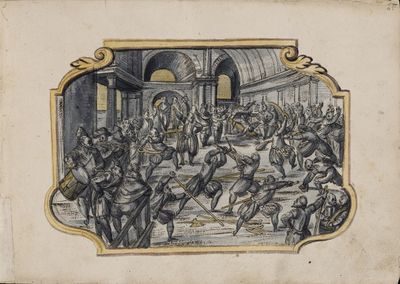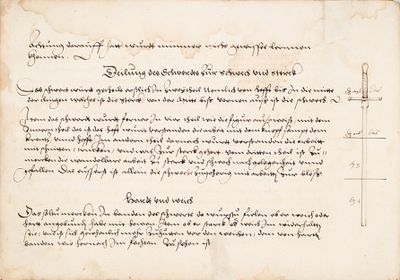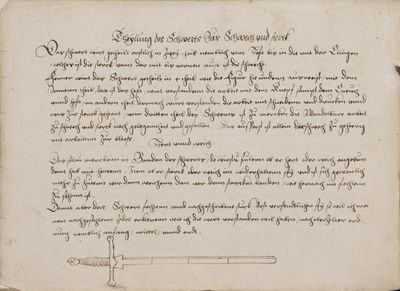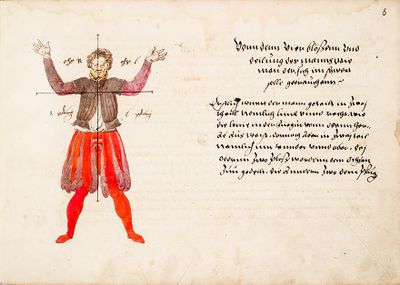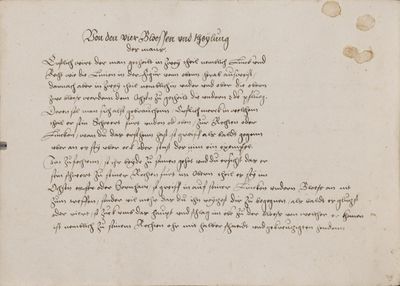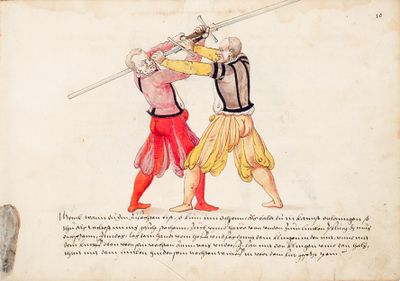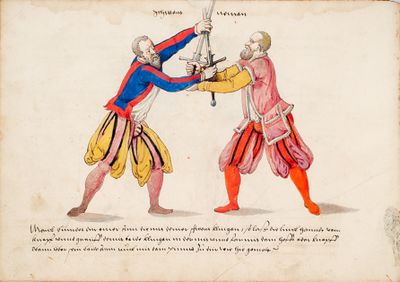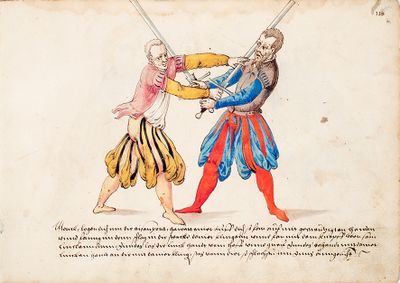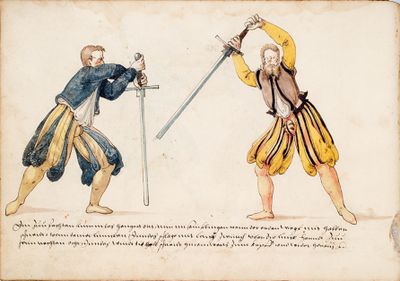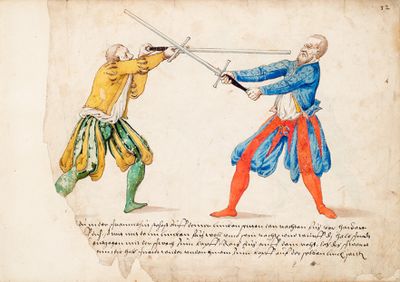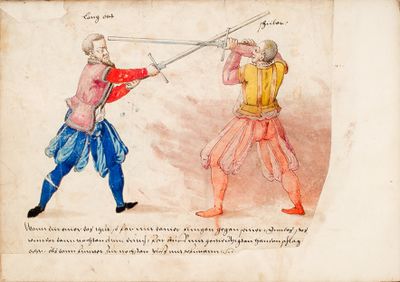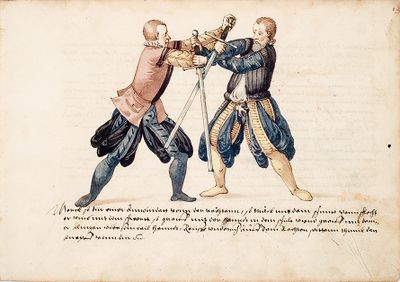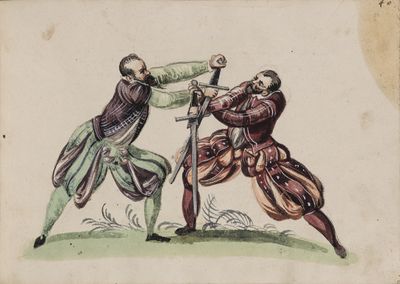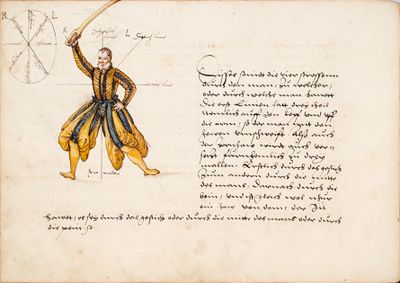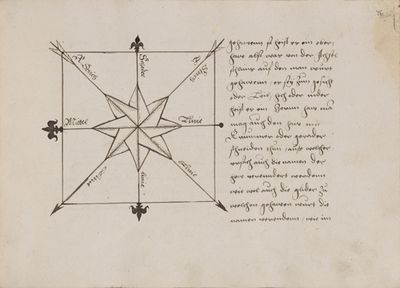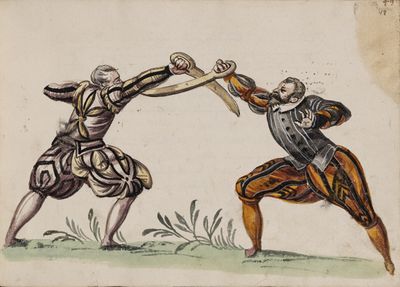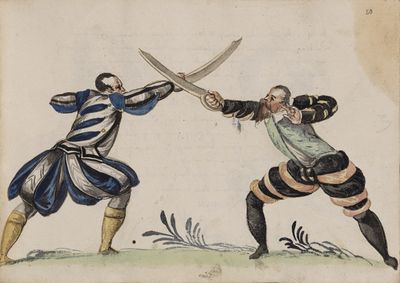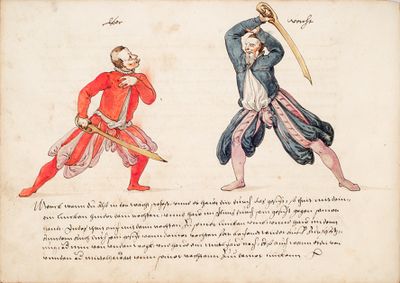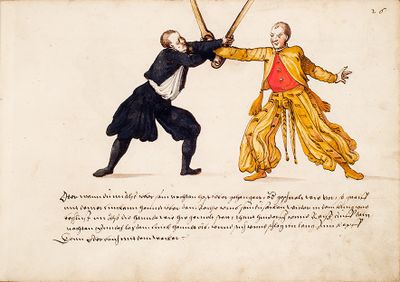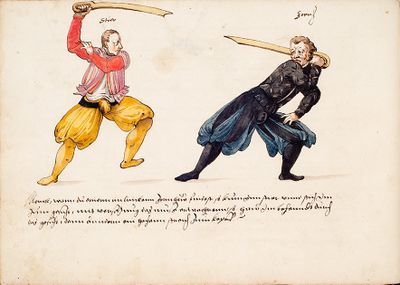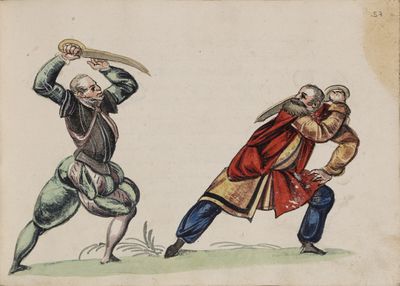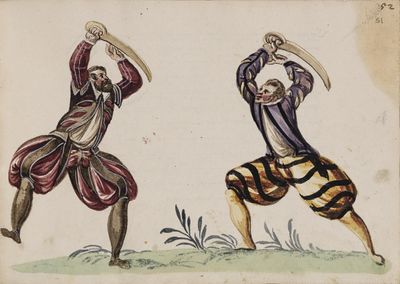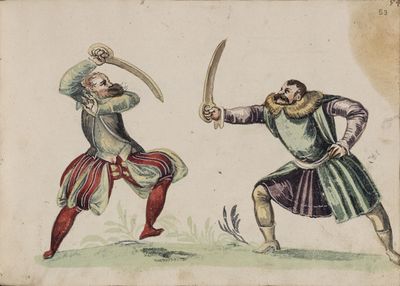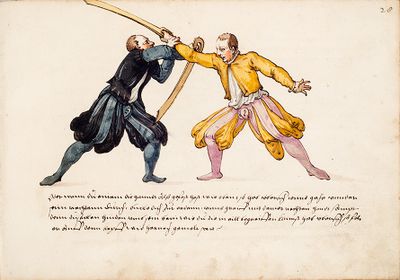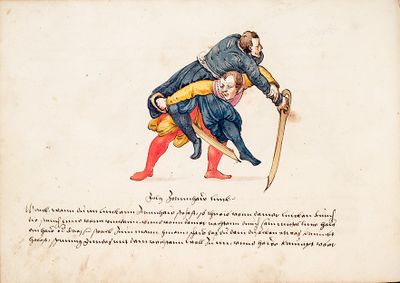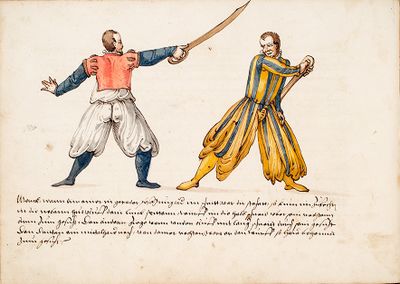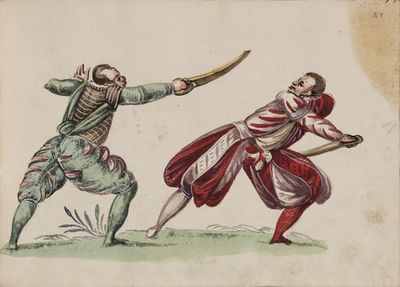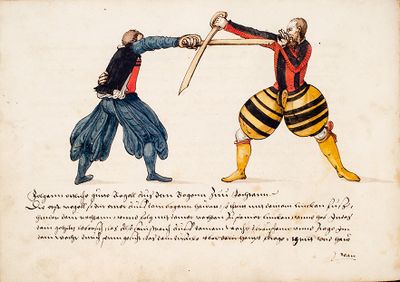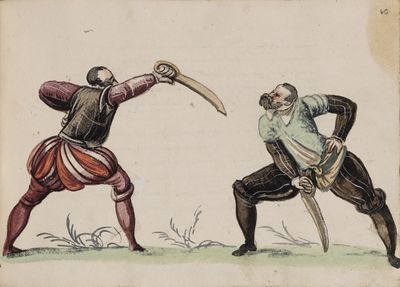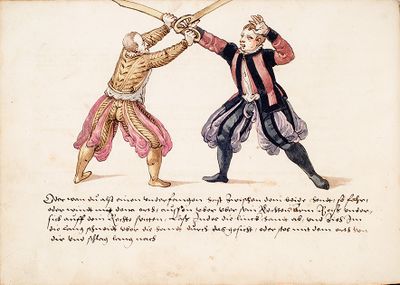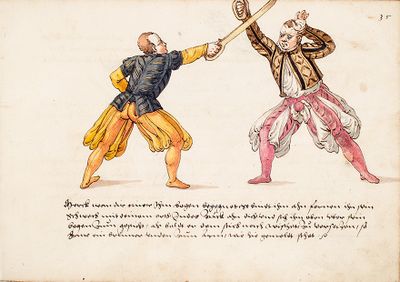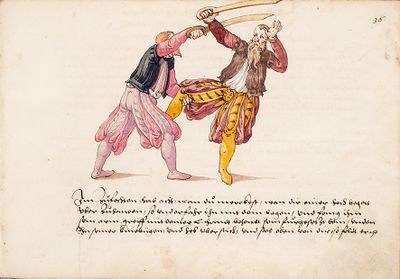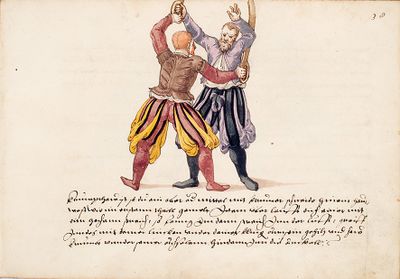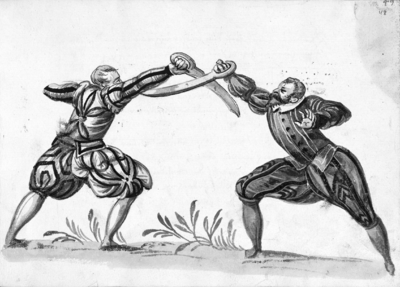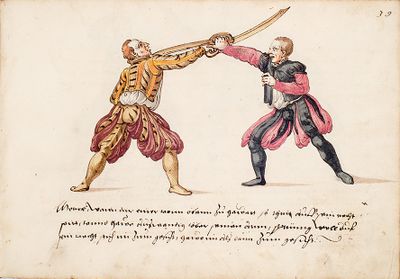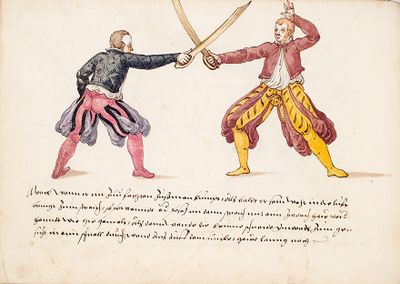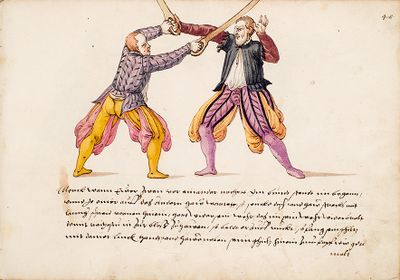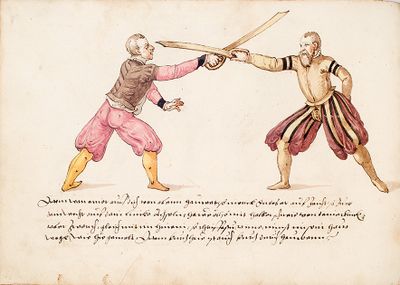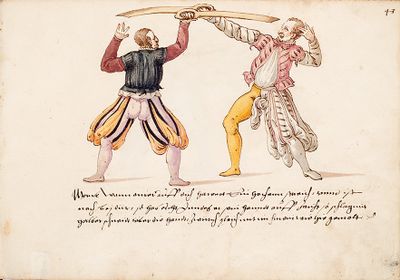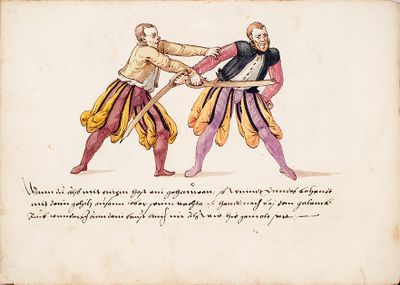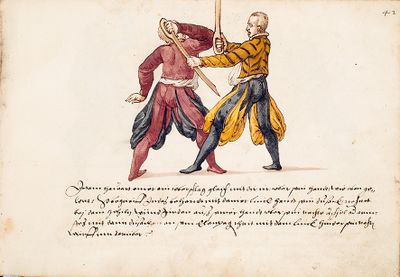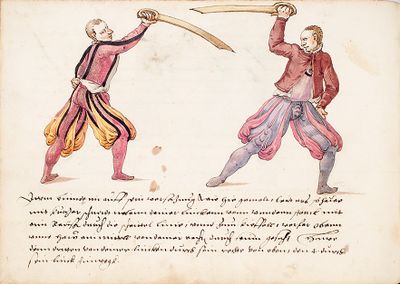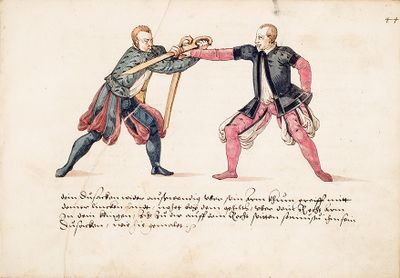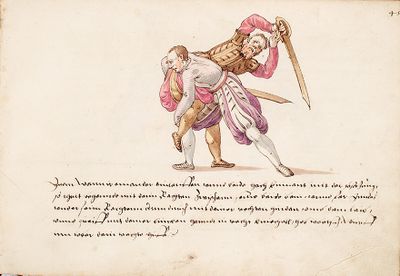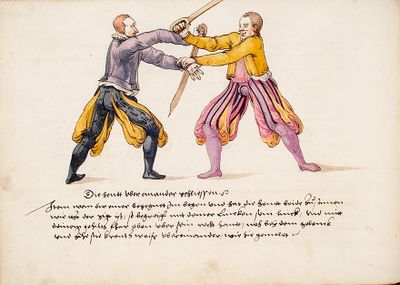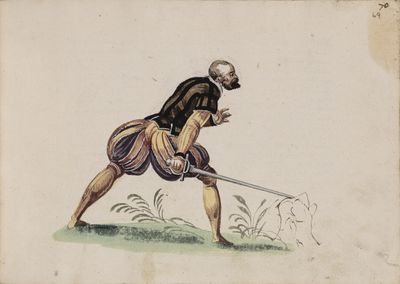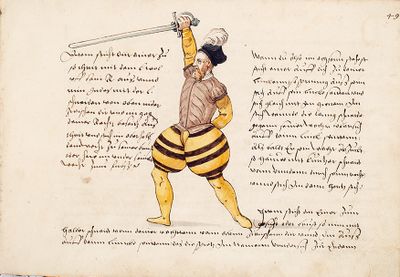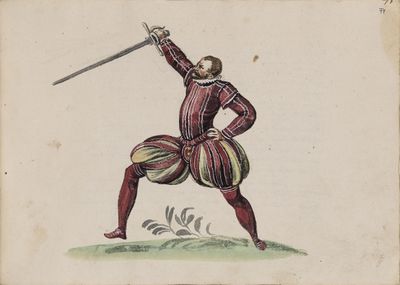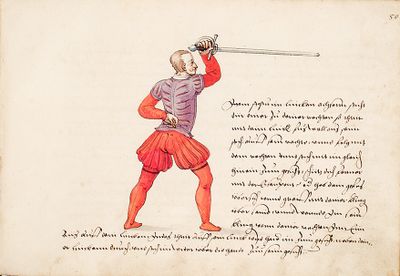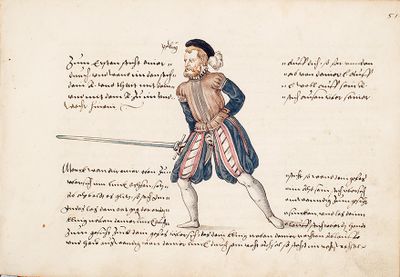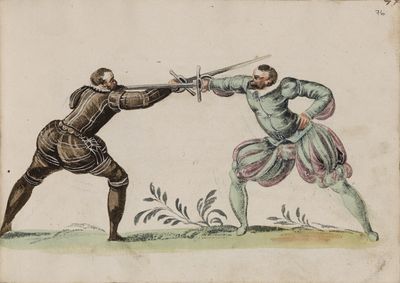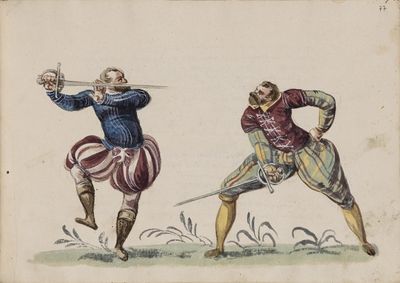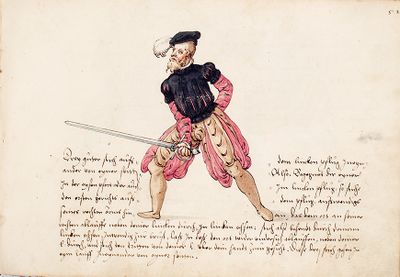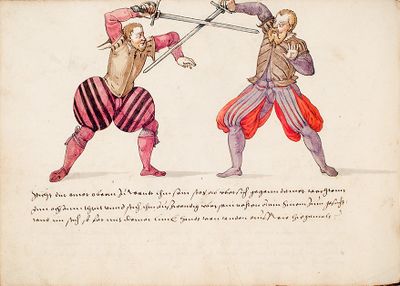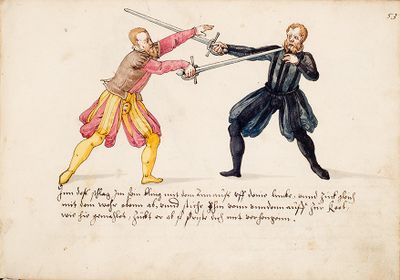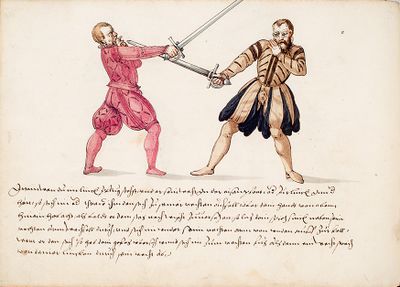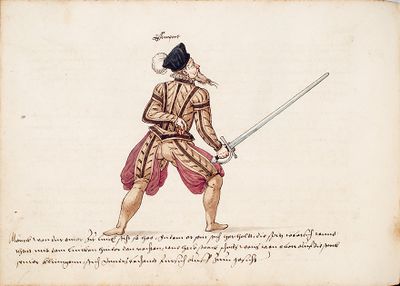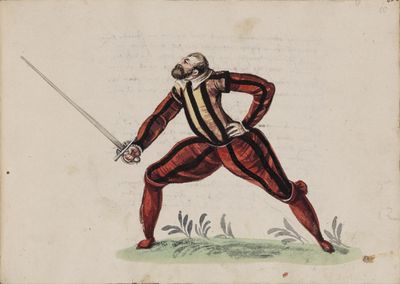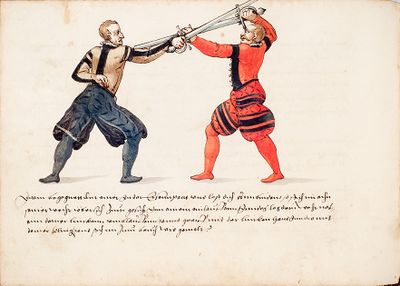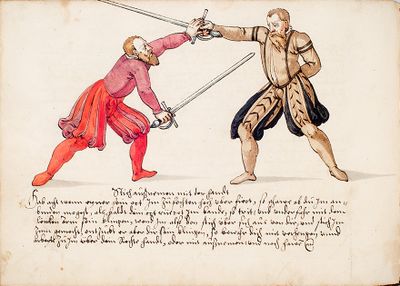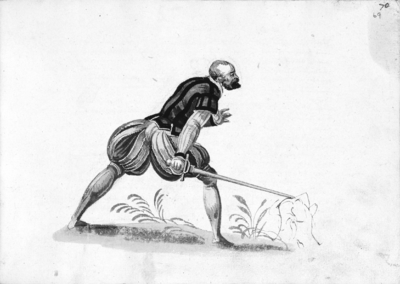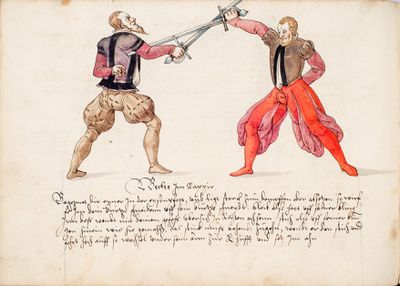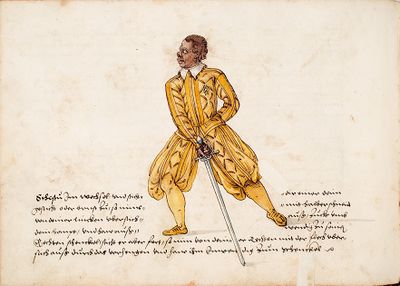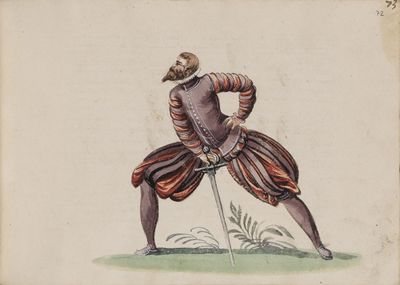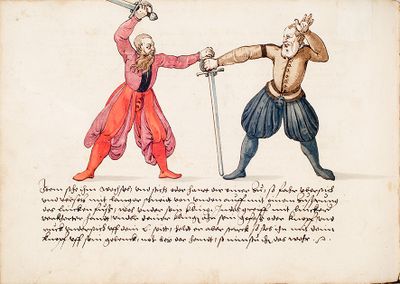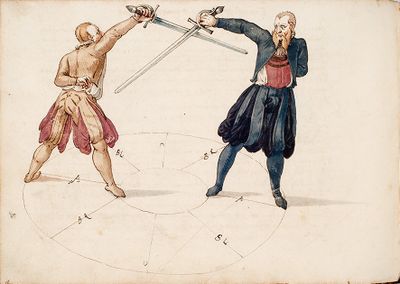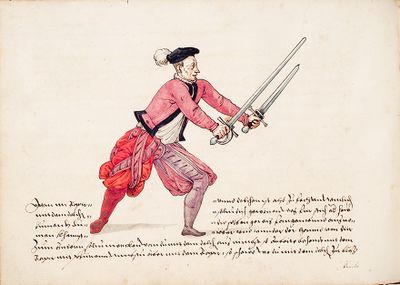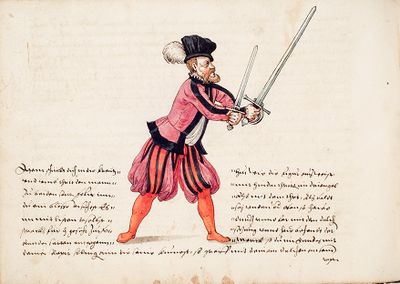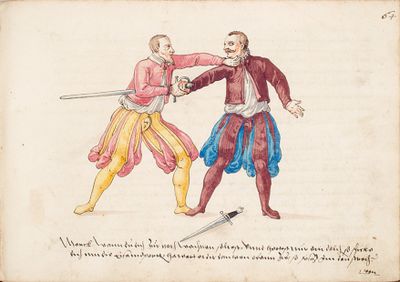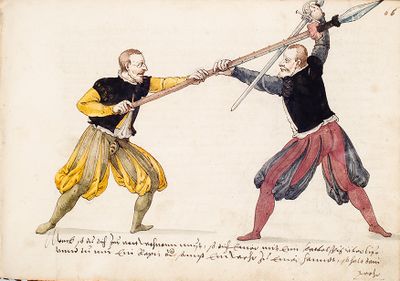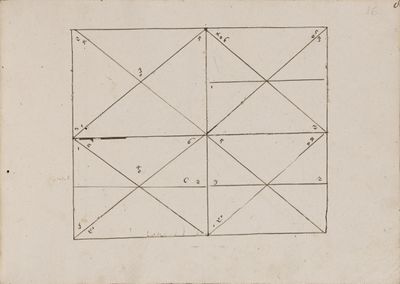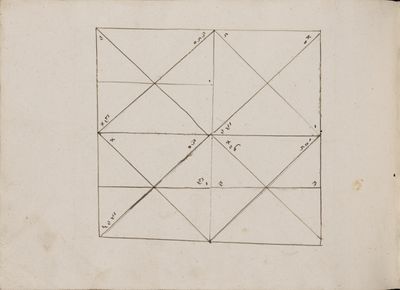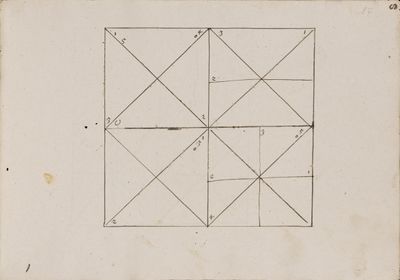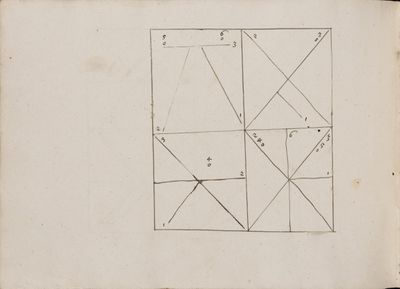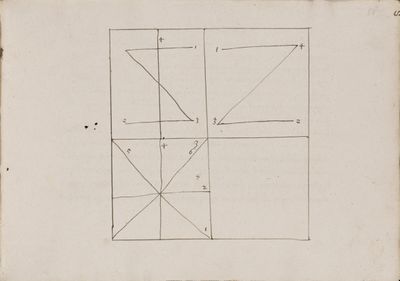|
|
You are not currently logged in. Are you accessing the unsecure (http) portal? Click here to switch to the secure portal. |
Difference between revisions of "Joachim Meyer/Manuscript Comparison"
| Line 1: | Line 1: | ||
<div style="max-width: 180em;"> | <div style="max-width: 180em;"> | ||
| − | The Lund or Solms manuscript, created some time in the 1560s, borrows the bulk of its contents from the earlier Munich or Veldenz manuscript of 1561 | + | The Lund or Solms manuscript, created some time in the 1560s, borrows the bulk of its contents from the earlier Munich or Veldenz manuscript of 1561, or rather Meyer clearly used the same rough draft to create both manuscripts. In fact, where the Munich has a large amount of unique content, the Lund has only a few sequences that don't derive directly from it, including the ''balgen'' ("brawling") teaching at the end of the rapier and the commentary on Meyer's ''Freyfechter Zedel'' for the sword—though this is also found in the 1570, and is in essence a rewrite of Part Two of the Munich's sword section. |
In this table, the Munich is treated as the primary text and given priority of sequence whenever possible. The Lund's unique text is placed wherever makes the most sense based on its own internal logic and the overall sequence of ideas. [[Kevin Maurer]] found a lot of these overlapping plays when he was writing his translation of the Munich (and his footnotes are preserved in the translation to note his ideas), and I discovered others as I made this concordance. | In this table, the Munich is treated as the primary text and given priority of sequence whenever possible. The Lund's unique text is placed wherever makes the most sense based on its own internal logic and the overall sequence of ideas. [[Kevin Maurer]] found a lot of these overlapping plays when he was writing his translation of the Munich (and his footnotes are preserved in the translation to note his ideas), and I discovered others as I made this concordance. | ||
Revision as of 00:55, 13 April 2024
The Lund or Solms manuscript, created some time in the 1560s, borrows the bulk of its contents from the earlier Munich or Veldenz manuscript of 1561, or rather Meyer clearly used the same rough draft to create both manuscripts. In fact, where the Munich has a large amount of unique content, the Lund has only a few sequences that don't derive directly from it, including the balgen ("brawling") teaching at the end of the rapier and the commentary on Meyer's Freyfechter Zedel for the sword—though this is also found in the 1570, and is in essence a rewrite of Part Two of the Munich's sword section.
In this table, the Munich is treated as the primary text and given priority of sequence whenever possible. The Lund's unique text is placed wherever makes the most sense based on its own internal logic and the overall sequence of ideas. Kevin Maurer found a lot of these overlapping plays when he was writing his translation of the Munich (and his footnotes are preserved in the translation to note his ideas), and I discovered others as I made this concordance.
The objective of this concordance is to capture the direct textual borrowing between the manuscripts. There may well be places where the same action is described using different words, and those will remain on separate lines. In a few places, the text of the Lund is different from the Munich but describing the same named technique, and so the Lund is placed alongside the Munich in grey text for comparison (in addition to being listed separately). I've added further explanation in a few footnotes here and there, which you can distinguish from Kevin or Olivier's notes by my initials (MCC) at the end.
Only the Sword, Dusack, and Rapier appear below. Since the dedications are different (though equally obsequious), they are not included here. The dagger, polearm, and armored sections are unique to the Munich, so they are also omitted.
These columns can be sorted according to one manuscript or the other by clicking the two triangles to the right of each column header. To refert to the original sequence after sorting, refresh the page. A future version of this page might include controls to reveal or hide specific columns, but for now, it should be fairly easy to navigate without that. I might also eventually replace the separate manuscript listings on the main Meyer page with this table.
Contents
Sword
Illustrations (from the Munich) |
Illustrations (from the Lund) |
Munich Manuscript (1561) |
Lund Manuscript (1563-8) | ||
|---|---|---|---|---|---|
[1] Firstly will each one of the actions in Fencing be divided into three parts which are particularly good to note. Attacking, following after, withdrawal or ending, then to the first in the onset send your attacks through the guards and cuts like they follow afterwards here, however to the other parts and the middle work, this will be reprinted with the handworks, and a mixture of convenient cuts. And lastly to the ending, or the withdrawal, how orderly each one will hereafter be diligently written and taught. |
[1] Sword Fencing Firstly will each one of the actions in Fencing be divided into three parts which are particularly good to note. In the Sword this is namely attacking, followed by the withdrawal or other than to the first to reach it, send your attacks through the guards and cut like they follow afterwards here, however to the other parts and the middle work, this will be reprinted with the handworks, and a mixture of convenient cuts. Onwards to the last, or the withdrawal, how orderly each one will hereafter be diligently written and taught. |
[1r.1] Zum Ersten wurdt ein Ider gang Im Fechten getheilt In drej theil, welches sonderlich wol zumercken ist Nemlich Angreiffen, Nachvolgen, Abziehen oder enden. Als zum Ersten Im zugang geschicht der Angriff durch die leger vnd haw, wie sie hernach volgen werden. Im andern theil aber, vnd Mittel arbeit, wurdt nachgedruckt mit der Handt arbeit vnd vermischung füglicher haw, vnd zum letzsten das Enden vnnd abziehen wie ein Jedes ahn seinem Orth fleissig hernach beschriben vnd gelertt wurdt. |
[6r.1] Schwert Fechtenn Erstlich wirt ein jeder gang in fechtenn getheilt in drey theil welches sonderlich wol zu mercken ist in schwerdt, nemblich angreiffenn nachfolgenn, abzihenn, oder enden als zum erstenn in zugann, geschicht der angruff durch die leger unnd haw wie sie hernach folgen werdenn, in andern theil aber und mitler arbeit wirdt nachgedruckt mit der handtarbeit, und vermischung fuglicher hew. Weiter zum letsten das enden oder abzihenn wie es ordentlich ein jeder am seinem orth hernach fleissig beschribenn unnd gelehrt wurt. | ||
[2] Further, you should note the Before and After, Weak and Strong. The Before is when you drive with your Stücken so that he cannot come to his senses, especially by positioning yourself as close as he is, and how he defends before your Stücken and these same wants to break and bar, with this, he runs off the Before to you. The After is, when you have been rushed upon by your opponent how it is reported above. Thus you should respond Indes quickly with convenient work, with this, you are strongest on his Stücken, when you go on with your work in the Before, and in this you are crowded so that you must displace him After, thus is a constant changing with the Before and After, now you have it, then he does, but he who does not pay attention to it, he will never learn to fence. |
[2] Secondly one should note the Before and After, Weak and Strong. The Before is when you drive with your Stücken so that he cannot come to his senses, especially by positioning yourself close, and how he defends before your Stücken and these same would like to break and bar, with this, he runs off the Before to you. The After is, when you have been rushed upon by your opponent how it is reported next and above. Thus you should respond Indes quickly with convenient work, with this, you are strongest on his Stücken, when you lay on with your work in the Before, and in this you are crowded so that you must displace him after, thus is a constant changing with the Before and After, now you have it, then he does. But he who does not pay attention to it, he will nonetheless never learn to fence. |
[1r.2] Weitter sol man mercken vff das, vor, vnd Nach, schwech, vnd Stercke, Das vor ist so du den man mit deinen stucken dahin treibest, das er zu seinem furnhemen nit khan khommen, sonder mit versetzen sich engsten, wie er sich vor dir schitzen, deine stuck brechen, vnd sperren moge, damit er dir das, vor, ablauffe. Das nach ist, wan du also von deinem gegen man vber eylt wurst, wie oben gemeldt so soltu Indes behendt mit füglicher arbeit Im begegnen, damit du Ihn steckest In seinen stucken vnd also mit deiner arbeit, Ihm das, vor, abiagest, vnd ihn also tringst dir zu versetzen Im, Nach, Also ist ein stetter Wechsel mit dem Vor, vnd mit dem Nach, das es itst disser, dhan Jenner hatt, welcher auch nit [1v.1] Achtung darauff hatt wurdt nimmer nichs gewisses lernnen khennen. ⁋ |
[6r.2] Zum andern sol man mercken auf das vor, und nach, schweche und stercke. Das vor ist so du den man mit deinen stuckenn dohin treibest das er zu seinem furnemen nicht khomen kan, sonder mit versetzenn sich engstenn wie er sich vor deinem stucken schutzen und dieselbenn brechen unnd sperrrenn muge, domit er dir das vor, ablauffe. Das nach ist, wan du also von deinem gegenman ubereilt wurst wie negst oder obenn gemelt, so soltu indes behendt mit fuglicher arbeit, in begegnenn, domit du in steckest in seinenn stuckenn, und also mit deiner arbeit in das vor ab jagest und in also tringest dir zu versetzenn in nach. Also ist ein steter wechsel mit dem vor unnd nach, das es jetzt disser dann jener hat, welcher auch nicht achtung darauff hot, wirdt nimmer nichts gewisses lernen fechten. | ||
[3] Divisions of the sword to the Weak and Strong The sword is firstly divided in two parts, namely from the grip to the middle of the blade which is known as the Strong, from the middle to the most forward, is the Weak. |
[3] Divisions of the sword to the Weak and Strong The sword is firstly divided in two parts, namely from the grip to the middle of the blade which is known as the Strong, from the middle to the most forward, is the Weak. |
[1v.2] Teilung des schwerdts zur schwech und sterck Das schwert würdt getheilt erstlich in zwey theil Nemlich von hefft bis In die mitte der clingen welches ist die sterck, von der Mitte biß vornen auß ist die schwech. ¶ |
[6v.1] Theylung des Schwerts zur Schwech und sterck Das schwert wirt getheilt erstlich in zwey theil nemblich vom heft bis in die mit der clingen welches ist die sterck vonn der mit bis vornen auß ist die schweche. | ||
[4] Item: The sword is further divided in four parts how the figure shows. With the inward part, that is the haft, and (with it) the work with the pommel and cross and haft will be understood, in the next part, thereafter will the work with cutting and pushing and what belongs to the Strong be understood, to the third part of the sword should be noted the alterable work of the Weak and Strong after opportunity and liking. Which alone is extremely weak for you to work properly to the Openings. |
[4] Furthermore is the sword divided in four parts how the figure below this shows. With the inward part, that is the haft, and [with it] the work with the pommel and cross and haft will be understood, in the next part, thereafter will the work with cutting and pushing and what belongs to the Strong be understood, to the third part of the sword should be noted the alterable work of the Weak and Strong after opportunity and liking. Which alone is extremely weak for you to work properly to the Openings. |
[1v.3] Item das schwerdt wurdt ferner In vier theil wie die figur außweist, mit dem Innern theil das ist das heft wurdt verstanden die arbeit mit dem knopf sampt dem kreutz, vnd hefft Im andern theil darnach wurdt verstanden die arbeitt mit schnitten, trucken, vnd was zur sterck gehort. vom dritten theil ist zumercken die wandelbare arbeit zu sterck vnd schwech nach gelegenheit vnnd gefallen Das eusserst ist allein die schweche zugehorig mit arbeitten zur blöß. |
[6v.2] Ferner wirt das schwert getheilt in 4 theil wie die figur hie undenn ausweist, mit dem innern theil, das ist das heft, wirt verstandenn die arbeit mit dem knopf sampt dem creutz unnd heft, in andern theil darnach wurt verstanden die arbeit mit schneidenn und drucken unnd was zur sterck gehoert. Vom dritten theil des schwerts ist zu mercken die wandelbare arbeit zu schwech und sterck nach gelegennheit und gefallen. Das ausserst ist allein der[1] schwech zu gehoerig mit arbeitenn zur bloeß. | ||
[5] Hard and Soft Thus you shall mark in the binding of the swords, as you shall feel if he has become hard or soft in the bind, with the cut. Item: If he is yet again, Strong or Weak, and is usually more watchful of the Weak binding before the Strong, how hereafter in the fencing it can be seen. |
[5] Hard and Soft Thus you shall mark in the binding of the swords, as you shall feel if he has become hard or soft in the bind, with the cut. Item: If he is yet again, strong or weak, and is usually more watchful of the weak binding before the strong, how hereafter in the fencing it can be seen. |
[1v.4] Hardt vnd weich Das soltu mercken In banden des schwerts do wurstu fielen ob er weich oder hartt angebunden habe mit hewen. Item ob er starck oder weich Im widerhaltten seie, vnd ist sich gewhonlich mehr zuhutten vor den weichen, dan von dem hartten banden wie hernach Im fechten zu stehen ist |
[6v.3] Hert unnd weich. Das soltu merkenn in banden des schwerts, do wirstu fulenn ob er hert oder weich angebundenn hab mit hewenn. Item ob er starck oder weich in widerhaltenn sey und ist sich gewonlich mehr zu hutenn vor denn weichenn dan vor denn starcken banden, wie hernach in fechtenn zu sehenn ist. | ||
[6] In order that the sword fencing and the following Stuck are understandable, I will explain my following Zedel, how I want the words to have understanding, according to the order N (namely) beginning, middle and end. |
[6] With this however the sword fencing and the following written Stuck is more understandable thus as I explain my Zedel according to the rules, as I want the words to have understanding so I have named the order; the Beginning, Middle and End. |
[2r.1] Damit aber das schwert fechten vnnd nach geschriebne stuck dester verstendlicher sindt so will ich meinen noch gesezten zedell erkleren wie ich die wortt verstanden wil habenn nach ob erzelter ordnung Nemlich Anfang, Mitel, vnnd Enndt. ¶ |
[6v.4] Domit aber das schwert fechtenn unnd nachgeschribene stuck desto verstendtlicher sey so wil ich meinen nachgesetztenn zedel erklerenn wie ich die wort verstanden wil haben, nach oberzelter ordnung nemblich anfang, mittel, unnd endt. | ||
[7] Zedel The 4 Main Guards, namely Tag, Fool, Ox, Plow. |
[7] Follow the Sword Zedel The Four Main guards From the Roof, Fool, Ox, Plow |
[2r.2] Zedell. Die 4 Hauptleger Nemlich tag, Olber, Ochs, Pflug |
|||
[8] The 8 Secondary Guards, Long Point, Iron Gate, Hanging Point, Speak Window, Key, Side Guard, Barrier Guard and Wrath Guard. |
[8] The Eight Secondary Guards Long Point, Iron Gate, Hanging Point, Speak Window, Key, Side Guard, Barrier Guard, Wrath Guard |
[2r.3] ¶ Die 8 bej leger Lanngort, Eisennport, Henngetort, Sprechfenster, Schließell, Nebennhut, Schranckhut, Zornleger ¶ |
[7r.2] Die Acht bey leger. Langort, Eysenport, Henget ort, Sprechfenster, Schlussel, Nebenhuot, Schranckhuot, Zornleger. | ||
[9] The 5 Master Cuts, Wrath Strike, Crooked Strike, Thwart Strike, Scalp Strike, Squinter Strike. |
[9] The Five Master-Cuts Wrath Cut, Crooked Cut, Thwart Cut, Squinting Cut, Scalper |
[2r.4] Die 5 meister hew. Zornhaw, krumphaw, Zwerhaw, scheittlerhaw Schielaw, |
[7r.3] Die funf meister hew. Zornhaw, Krumphaw, Zwerchhaw, Schylerhaw, Scheideler. | ||
[10] The 6 forbidden Cuts, Blind Cut, Rebound Cut, Short Cut, Joint Cut, Clashing Cut, Winding Cut. |
[10] The Six Covert Cuts Blinding Cut, Bouncing Cut, Short Cut, Knuckle Cut, Clashing Cut, Wind Cut |
[2r.5] Die 6 verborgennhaw. Blindhaw, Brelchaw, Kurtzhaw, Knichellhaw, Glietzhaw, windthaw, |
[7r.4] Die sechs verborgen hew. Blindthaw, Brelhaw, Kurtzhaw, Knuchelhaw, Glutzhaw, Windthaw. | ||
[11] Handworks Binding on, Remaining, Slicing, Striking around, Chasing after, Snapping around, running off, Doubling, Deceiving, Flitting, Failing, Circle, Looping, Winding, Winding through, Reversing, Changing through, Running over, Setting off, Cutting away, Pulling, Hand pushing, Sliding, Hanging, Barring, Blocking, Wrenching out, Gripping over, Weak pushing.[2] |
[11] Handworks in the Sword Bind On, Remain, Cut, Strike Around, Travel After, Snap Around, Run Off, Doubling, Leading, Flying, Feeling, Circle, Looping, Winding, Winding Through, Reverse, Change Through, Run over, Set Off, Cut Off, Pull, Hand Press, Displace, Hanging, Blocking, Barring, Travel out, Grab over, Weak pushing |
[2r.6] Hanndarbeit Annbinden, Bleiben, Schneiden, Vmbschllagen, Nachreisen, Vmbschnappen, Ablaufen, Dopliern, Verfieren, Verfliegenn, Verfelen, zierkel, Rinde, Winden Durchwinden, Verkeren, Durchwechseln, Vberlauffen, Absezen, Abschniden, zucken Hendtrucken, Verschieben, Verhengen, Verstiellen, Speren Außreisenn, übergreifen Schwechstoßenn ./. |
[7r.5] Handarbeit in Schwert. Anbinden, Bleiben, Schneiden, Umbschlagen, Nachreysen, Umbschnappen, Ablauffen, Doplirenn, Verfurenn, Verfligenn, Verfehlen, Zyrckel, Rinde, Winnde, Durchwinden, Verkeren, Durchwechslen, Uberlauffen, Absetzen, Abschneiden, Zucken, Hendttrucken, Verscheiben, Verhengenn, Verstillenn, Sperren, Aussreissen, Ubergreiffenn, Schwech stossen. | ||
[12] Of the 4 Guards First of all, the ancients not only used the 4 guards for good in attacking, but also hid our so-called fencing summarily in them, that namely they had told and intended with all high guards the cuts from above. With the Fool, however, all cuts from below were therefore called Fool, because all things from below are to be regarded as contrary to what comes from above. They have therefore composed their whole fencing in two cuts namely from above and from below so that no cut can be thrown, for it must be from above or from below and even if one cuts a Middle or Thwart Strike, then that cut still has a common name with the High or Low Cut, then just as no Middle Cut can be made, unless it will go somewhat from below or above. So by the Ox and the Plow they intended the thrust, that is, the upper and lower thrust, which, however, in our present time is not in the fencing for several reasons, I will then save Oxen and Plow together with the thrusts until the rapier, where I will then extensively cover it. |
[2r.7] Vonn den 4 hüten ¶ [2v.1] Erstlich habenn die alten, die 4 leger nit alein fier huten im angreiffen gebraucht sonnder habenn auch ir ganntz fechtenn Summarischer weüs darinnen verborgenn gehapt, Als nemlich mit dem tag hawn sie alle hew vonn oben anzeigt vnd gmeint. Mit dem Olber aber alle hew vonn vnden vnnd darumb Olber genent dejweil gmeinlich die ding vonn vnnden einfeltig anzusehen gegen dem was von obem kumpt. Haben also ir ganz fechtenn in zwen hew verfast nemlich ober, vnnd vnnder, dan ir kein haw gehawenn kann werdenn es muß vonn oben oder von vnden sein vnnd ob schon einer ein mitelhaw oder zwerhaw, hawt so hatt der haw doch gemeinschaft einweder mit dem ober oder vnnder, dann so gerad würt kein mitelhaw gehawen er würt etwas von vnden oder obenn gehenn. Also habenn sie mit dem Ochsenn vnnd Pflueg dj stich gemeint nemlich ober vnnd vnnder stich. Dieweill mann aber zu vnserer irziger zeit nit stich im fechten ettliher vrsah halbenn, will ich denn Ochsen vnd Pflueg sampt denn stichen sparen bis ins Rapier, ann welchenn orten ich dan weitleifiger handel wirt ¶ |
||||
[13] But how each guard is to be made or understood will be recorded in figures. |
[2v.2] Wie aber ein jedes leger zumachen oder zuuerstehn sej würt horen in figuren verzeihnet werden. |
||||
[14] Wrath Cut Wrath Cut is done thus, when you are in Zufechten, then come in the Ox or take the sword onto the right shoulder so that the left foot stands forth, step and cut with the long edge from the right diagonally to his left whether to the head or body. |
[2v.3] Zornnhaw Zornnhaw mach also wann du im zufechtenn bist, so kum inn Ochsenn, oder nim das schwert in die recht achseln das der linck fuß vor stehe, trit vnnd haw mit langer schnied vonn der rechten schlims zw seiner lincken es sej zum kopff oder lieb ¶ |
||||
[15] Crooked Cut Stand with the left foot forward, hold the sword to the right, if one cuts at your opening from above, then step with your right foot well out from his strike to his left side, and cut Crooked Indes with crossed arms between his sword and head with the long edge to his arm. |
[3r.1] Krumpthaw Ste mit dein lincken fueß vor halt dein schwert zur rechten, hawet dir einer der blöß vonn oben zu, so thrit mit deim rechten fuß woll aus sein streich auf sein lincke seittenn, vnnd haw Inndes mit gecreutzigten armen zwischen sein schwert vnnd kopff krump, mit langer schneidt auf sein arm ¶ |
||||
[16] Thwart Cut Stand how it is described above and hold the sword to the right like before, if one cuts at you from above then step and cut with the short edge to his strike so that the hands are high and point hangs slightly downwards and the thumb is placed under the shield. |
[3r.2] Zwirchhaw Stanndt wie obenn gemelt vnnd halt dein schwert zur rechten wie vor, hawett einer auff dich vonn obenn so thrit vnd haw mit kurtzer schneidt gegen seim streich das deinn hendt hoch sindt vnd die spiez ein wenig vndersich henge vnd der dame vnden stëche auff dem schlielt ¶ |
||||
[17] Scalp Cut The Scalp Cut is a straight cut from above to the head. |
[3r.3] Schedelhaw Schedelhaw ist ein gerader streich vonn oben zum kopff ¶ |
||||
[18] Squinter Cut In the Zufechten come as described before and hold the sword as described before, if one cuts at you then step and cut in with crossed hands from above simultaneously with him like all things from the Crooked Cut are told. |
[3r.4] Schielhaw Im zufechtenn kum wie vor vnnd halt das schwert wie vor, hawet dir einer zw so trit vnnd haw mit gecreuzigten handen von oben gleich mit hinein wie aler ding vom krumphaw ist gesagt ¶ |
||||
[19] Scalper Is done thusly, stand in the Ox like the figure of the Ox shows and cut from below with the half edge through the scalp line so that the weapon flies upwards into the Roof Guard. |
[3v.1] Scheittler ¶ Ist also stanndt im Ochsenn wie die figur des Ochses außweist vnd haw von vndenn mit der halbenn schneidt durch die scheittel linie das dein wechr übersich verfligt um denn tag ¶ |
||||
[20] Blind Cut In Zufechten come into the right Plow, instantly step and heave the hands upwards to the hanging on the right side, threaten him to the right with the haft, instantly flick with the flat and crossed hands to his left ear. |
[3v.2] Blenndhaw ¶ Im zufechten kum in Pflueg zu deiner rechtenn, Indes trit vnd heb die henndt übersich zum verhengenn, auff die recht seitten draue im auff die rechte, mit dem hefft, schnell Inndes mit der flech vnd gecreuzigten henndenn zu dem Lincken ohr ¶ |
||||
[21] Rebound Cut So, in the Zufechten come into the right Ox, instantly pull the sword around the head step and cut with the inside flat horizontally onto his sword, allow the hands to rebound and strike in again with the flat overhand. |
[3v.3] Brelhaw. Also, kum im zufechtenn in Ochsen zu rechten, Inndes zuck das schwertt vmb denn kopff drit vnnd schlag mit Inwendiger flech überzwerch ann sein schwert, laß die henndt vmbrelen vnd schlag mit der flech über dj handt wider dohinn ¶ |
||||
[22] Short Cut So, stand with the right foot forward in Hanging Point, pull upwards and around your head and cut with the short edge from your lower left to his right ear or arm, in the strike your thumb shall face up. |
[3v.4] Kurtzhaw ¶ Also standt mit dem rechten fus vor im hengetten ort zuck übersich über den kopff vnnd hawe mit kurtzer schneide vonn deiner lincken, von vnden zu seim rechtenn Orhtt oder arm, inn dem treffenn soll der daumen oben stehnn |
||||
[23] Wrist Cut Item: If one stands in Speak Window and the other is too, or otherwise comes high so that his blade hangs down to the lower left, then cut with a horizontal strike up from below between the pommel or behind the pommel to the hands. |
[4r.1] Kniehelhaw. Item so einer Im Sprechfenster sthet, vnd der ander auch oder sonst hoch kompt das sein kling hinden vnder sich hengt, so haw mit zwurchschlegen von vnden auff, zwuschen dem knopf, oder hinder dem knopf In die handt. |
||||
[24] Clash Cut In the Zufechten go with your sword through the Ox, step and strike overhand with the flat to his left ear so that your half edge slides downwards to his right shoulder.[3] |
[4r.2] Glitzhaw. Im zufechten gehe mit dein schwert durch den Ochsen, tritt vnd schlag vber die handt mit der flech zu sein lincken ohr das sich die halb schneidt mit glitschen vnder sich senckt zu seiner rechten achseln |
||||
[25] Winding Cut If one stands before you with outstretched arms in the Long Point, then come in the Zufechten with the right foot forward, the sword in Hanging Point. Instantly pull around the head and cut with the long edge from the left outside and over his right arm so that your sword appears to swing between his head and sword to his left shoulder, pull back around again to the horizontal cut or Long Point. |
[4r.3] Windhaw. So einer vor dir sthet mit außgestreckten armen Im langen orth, so komme Im zufechten mit dem Rechten fuß vor, das schwerdt Im hangetten orth, Indes zuck, Indes zuck[!] vmb den kopf vnd haw mitt langer schneidt von der lincken außwendig vber seinen Rechten Arm das dein schwerdt Im schwung zwüschen seinem kopf vnd schwerdt zu seiner Lincken achseln auß siehet, zuck widerumb zur zwirch oder hengettorth ¶ |
||||
[26] Middle or handworks in the following after Binding on may have no other explanation than that every fencer knows well when the swords come together and have bound. |
[4v.1] Mittel oder handt arbeit Im nachvolgen Anbinden darf keines explicirens, dhan ein Jeder fechter wol weis als offt die schwertter zusammen Riren, angebunden heist |
||||
[27] Remaining Is thus understood when one cuts into an opening with the long edge and at once would pull back to himself as if to cut to another opening, but does not, and instead cuts again with the short edge on the same line, that is called remaining, when one remains with cutting on one opening. Item: One remains in the binding of the swords and waits on the next action until he gets his opportunity to work further. |
[4v.2] Bleiben Ist also zuuersthen wan einer ein haw, auff ein blöß einhawet mit langer schneidt, vnd als baldt den haw wider ahn sich zuckt, als wöldt er zur andern bloß hawen, thut es aber nicht, sonder schlecht wider mit kurtzer schneidt doselbst hinein. vnd das heist bleiben, so man mit hawen vff einer bloß bleibt. Item wann einer In banden des schwerts bleibt zuwartten auff des andern furnhemen, biß das er sein gelegenheit ersihet, weitter zu arbeitten. |
||||
[28] Slicing If one has bound on to your sword’s blade, then note when he strikes around and goes away from your sword, then slice him strongly with the long edge to his arm, there are four slices; two from above, from below and to both sides. |
[4v.3] Schneiden So dir einer hatt angebunden In dein schwerts klingen so merck als baldt er vmbschlecht oder sonst vom schwerdt abgeht, so schneidt ihm stracks mit langer schneidt vff sein arm. der schnidt sein vier, von oben zwen, von vnden 2 vff beidt seitten. |
||||
[29] Cutting around Is when one cuts around to another opening from the bind. |
[4v.4] Vmbschlagen. Ist wan einer von eim bandt vmb schlecht zur andern bloß. |
||||
[30] Chasing after Chasing after is following after his sword to the next opening, so namely of this you should know, when one cuts from above at you, and in the meantime draws up his sword for the strike then you hurry in before he fully springs his stroke, the work is rather good against those who strike around widely. |
[4v.5] Nachreissen. Nachreissen ist seinem schwert nachvolgen der nechsten blöß zu nemlich vff disse weiß wan dir einer oben zuhauet, vnd dieweil er das schwerdt aufziht zu dem [5r.1] streich so ereilestu in eche dan er sein streich volpringt die arbeit ist fast gut gegenn denenn die weitt vmb sich hawenn ⁋ |
||||
[31] Snapping around Note: When one has bound on your sword, and is hard in the bind, then let your sword fall down below you, then instantly heave your bind upwards and snap around to another opening. |
[5r.2] Vmschnappenn Merck wann dier einer ann dein schwert hatt bunden, vnnd hart im bandt ist so las dein schwert leiß vndersich sincken vnnd heb Indes dein bindt übersich vnd schnapp behend vmb zur andern plöß ⁋ |
||||
[32] Running off Running off is when I allow it to run off to one side or another and is self explanatory. |
[5r.3] Ablauffenn ⁋ Ablaufen ist wann ich auf einer seiten oder mehr las ablaufen ist an im selbst verstendlich ⁋ |
||||
[33] Doubling Doubling is when you allow it once or twice to run off, and also to double. Item: One cut done twice or doubled, thus in the approach I cut from my right to his left ear, once it clashes I take it away again, to my right and cut once again inside and halfway through, allowing it to snap in again. |
[5r.4] Dopliernn Doplierenn ist wan einer zwifach in einander last ablauffen, vnnd also dopelt. Ittem ein haw zwijfachenn oder doplenn, also im zugang hawe ich von meiner rechten zu sein Lincken ochr, als baldt es glietz nim ich es wider ab, gegen meiner rehtenn vnd schlage als baldt mit inwendiger halbenn durch deß schnappenn wider hinein ⁋ |
||||
[34] Deceiving That is when you look at an opening and make as if you would cut there, but you don’t and instead cut somewhere else, this is the second Squinter with the face. Item: The fencer who will willingly parry, or slice away, so there you should work quickly with failing, flying around, circling or looping, so he does not know where to go and gets lost. |
[5r.5] Verfierenn Das ist wann du im einer plöß zu siehest vnd thust als woltest dachin schlagen, thust es aber nit, sonnder schlechst anderst wo hin daß ist der ander schieler mit dem gesicht. Ittem dj Fechter dj gern absezen abschneiden ⁋ denen soll man mit verfelen, verfliegen zürckel Rinde so behendiglich arbeitten daß er nit weiß wo hinaus, oder sich verfelt ⁋ |
||||
[35] Flying Note when you have cut in to an opening, once it touches then pull around your head in a flight in the air to the next opening, if he slips in after then do not allow it to touch but rather let it fly from one opening to another until you have an opening, or otherwise come to comparable work. |
[5v.1] Verfliegenn ⁋ Merck wann du zu einer blöß inhawest als baldt er riert so zuck vmb den kopff in eim flug in der luft zur andern blöß, wischt er im nach so laß nit rieren sonnder laß verfliegen vonn einer blöß zur andern bis dir ein blöß würt oder sonst zw firgleicher arbeit kummen megest ⁋ |
||||
[36] Failing In the approach cut him to an opening, once you note that he will parry, then do not allow it to touch, rather allow it to fail, run off and cut instantly to another opening. |
[5v.2] Verfelenn ⁋ Im zuganng hawe im zu einer plöß hinein als baldt du merkest das er versezen will, so las nit Rieren sonnder las fell ableufenn vnd hawe Indes zur anderm nechstenn plöß ⁋ |
||||
[37] Circling Thus you stand before one in the Speak window, then cut from above with the half edge and crossed arms and fail (with it) beside his right ear, in the failing, cut again with the long edge to the same target, namely his right ear. |
[5v.3] Zürckell ⁋ So du vor eim stehest in dem sprechfenster so hawe vonn oben mit halber schneidt vnnd gekreutzigten armen, nebenn seim rechten ochr fell In dem fellauffenn hawe mit langer schneide wider an das selbig ort, Nemlich zum rehten ochr ⁋ |
||||
[38] Looping Looping is when one jerks back from an opening in a swing and in the air lets it run off one time, and from this running off cuts in there again to both sides with a flight above the head. |
[5v.4] Rinnde Rinnde ist wann man das schwerdt vonn einer plöß Abruck inn eim schwunng vnnd inn der luft las ein moll vmblauffenn, vnnd hawe wider dahin ein vonn welcher plöß Es abkummen ist. Ittem gedopelt so mans zwej molll last vmblauffenn zw beidenn seüttenn inn eim flug ob dem haupt ⁋ |
||||
[39] Winding When you have bound with him, then remain with the edge on his blade, turn the half edge inwards to his head. Item: When you have thus wound in with the half edge then turn with the pommel again out to the other side upwards and wind the half edge outwards to his head from below through the horizontal. |
[5v.5] Windenn [6r.1] Wann du einem hast angebundenn, so pleib mit dem schnit ann seiner cling vnd wende die halb schneid inwerts zum kopff. Ittem wann du also die halb schneidt hast eingwunden so wenndt mit dem knopff wüder auff die annder seittenn übersich vnnd wende dj halb schneidt außwendig zum kopff vonn vnnden durch die zwüerch ⁋ |
||||
[40] Winding through When you have cut at him with a Wrath Cut, and when it clashes wind with the hilt down through, instantly reach over with the pommel above his blade or arms and wrench downwards or work further to your favor. |
[6r.2] Vmschnappenn Merck wann dier einer ann dein schwert hatt bunden, vnnd hart im bandt ist so las dein schwert leiß vndersich sincken vnnd heb Indes dein bindt übersich vnd schnapp behend vmb zur andern plöß ⁋ |
||||
[41] Reversing Reversing is when two have bound together and in the bind, one thrusts his pommel through below his right arm, thus he comes with his hands crossed over both his arms, or one comes with the half edge on the other, so that you can constrain him or allow it to run through. |
[6r.3] Verkerenn ⁋ Verkeren ist wann zwen ein ander anbinden vnnd im anbinden, stost einer seinen schwerts knof vnnder seim rechten arm durch so kumpt er mit geschrenckten henden vber seim beidt arm, oder kumpt ann halb schneidt ann die annder, domit magstu Inn zu dier zwinngenn oder durch lauffenn laßenn ⁋ |
||||
[42] Changing - Changing through Change belongs to the fencers who cut to the sword and not to the body. the same, one should change through, so when you note that he wants to meet your oncoming strike, then jerk and cut to the other side, that is called Changing. Item: Act as if you would cut at him from above, but don’t do it, instead... drive down through to the other side, to the next opening. |
[6r.4] Wechseln duchwechselnn Wechselnn gehörtt gegen die Fechter, die zum schwert hawen vnnd nit zum leib denn selbenn soll mann durchwechselnn, also wann du merckest das dir einer deim herkummenden streich begegnen will so zuck vnnd haw zur anndern seiten das heist wechselnn, Ittem thu als woltest obenn ein hawen thu es nit sonnder [6v.1] sonnder[!] far vnndenn durch zur anndernn seittenn der nechstenn plöß zw ⁋ |
||||
[43] Running over Running over works from the low cuts, when one will cut at you from below, then fall on it from above with the long edge, as soon as he drives out from you to defend, then let your cut run over and work to the next opening from which he came. |
[6v.2] Vberlauffenn ⁋ Überlauffenn gehert auff die vnnderhew wann dir einer vnden zu hawt so fall mit lannger schneidt obenn darauff mit sterck, Inndes er auffent sich zuschietzenn, so las überlauffenn vnnd arbeit zur andern plöß von welcher er kumenn ist ⁋ |
||||
[44] Setting off Note when you stand in Long Point and he goes to fight you, then set him off from both sides one strike to another, work to him Indes with the half edge. |
[6v.3] Absetzenn ⁋ Merck wann du im lanngenn ort stechest, vnnd ergegenn dier ficht, so sezt ab vonn beidenn seittenn ein streich zum anndern, arbeit Indes mit halber schneidt zur plöß ⁋ |
||||
[45] Cutting off Cutting off is when one is hard on you with the long edge and you cut them away from you. |
[6v.4] Abschneidenn ⁋ Abschneidenn ist wann man auff die harttenn mit der langen schneidt, vnd schneidt die vonn sich wegk ⁋ |
||||
[46] Pulling Pulling is like it’s reported in the Remaining, that if one has bound on you to an opening and pulls off again, and still strikes around again there, or threatens to where he has pulled away. |
[6v.5] Zuckenn ⁋ Zuckenn ist wie im pleibenn gemelt, das so einer zur plöß hatt anngebunden vnnd zuckett wider, vnnd doch dahin wider vmbschlecht oder drawet wan welher er ab gezuckt hatt ⁋ |
||||
[47] Hand pushing Note when one pulls off from you and drives upwards, then follow after him with the long edge on his hands and push him away from you. |
[6v.6] Henndrucken Merck wann einer vonn dir abzuckt vnnd fert vbersich, so folg im noch mit lannger schneidt auff die hend trucke also vonn dier wegk ⁋ |
||||
[48] Sliding If you stand in Wrath Guard and one cuts at you from above then drive out with the arms and raise the blade over your head and catch the strike on the flat of your blade. That is called Sliding. |
[7r.1] Verschiebenn ⁋ So du im Zornnhaw stehest hawet einer auff dich vonn obenn so far auff mit den armen, vnnd mit der clingen über den kopff, entpfache also denn streich auff die fleche der clingen, das heist verschiebenn ⁋ |
||||
[49] Hanging Hanging is various, namely to constrain while hanging over. Item: Stand in Plow if one strikes at you, then drive up with the arms and catch the strike on the flat of your blade on the Strong, that is Hanging. |
[7r.2] Henngenn ⁋ Henngenn ist mancherlej nemlich einhengen überhengen, Ittem stehe im pflueg, schlecht einer auff dich, so far auff mit denn armen, vnnd empfahe den streich auf die flech deiner clingen in dj sterck dz ist verhengen. |
||||
[50] Blocking Note when one comes forth at you with quick running off, deceiving, or flitting in order that I may prevent him from reaching me, thus I fall on him with the slice on his sword or arms, and I block his (sword) so that he cannot work well, and I follow after with convenient work. |
[7r.3] Verstülenn ⁋ Merck wann dier einer für kumpt mit behendem ablauffen verfieren verfliegenn das ich im nit woll bej kummen mag, so fall ich im mit dem schnit ann sein schwert oder arm domit ich im sein leuff vestelle das er nit woll Arbeitten kann folge als dann mit fieglichen arbeüt nach ⁋ |
||||
[51] Barring Then if one stands in Changer or the Fool before you, fall on him quickly thereafter with the long edge. Item: If one strikes out before you, then bar him also with setting off. |
[7r.4] Sperrenn ⁋ So einer in wechsell oder alber vor dier stett, fall im behendiglich mit langer schneidt darauff, Ittem so einer vor die auff streiht so sper in auch also mit auffsizen ⁋ |
||||
[52] Wrenching If someone binds you on your sword in whatever way that happens, reverse it and wrench out. Item: Wrench with the pommel between his two arms from below to your left side and yank out to your right side. |
[7r.5] Außreißenn ⁋ [7v.1] So dier einer ann dienn schwertt binndett inn was weg das geschicht, so verker Indes vnnd reiß auß, Ittem greiff mit dem knopff vonn vnndenn auff deiner Linckenn seitten zwischenn sein beidt arm reiß auff dein recht seitten auß ⁋ |
||||
[53] Grabbing over Note when two come close together and both have their arms up high, reverse your right hand on the sword and reach over both his arms with the blade and wrench downwards to one side. You may also reach over with the pommel. |
|||||
[54] Weak pushing When two come close together and are once again high with the arms, then release your left hand from the sword and grab him behind his right elbow and push him away from you. |
[7v.3] Schweßstoßenn ⁋ So Ir zwenn nachett zusamenn kumment, vnnd Jener fertt vff höch mit den armen so las deinn Linck hanndt vom schwertt, faß Inn hinder seim rechten Ellenpogenn vnnd stoß inn von dier ⁋ |
||||
[55] Therefore, I have for this reason slightly explained another, so that the following Stuck are better understood, which are not only in the sword, but rather also in other weapons to be noted and understood. |
[7v.4] Düße wertter hab ich darumb nach ein annder ein wenig erklertt damit die nachfolgente stucke dester bester zuuer stehenn seienn, welche nit alein Im schwertt, sonnder auch Inn anderen wechren zumercken vnnd zuuer stehnn seindt ⁋ |
||||
[56] Of the four openings and divisions of the man how one should use (them) in the Sword[5] First, the man is divided into two parts namely left and right as shown by the (vertical) line in the above figure[6] from above to below but then into two parts namely in the lower and upper, which the two upper parts are divided in the Ox the other two to the Plow. |
[12] From the Four Openings and Divisions Firstly will the opponent be divided in two sections, namely left and right, how the lines in the figure above is shown, thereafter in two more divisions namely under and over, the above two openings would be the Ox, to divide the under two, the Plow. |
[8r] Vonn denn vier blößenn vnd deilung des manns wie man der, sich im schwert solle gebrauchenn ⁋ Erstlich württ der mann geteilt in zwej theill nemlich linck vnnd recht, wie die linie in der Füegur vonn obenn herab aus weist, dornach aber in zwej teil nemlich inn vnnder vnnd ober, dej obernn zwo Plöß werdenn dem Ochsen zuu gedeilt, die anndern zwo dem Pflug |
[7v.1] Von den vier Bloessen und theylung des mans. Erstlich[7] wirt der man getheilt in zwey theil nemblich linck und, recht wie die linien in der figur vonn obenn herab ausweist, darnach aber in zwey theil nemblich in under und ober die obern zwo bloeß werdenn dem ochsen zu getheilt die undern 2 dem pfluog. | ||
[57] First, notice to which opening he leads his sword, lower or upper, to the right or to the left, and when you have seen that, then attack it as soon as possible, be it to an upper opening or elsewhere, of this, take an example. |
[13] Whose use one should thus firstly note, in which division he leads his sword under or above, to the right or the left/ when you have seen that, thus attack against him at once from above, it is about the location, otherwise, take a general example of this: |
[8v.1] Derenn soll mann sich also gebrauhenn Erstlich merck inn welchem will er sein schwert fiert vnndenn oder obenn zur rechtenn oder lincken, wann du das ersehen hast so greif als baldt gegenn vber ann, Es sej über eck oder sonnst, des nim ein exempell ⁋ |
[7v.2] Deren sol man sich also gebrauchenn, erstlich merck in welchem theil er sein schwert furt unden oder oben, zur rechten oder lincken, wan du das ersehenn hast. So greiff als baldt gegenn uber an es sey uber eck oder sonst des nim ein exempel. | ||
[58] In the Onset when you both come together and you see that he holds his sword to his upper right, whether it is in the Ox or Wrath Cut, then attack to his left lower opening, not with the intent to hit, but rather to incite him to meet you, as soon as it clashes or touches, then pull around your head and strike above to the opening from which he came, namely to his right ear with the half edge and crossed hands, that is the correct Squinting Cut. |
[14] In Zufechten, thus both of you have come together, and you see that he leads his sword to his right in the high opening, in Ox or Wrath Guard, thus attack in to his lower left opening, if not, then it is much more important that you provoke him to meet you. As soon as this clashes, or will, thus pull around your head and strike him high to the opening from which he came. This is namely to his right ear, with the half edge and crossed hands. This is the correct Squinting Cut. |
[8v.2] Im zufechenn so ir beide zusamen gohnt, vnnd du ersichest das er sein schwert zu seiner rechtenn fiert, Im obenn will, Es sej inn ochsenn oder zornhaw. So greiff in auf seiner lincken vndern Plöß ann, nit zum threffenn, sonnder viel mehr, das du Inn reizest dier zubegegnenn, als baldt es gliez oder Riert, so zuck vmb das haupt, vnnd schlag im obenn zu der plöß von welcher er kumen ist, Nemlich zu seinem rechtenn ochr mit halber schneidt vnnd gecreuzigten henden dz ist der Rechten schüelhaw ⁋ |
[7v.2] Deren sol man sich also gebrauchenn, erstlich merck in welchem theil er sein schwert furt unden oder oben, zur rechten oder lincken, wan du das ersehenn hast. So greiff als baldt gegenn uber an es sey uber eck oder sonst des nim ein exempel. [8r.1] das ist der recht Schilhaw. | ||
[59] Another In the Zufechten when the opponent holds his sword on the left, then go through before him from your right, and cut with strength to his right. As soon as he slips after the strike, then pull in a loop to the left opening, if he slips after it again, then let it fly back around, thus going from one opening to the other, crosswise and against each other according to opportunity. Every fighter should be accustomed to be promptly heedful in all hits, from whichever opening the cut has come, instantly to follow after there. And before I conclude I will add the teaching concerning parrying. It is written in the ancient Zedel, "Who often parries is often hit". |
[15] Another Thus when one holds his sword to the left in Zufechten, then go through before him from your right and cut with strength to his right, as soon as he swipes after to the strike thus pull a looping to the left opening, if he swipes after this, however, thus allow it to fly around again, thus drive each opening to the other, crosswise and against one another after your opportunity. It is every fencer's [desire] that he quickly knows from all strikes, to which opening the cut is coming, Indes quickly there and follow after, if I however can decide, then I want to instruct about the displacing upwards in hanging. It is stated in the ancient Verses, who often displaces, will often be injured. |
[8v.3] Ein annders So einer im zufechtenn sein schwert zur Lincken helt, so gehe vor im durch von deiner rechtenn, vnnd haw mit stercke zu seiner rechtenn, Als baldt er dem streich nach wüscht, so zuck inn einer Rinde der linckenn Plöß zu, wüscht er im aber nach, so las wider fliegenn, also fürter vonn einer Plöß zur anndern, kreüzweiß vnnd gegen ein ander nach gelegennheitt ⁋ Es soll sich ein Ider fechter gewonen das er beldt bedecht sej in allen treffenn von welcher Plöß der haw herkumen ist Jnndes behendiglich dahinn nach folgenn, Eche ich aber beschließ so will ich nach die lechr vonn versezenn auch hin ann hencken, es stett in denn alten[8] Zedelln, wer offt versezt, wirt offt gelezt, |
[8r.2] Ein anders. So einer in zufechten sein schwert zur lincken helt, so gehe vor in durch von deiner rechten und haw mit stercke zu seiner rechtenn, als baldt er dem streich nach wuscht so zuck in einer rinde der linckenn bloeß zu, wischt er in aber nach, so laß wider umbfliegen, also furter von einer bloesse zur andern Creutzweiß unnd gegenn einander nach gelegenheit. Es sol sich ein jeder fechter gewonenn das er baldt bedicht sey von allen treffen von welcher bloeß der haw herkhomen ist. indes behendiglich dohin nachfolgenn, ee[9] ich aber beschließ so wil ich noch die lehr vonn versetzenn hinan hencken. Es steht in den alten zedulen, wer oft versetzt, wirt oft geletzt. | ||
[60] Item: Liechtenauer says in his secret words "Guard yourself against parrying, if need befalls you it will hurt you". Therefore every fighter should be accustomed to be the first to attack and finish, then if every fighter is accustomed to watch and wait for another, this same rarely comes away without harm, or at the least does not achieve very much. A proper fighter however does not parry much unless he has a great advantage. And when the opponent strikes so he strikes too, if the opponent thrusts then he thrusts too, if the opponent steps, he steps also. For when two like strokes come together, they bring their parrying with them, and when someone cuts from above and you cut against it with a Thwart, then you parry and hit at the same time. Likewise you shall pay attention to simultaneous cutting and take good heed of your advantage in it. Therefore, every fencer should know that he should quickly consider, as mentioned above, when two good fencers come together, which I consider is the same as shown before.[10] |
[16] Item Liechtenauer said in his secret verses, that "displacing hurts you, if you wish it on yourself", therefore shall every fencer know that he is to be the first with attacking and following, then to every fencer that is known to watch and wait on another, from this he shall come to no harm, or at the least, if he does not fight much. A proper fencer, who does not displace much, will have the greatest advantage. Thus, when he strikes you also strike, when he thrusts you also thrust, when he steps you also step. Where two equal strikes come together, thus they bring you to displacing, when however one will cut from above, and then next he goes against with a Thwart, thus he sets off, and steps with one another, thus simultaneously should one have a step out, with the same cut and therein with advantage also pay attention to his openings. Thus should every fencer know that he is soon attentive how it is also shown above, that where two good fencers have come together, which I have attentively married together in the illustrations. |
[8v.4] Ittem der Liechtenauer sagt in seiner verborgenen wortten, für versezenn [9r.1] hiet dich, Geschicht es dier nott, es micht ⁋ dorumb soll sich ein Ider fechter gewönen das Er den erst sej mit angreiffen vnnd volenden, dann ein Ider Fechter der sich gewont auf ein anndern zusechenn vnnd warttenn, der selbig kumpt selten ochnn schadenn darumb oder auff daß wenigst richt er nit viel auß, Ein rechten Fechter aber versezt nit viel er habe dann großenn vorteill, So man aber schlecht so schlecht er auch, sticht mann so sticht er auch, tritt mann so thrit er auh, dann wo zwen gleich streich zusamen kumen so pringenn sie Ir versazung mit, wann aber einer obenn hawett, vnnd der annder hawet dargegenn mit einer Zwierch so verseze er vnnd triefft mit ein ander. Also vnnd dergleichenn soll mann ein auff sechenns habenns auff die gleiche hew, vnnd seines vorteils darinen gut acht nemen ⁋ Deren halbenn soll sich Ider fechter gwonen das er bald bedecht sej wie obenn auch gemelt, dann wo zwenn guther fechter zu samen kummen welcher eche bedacht ist der selbig zeicht vor ⁋ |
[8r.3] Item der Liechtenawer sagt in seinen verborgnenn wortenn fur versetzenn huet dich, geschicht es dir noth es muth dich. Darumb sol sich ein jeder fechter gewonenn das er der erst sey mit angreiffenn unnd folenden, dan ein jeder fechter der sich gewent auf ein andern zu sehenn unnd wartenn, derselbig khompt seltenn ohn schaden darvon oder auf das wenigst richt er nit fil auß ein rechter fechter aber versetzt nicht vil er hab dan grossen vortheil. So man aber schlecht so schlecht er auch. Sticht man so sticht er auch. Thrit man, so trit er auch. Dan wo zween gleich streych zu samen khomen, so bringen sie ihre [8v.1] versatzung mit, wan aber einer von oben hawet, unnd der ander hawet dargegenn mit einer zwirch. So versetzt er unnd thrift mit ein ander. Also und dergleichenn sol man ein aufscheus haben, auf die gleich hew unnd seines urtheils[11] darinnen guth acht nemen. Dernhalben sol sich ein jeder fechter gewenen das er baldt bedacht sey wie oben auch gemelt dan wo zwen guter fechter zu samen khomen welcher iehe bedacht der zeugt ehe vor. | ||
[61] Thus I have briefly summarized and presented sword fencing and all needful techniques, and also explained the somewhat obscure words in part, and thereafter integrated them into an attack combination, dividing it into three parts, namely (as I said initially) the beginning or attack, the followup or middle-work, the last withdrawal or end. So that you may understand it better I will repeat briefly, as follows: for the attack I have presented the guards, in which you should not tarry and wait, but through which you should attack to the uttermost with one or two of the described cuts according to opportunity. Now when you have attacked and the Before has run off from you, then in the second part you shall follow up with all kinds of proper handworks, so you keep the Before, these handworks are also presented above. Thirdly you should crowd and confine him with handworks so that you can come to the withdrawal without harm. |
[17] Thus have I put forth a short and summary knowledge of sword-fighting and all noteworthy Stücken and also the translations of which the divisions that are obscured, are clarified in measure and thereafter it enters and then next goes in three divisions, namely how it was previously reported, Onset or Attacking, Pressing After or the middle work, the last is to Withdraw or end and therefore so that one may better understand I will shortly reiterate. Thus, to the attacks have I put forth the guards in which one should not delay, or wait in them, but rather as a result must your necessary courage with whose reported cuts, go once or twice to your opportunity, so that he must then engage and that the Before has escaped Him, thus to another opening should one work after with various offensive handworks, beholding with the Before, as such handworks are stated above as a three in one handwork, thus to crowd and close so that one may come to the withdraw without shame. |
[9r.2] Also hab ich das schwert fechtenn vnnd alle nottwendige stuck doch kurtz vnnd sumarischer weis gesezt, vnnd auch die wertter, welche zum theill finster ettlicher maßen erklert vnnd demnoch in eingang, vnnd denn genug in drej will, nemlich wie annfenglich gemelt, Annfanng oder Anngreiffenn Nachtruckenn oder mittelarbeit, das leztst abziehen oder enndenn, Domit mann es aber beßer verstande will ichs kurzlich widerfelenn Also zum anngrieff hab ich gesezt, die leger welchenn mann nit verhewen soll, vnnd darinnen warttenn, sonnder dardurch, auff daß furdenlichst anngreiffenn mit dem obgemeltenn hewenn einen oder zwenn nach gelegennheit, so er nun also angrifen vnnd daß, vor Im abgeleffen ist, soll mann im ander will noch trucken mit [9v.1] mit allerlej fieglicher henndtarbeüt, dz vor, zubehaltten, welche handt arbeit auch Obenn gesezt ist, zum drüttenn Inn mit der hanndtarbeit also betrenngen, vnnd engstenn, das mann ann schadenn zum abzug moge kummenn ⁋ |
[8v.2] Also hab ich das schwertfechtenn unnd alle nodtwendige stuck doch kurtz und summarischer weiß gesetzt und auch die wörter welche zum theil finster, etlicher massen erklert, und demnach in eim gang, und den gang in drey theil, nemblich wie anfenglich gemelt. Anfang oder angreiffen nachthrucken, oder mittel arbeit, das letst abzihenn oder enden, domit man es besser[12] verstande wil ichs curtzlich widerholen. Also, zum angrif hab ich gesetzt die leger in welchen man nicht verharrenn soll, und darin warten, sonder dardurch auf das furderlichst angreiffen mit derenn obgemelten hewen einen oder zwen nach gelegenheit, so er nun also angreiffenn und das vor in abgelauffen ist, so soll man in andern theil nach trucken mit allerley fuglicher hanndtarbeit, das vor zu behaltenn, welche handarbeit auch oben gesetzt. Zum drittenn in mit der handtabbeit (sic) also bedrengen, unnd engsten, das man ohnn schadenn zum abzug mug khomen. | ||
[62] Of this I will give an example When someone fights against you from the Roof Guard, then come in the Zufechten into the Side Guard, you shall not wait there longer than until he pulls up his sword for the stroke, as soon as he brings his sword up in the air, then meet him with a Thwart Strike, once it clashes, then cut quickly again back around with a long Thwart to the other side on his sword, that is the Attack. If he strikes around, then slice after, if he parries, then deceive him, if he escapes then chase him, if he is hard then you are soft, if he strikes then counter it, if he parries then strike. Thirdly, also pay attention instantly for your opportunity to withdraw. |
[18] Of this, I will give an example If one fights against you in the guard of the Roof, thus you come in Zufechten into the Side Guard, you must above all not wait in that long, then when he bears witness to the strike and as soon as he brings his sword into the air, thus lay on against him with a Thwart strike, instantly as it clashes, thus cut quickly again around with the long Thwart, to the other side of his sword, that is now attacking, if he strikes around, thus you cut after, if he displaces, then deceive him with the weak, so that you cut him in the After. If he is hard thus you are soft Thirdly; also have instant attention for your opportunity to Withdraw. |
[9v.2] Des will ich ein exempel geben Es ficht einer gegenn dür aus der hut vonn tag, so kumbstu Im zufechten in die nebenhut, du solt aber nit lenger darin warttenn dann bis Er sein schwert auf zeicht zum streicht, Als baldt er sein schwertt in die lufft pringt, so begegne im mit eim zwirhschlag Inndes es glitz so hew behennd wider vmb mit der lanngen zwürch zur andern seitenn ann sein schwertt Jezt ist Anngrieffenn, schlecht er vmb, so schneidstu nach, versezt er so verfieretsu, weicht er so reistu du nach, Ist er hörtt so büstu weich, schlechst er so brichstu, versezt er so schlechstu, zum 3 hab Inndes, auch acht vff dein gelegenheit zum abziehen ⁋ |
[9r] Des will ich ein Exempel gebenn. Es ficht einer gegenn dir auß der huot vonn dach, so kumbstu in zu fechten in der nebennhuot. Du solt aber nicht lenger darin wartenn, dan bis er sein schwert aufzeugt zum streych als baldt er sein schwert in die luft bringt, so begegne in mit einem zwirch schlach. indes es glutzst, so haw behenndt wider umb mit der langen zwirch zur andernn seiten an seinn schwert jetzt ist angriffenn. Schlecht er umb, so schneidts du nach. Versetzt er so verfurestu. Weicht er, so reysestu nach. Ist er hert so bistu weych.[13] Schlecht er, so brichstu. Versetzt er, so schlegstu. Zum drittenn hab indes auch acht auf dein gelegenheit zum abzihenn. ¶ | ||
At this point, the Lund includes the bulk of the text that appears as Part Three of the Sword section of the 1570, which isn't in the Munich. That material will be included in a different concordance. The final two sword plays in Lund appear below, since they are found in Munich and not 1570. ~MCC | |||||
[63] Follow several Stücke which one otherwise cannot understand without using figures. Note when you are in the Zufechten so come in the Ox, and as soon as you can reach him, then make like you would stab him in the face, but pull and cut from below to the left Plow, so that he must parry, then instantly release your hand from the grip and use it to grab your blade in the middle, and with the pommel above over his right arm, wrench downwards, drive with the blade around his neck, step with the left behind his right, throw him over your forward most leg. |
[9v.3] Folgenn ettliche stuck welche mann sonst nit woll versteen kann onn mit figuren ⁋ [010r] Merck wann du Im zufechten bist, so kum inn Ochsenn, als baldt du in kannst erlanngen so thu als woltest im ins gesicht stechenn, zuck vnnd hawe von vnden zum Lincken Pfluog dz mus er versezenn, Inndes, las dein handt vom hefft vnd fas domit dein klingen in der mit, vnnd mit dem knopff oben über sein rechten arm, reis vndersich, far mit der klingen vmb den hals, thrit mit dem Lincken hinder sein rechten würff in über dein fürgesetzt pein ⁋ |
||||
[64] Sword Taking
Note if he binds on the middle of your sword blade, then release your left hand from the pommel and grab the middle of both blades with it, then drive the grip or pommel above and over both his arms jerk with the bind to you, how it is shown here. |
[118] A Sword Taking Mark when one strongly binds to you on the blade, so remove your left hand from the pommel and grab there with both blades in the middle, and drive with the haft or pommel over besides his both arms. Pull to you, thus must he lose his sword. |
[010v] Schwert nemen Merck binndet dür einer ann die mit deiner schwert klingen, so laß die linck hanndt vonn knopf vnnd greüff domit beide klingen in der mit vnnd far mit dem hefft oder knopff Obenn über sein beide arm ruck mit dem pinntt zu dür wie hie gemolt ⁋ |
[40v] Ein schwerdt nemenn. Merck bindet dir einer ann die mitt deiner Schwerts Clingenn so laß die Lincke hanndt vom Knopff unnd begreiff domit beyde Clingen in der mit, unnd far mit dem heft oder knopff obenn uber seinn beyde Arm zeug zu dir, so muß er sein schwert lassenn. ¶ | ||
[65] Note: Position yourself in the Iron Gate, if he cuts at you, then drive up with crossed hands and catch his strike on the Strong of your blade, and drive with the pommel over his left arm, instantly release your left hand from the hilt and grab Indes quickly with your left hand onto the middle of your blade, push it from you, thus you strike him Indes to the face. |
[011r] Merck, leger dich inn die eisenport, hawett einer auff dich so far auf mit gecreutzigten henden vnnd fanng im deim schlag in die stercke deiner klingenn vnnd far mit dem knopff vber sein Linckenn arm, Inndes las die Linck handt vom hefft vnnd greif Inndes behendt mit deiner Lincken handt an die mit deiner klingen, stos vonn dier so schlechstu inn Inns anngesicht ⁋ |
||||
[66] In the Zufechten, come in the Hanging Point, take his blade away from the ground with the half edge from your left, Indes strike with the long (edge) horizontally over his hands to his right ear, Indes wind the half edge inwards to the head and again back out.[14] |
[011v] Im zuu fechten kum in das hengett ort, nim im sein klingen vonn der erden wegk mit halben schneidt, vonn deiner Linncken, Inndes schlage mit Langer zwürch über die Linck hanndt zuu sein rechten Ochr, Inndes windt die halb schneidt hinein werts zum kopff vnd wider heraus ⁋ |
||||
[67] [When] you are positioned in the Barrier Guard to the left side, the right foot forward, if one cuts at you then step with your left foot well around to his right and throw the half edge |
[012r] [15]…du in der shrannckhut stehest auff deiner Lincken seitten den rechten fus vor hawett [15]auff dich, so mit mit[!] deim Lincken fus woll vnd sein rechte vnd würff dj halb schneidt [15] |
||||
[68] Lang ort When someone does that to you, then drive with your blade against his, Indes push ???? |
|||||
[69] Note If one binds on you from the right, then push away with the sword, if he strikes around with his sword, then grab your shield with your hand and reach over both his hands with your sword, wrench downwards to your right side, push the pommel from you. |
[117] Over-gripping Mark thusly when one binds on you from the right thus he presses weakly from you with the slice, with the sword, thus grab with your hand on your shield and cast with your blade over his both hands downwards and to your right, press the pommel from you. |
[013r] Merck so dür einer annbindett vonn der rechtenn, so truck mit dem schnitt, dann schlecht er vmb mit dem schwertt so greiff mit der hanndt in dein schült vnnd greiff mit deiner klingen vber sein beid henndt, Reüße vndersich auff dein Rechten seittenn thruck den knopff vonn dür ⁋ |
[38v.3] Vbergreyffenn. Merck so dir einer anbindt von der rechten so druck mit dem schnit vonn dir schlecht er umb mit dem schwert so greiff mit der hanndt in deinn schilt unnd greiff mit deiner Clingenn uber sein bede henndt reiß undersich auf dein rechte seitenn thruck denn knopff vonn dir. ¶ | ||
[70] Because it happens at the present time that people will run in together with each other, and strike deliberately at the fists, fingers and wrists, and yet only a few will know how to guard and protect themselves, therefore, I want to give a short and good lesson on how such things are to be changed and countered. |
[13v.1] Die weill er zu dieser Jiezigen Zeitt begiebt das man nachett zusamen laufft vnnd einander mit fleiß zum faustenn fingern vnnd spindlen schlecht, vnd sich doch der weiniger will daruon weis zu hiettenn vnnd zu schiezen, will ich zum beschluß ein kurze auch gute lechr gebenn wie solches zuu wechrenn vnnd zuu prechenn sej ⁋ |
||||
[71] First of all, you should notice when someone comes near to you in such a way that you are in a bind or standing close, and you have the (sword) above the head in the speaking window or Roof, and one cuts directly at your fingers or fists, then cut against his incoming strike with a Thwart Cut, and step well out from his strike, to the side to which you have cut the Thwart, then Thwart again at once back around to the other opening. When you are well prepared for it and understand it well, then you can always hit him as often as he cuts at your fingers. |
[13v.2] Zum erstenn soltu merckenn wann dier einer so nachett kumpt dz Ir ein bundt stannt oder nacher, vnnd die wacht albeit über dem haut Im sprechfenster oder tag haben hewett dir aber einer gerichts nach den fingenn oder feüsten, so hawe mit eim Zwirhschlag gegenn seinem herkumenten streich, vnnd thrit Indes woll auß seim haw, auff dj seiten zu welcher du dj zwirchhawest, zwirch Alsbald widerumb zur Anndern Plöß. Wann du deßenn woll geübett biist vnnd recht verstehest so thrieffestu allweg so offt Er dier zuum fingernn hawett ⁋ |
||||
[72] Item: You may also strike over with the same Crown Cut when he strikes after from his right at your fingers, then strike in with the flat from your right to his left simultaneously with him so that your long edge comes onto his sword, and your cross is put horizontally, step well out from his cut to the side to which you have cut, that is call the Crown Cut. |
[13v.3] Ittem du magst auch mit gleichem gekrentem haw überschlagenn Also wan er dier von seiner rechtenn nach deim fingern schlecht, so schlag mit der flech von deiner rechten auff sein linck gleich mit Im hinein das dein lang schneidt an sein schwertt kum Im hawen vnd dein kreuz über zwerch steche, thrit woll auß seim haw auff dj seitten noch welcher du schlechst das heist ein gekrenten haw ⁋ |
||||
[73] But if he cuts at you from his left to your fingers, then also cut in simultaneously with the flat and crossed hands, so that the long edge of the blade clashes in on his blade, and your cross is put horizontally in the Crown, when you make this Crown Cut correctly, then always hit with the sharp edge by the half edge, however if you are too far from him and he cuts after at your hands, then cut him to the head, and with that you protect yourself in parrying, thus you have defended your fingers from damage, but if he cuts in simultaneously with a step, then spring with every cut to his parrying with closing. |
[13v.4] Hauwett er dier aber vonn seiner lincken zu deinen fingern, so schlag auch mit der flech mit gecreutzigtenn henndenn gleich mit Im hinein daß die Lang schneidt ann seiner cling eim Ruzett, vnnd dein kreutz überzwerch steche Inn der kronn wann du diese kronn hew recht machst, so thriefft alweg dj scharpff Eecke [14r.1] neben der halbenn schneidenn, büstu aber weitt von im hawett er dir nach denn henndenn, so hewe Im nach dem kopff, Dorumb hiet dich vor versezenn, so bistu sicher vor finger lezenn, haw aber gleich In mit dem mitt so pringt ein Jeder haw sein versazung mit ende ⁋ |
||||
At this point, the Munich sword section continues on to a Part Two that primarily glosses some of Liechtenauer verses; none of this is reflected in the Lund, which instead glosses Meyer's own Freyfechter verses in the same manner as the 1570, as mentioned above. ~MCC | |||||
Dusack
The Munich Dusack comes in two sections, which are indicated with a leading 1 or 2, as in "1.4" for the fourth paragraph of part one.
Illustrations (from the Munich) |
Illustrations (from the Lund) |
Munich Manuscript (1561) |
Lund Manuscript (1563-8) | ||||||||||||||||||||||||||
|---|---|---|---|---|---|---|---|---|---|---|---|---|---|---|---|---|---|---|---|---|---|---|---|---|---|---|---|---|---|
[1.1] Fencing in Dussack and the use of all types of single hand weapons First of all, there are the guards, of which there are six, which are not made to be waited in, as mentioned above in part, but rather for the sake of division, so that one knows how to distinguish one from the other, when one fights from Steer, he should or must use the usual cut and Stuck that are assigned to the Steer, if one wants to fence with someone, he shall take care of which or by which part he fights against him, so that he may know with which cut or Stuck he should attack him most effectively, so that he may deprive him of the Before, because the fencers who carelessly strike their blows and Stucke are soon hit and usually have to go away with damage. |
[1] Fencing in Dussack, techniques in all Kinds of One handed Weapons Thorough Descriptions Firstly are the guards, therein are namely Four which are not made so that one should wait in them how it is previously and partially reported above in the sword. But rather has more divisions there with one knows One from the other to distinguish, namely thus, when one fights from the Steer, he will generally use such Strikes and Stücken, that are assigned to the Steer therefore he who will fight with them, thus should he pay attention from which or through which division he goes against in fighting, thus that he may know best, with what cuts or Stücken he should lay on against him, in that he in the Before runs off, then your fighting and your cuts to him and techniques will be correctly cut in and soon put, it must usually give way to harm. |
[22r] Fechtenn Im Duseckenn zubrauchenn In allerley wehrenn zu eyner hanndt Erstlich seindt die leger, deren seindt furnemlich sechs, welche nit darumb gemacht seindt, das man darinnen wartten sol, wie oben auch zum theil gemolt, sonder viel mehr der theilung halben damit man wisse eines vom andern zu vnderscheiden, nemlich also, wan einer durch den Stier ficht, sol, oder braucht er gewonlich solch hew vnd stuck, die dem Stier zugetheilt seindt, darumb so einer mit einem fechten wil, so sol er acht haben von welcher, oder durch welches theil er gegen ihm ficht, damit er desto bas wissen moge, mit was hewen oder stucken er ihn ahm figlichsten angreiffen soll, damit er ihm das, vor, ablauffe. Dan die Fechter, die ihr hew vnd stuck, also vhnachtsam hinein schlagen, seindt baldt gesteckt vnd mussen gewohenlich mit schaden weichen. |
[44r] Fechtenn in Dusekenn zu brauchen in allerley wehrenn zu einer handt grundtlich beschribenn. Erstlich seindt die Leger, derenn seindt furnemblich vier, welche nicht darumb gemacht seindt, das man darin wartenn soll wie obenn im schwert auch zum theil gemelt, sonder vil mehr der theylung halben damit man wisse eines vom andern zu unnderscheidenn nemblich also, wan einer durch den Stier ficht, soll oder braucht er gewonlich solche hew unnd stuck, die dem Stier zu gedeilt seindt, darumb so Einer mit einem Fechten wil, so soll er acht habenn wenn welcher oder durch welches theil er gegenn in Ficht, domit er desto baß wissenn muge mit was hewenn oder stuckenn er in am fugligstenn angreyffenn soll auf das er in das vor ablauffe dan die Fechter die ihr hew unnd stuck also unachtsam hinin schlagen [44v.1] seindt baldt gesteckt, mussen gewonlich mit schaden weichenn. | ||||||||||||||||||||||||||
[2] And should you know thus with the four guards that the opponent is divided into four parts, how in the above figure it is shown, the two from High are called the Ox, the other two are called the Plow take an example, when you hold the weapon high, to the right or the left thus you stand in Ox or Steer, what cuts and strikes you do from the Ox, you can also do from the other high guards. And you should yourself not mistake that more than four are known. Steer, Watch, Wrath whose names spring from their intentions and take this first as not only an example, I Hold my weapon above, prepared to strike over my head, that the point is behind me, which I call the Watch, not that he is always in Ox, but rather because my plan is to have prepared or ready strikes and pay attention and watch where he will give cuts to me, then be very ready to cut into the openings, thus I would like to say he who stays in Ox, holds good watch. |
[44v.2] Und helt sich mit den vier Legernn also, Der man wirdt ge theilt in vier theil wie obenn die Figur ausweist, die Obernn zwo heyssenn der Ochs, die undern zwo heyssenn der Pfluog Nun wan du die wehr oben hast zur rechtenn oder Linckenn so stehestu in Ochsenn oder stier, was du also fur stuck oder hew auß dem Ochsenn machst oder hawest, die selbenn kanstu auch auß allen andern legernn oder huotenn (die du obenn brauchst, ha- wenn oder Fechtenn und soll dich derhalben nicht irren das mehr als vier Leger genent werdenn als Stier, Wacht, Zornn Leger welche namenn entspringenn vom furhabenn unnd nimpst doch dem ersten nicht als zum Exempel ich halt mein wehr obenn zum gefastenn streych uber dem haupt das die spitz hinder [45r.1] mihr austeht/ welches ich heiß die wacht, nicht das es nimmer in Ochsenn sey, sonder dweil mein furhaben ist, also mit gefastem oder gefertigtem streich acht habenn unnd wachen wo er sich mit hawen vorgibt schon fertig sey in zur bloeß zu hawenn, also moecht ich sagenn, er steht in Ochsenn und helt gutt wacht. | ||||||||||||||||||||||||||||
[3] Item Thus one in Wrath Guard stays, may I say, he opposes you wrathfully in Ox, from which comes the name's use, but this is premature and will further, as much as, hereafter, needfully enough, and understandingly be given and taught. |
[45r.2] Item so einer in Zornn leger steht, mag ich sagenn, er stelt sich zornich im Ochsenn, wofur aber die namen gebraucht werdenn ist vornen zum theil, und wirt furter souil hieher noetig genugsam verstendiget unnd gelehrt. | ||||||||||||||||||||||||||||
[1.2] Next there are the cuts, which, although I will tell you there are sixteen, you will not have more than 4 Main Cuts, from which the others have their origins, namely the first, the High Cut, the second the Wrath Cut, the third is the Middle Cut, and fourth is a Low Cut. Yet none will ever cut or deliver any so rare or crooked, but that he must bring from above or diagonally, athwart or from below. And the many names and variations of the cuts come from the diverse intentions of the one who delivers them. Of this I'll give an example, when I stand before someone in the same work, and cannot at all come to his openings, then I strike in strongly to him from above with a Knocking Cut, not so that I would hit, but so that I would attack him and provoke him to cut so that he would then open up for me, and give me room for the opening, and although it is a High Cut, the cut is still called the Knocking Cut, because my intent is only to knock onto him to see whether he will open up for me.[17] |
[4] Next are the cuts, which even if I would set forth and report to you, of all twelve, yet there are still not more than four main cuts, from which the others all have sprung from, namely, first the High Cut, second the Wrath Cut, third the Middle Cut, and the fourth an Low Cut, than slashing or Crooked so that no one can make cuts, or cut him usefully either from above, or diagonally, Item athwart, or bring from under, thus there are many kinds of names and alterations to the cuts, hence, so named that quite a few are carried out during the cuts, for example, thus I stand before one in the same work, and can't come at all to the openings, thus I cut strongly from above a Knock Strike not that I intend to hit or strike through but rather that I crash on to him and wrench into a cut and with this he will also do this to me, and would thus give room to the openings, from which a High Cut comes nicely. This cut has the name Knock Cut, therefore that my naming this is only about the clashing on that is to be done. |
[22v.1] Zum andern sein die hew welcher ob ich ihr wol bey die sechzehen setzen wirdt so sein ihr doch nit mehr dhan vier haubt hew Auß welchen die andern alle ihren vhrsprung haben, nemlich der erst der Oberhaw, der Ander der Zornhaw, der dritt, Mittelhaw, der virt ein vnderhaw, dan so seltzam oder krump wurdt keiner kein haw hawen, er muß ihn entweders von oben, oder schlim Item vberzwerch, oder von vnden bringen Das aber so vielerlei namen, vnd enderung der hew hew[!] sein, komptt dho her, oder benhamet sie das mancherley furnhemen, des, der ihn hawet, des zum exempel, so ich für einem sthe. In gleicher arbeit, vnd khan ihm nirgendt zur bloß khommen, so haw ich mit sterck von oben ein bochhaw hinein, mit das ich dreffen wolle, oder kenen, sonder das ich also anboch, vnd ihn damit reitze zu hawen, damit er mir auff thue, vnd raum gebe zu einer blöß, welcher, ob es wol ein oberhaw ist, hat der haw doch den namen, Bochaw, darumb das mein furnhemen nhur ist an zubochen, ob mir auff gethon wurde ⁋ |
[45r.3] Zum andern seindt die hew, welche ob ich ihr woll bey den zwelffenn setzen oder melden wil, so seindt ihr doch nicht mehr dan vier haupt hew, auß welchenn die andernn alle ihrenn ursprung habenn nemblich der erst der Oberhaw, der ander der Zornnhaw, der drit der mittelhaw, der viert ein Unnderhaw, dan so seltzam oder krumb [45v.1] wirdt keiner kein haw machen, oder hawenn er muß ihn entweders vonn obenn oder schlims, Item uberzwerch oder vonn unden bringen Das aber so vilerley namen unnd enderungen der hew seinndt kompt daher, oder benamet sey das mancherley furnemen des der in hawet Des zum Exempel, so ich vor eim standt in gleicher arbeit, und kan im nirgenndt zur bloeß khomenn so haw ich mit sterck vonn obenn ein Bochhaw hinein nicht das ich treffenn wulle oder khunne, sondern das ich ihnn also anboch, und ihnn domit reytzenn zu hawen domit er mihr auff thue, und mir also raum gebe zur bloeß, welches ob es schonn ein Oberhaw ist, hat der haw doch den namen Boch haw, darum das mein furnemen ist nur an zu bochen ob mir aufgethonn wurde. | ||||||||||||||||||||||||||
[1.3] From the Openings Thirdly, you should take note of the openings and learn to recognize them by the man's arms with which he leads the weapon. So you should note if he stands too high with the arm, then he is open below. |
[5] From the Four Openings And thirdly, should one protect the openings, and learn to recognize them on the arms of the man, therein one should be aware, of he who leads diligently the defense when each are up high, thus he is open below. |
[22v.2] Von den Blössen Zum dritten sol man der blössen wahr nemen vnd sie lernen erkhennen dahn des mans armen, darin er die wehr firet, Also man sol acht haben wan der man mit den armen zu hoch auff feret, so ist er vnden bloßen |
[45v.2] Vonn denn vier Bloessenn. [46r.1] Zum drittenn soll man der bloessenn wahr nemenn, und sie lernen erkennenn an des mans armenn darinnen er die wehr furt Also man soll acht habenn wan der man mit dem arm zu hoch auffert so ist er unnden bloß. | ||||||||||||||||||||||||||
[1.4] If he falls in too deep, then he is just open above, likewise, if he goes too far to the sides. Further as to the four parts of the man, the Before and After, the Weak and the Strong, item: the Rounding and the Circle Cut, slicing and the like and all kinds of hand works have been explained at length previously in the Sword, which one should also use here. |
[6] Item Thus he who is low is even likewise open high, as is he who proceeds too far to the side, further but more importantly, the four divisions of the man, the Before and the After, strong and weak, Item the looping round, and the Circle, slices, and likewise, how it is previously presented and taught in the Sword and should be used here, as before. |
[23r.1] Item so er sich zu dieff verfelt, so ist er oben bloß, Eben des gleichen so er zuweit vff die seitten feret ⁋ Weitter, was aber die vier theil des mans, des, vor, vnd nach, schwech vnd sterck Item die Rinde zurckel, schneiden, vnd der gleichen allerley handtarbeit belanget Ist vornen Im schwerdt nach der leng erklertt ⁋ die sol man hie auch gebrauchen. ⁋ |
[46r.2] Item so er sich zu tieff verfelt ist er obenn bloß, ebenn desgleichenn so er auf die seiten zu weit verfert weiter was aber die vier theil des mans das vor unnd nach schwech unnd sterck, Item die Rinde unnd Zyrckel, schneidenn unnd dergleichenn, ist vornenn in schwerdt nach der lenge erklert, die sol man hie auch gebrauchenn wie hieuor gelehrt. ¶ | ||||||||||||||||||||||||||
[1.5] Follow the guards First of all there are the guards, namely, the Watch, Boar, Steer, Wrath, Side Guard, Slice, Changer and Bow. |
[7] Follow the Guards and they are given these Names Watch or Luginslandt, Steer, Wrath, Boar, Changer, Side Guard. |
[23r.2] Volgen die Leger. Zum ersten seindt die Leger Nemlich die wacht, Eber, Stier, Zorn Nebenhutt, Schnidt, Wechsel, Bogen. |
[46r.3] Volgenn die Leger und seinnd mit namen disse. Wacht oder luog ins landt, Stier, Zornn, Eber, Wechsel, Nebenhuot. | ||||||||||||||||||||||||||
[8] Item: The Slice, the Bow, which are the two displacings, one from under, the other from above. |
[46r.4] Item der schnit, der Bogenn, welcher seindt die zwo versatzung ein von unden die ander von obenn. | ||||||||||||||||||||||||||||
[1.6] After that are the cuts High Cut, Wrath Cut, Middle Cut, Low Cut, Crooked Cut, Whacker Cut, Roarer Cut, Winding Cut, Blind Cut, Knock Cut, Short Cut, Striking Over, Danger Cut, Constrainer Cut, Rose Cut, Failer Cut. |
[9] The Cuts
|
[23r.3] Darnach seindt die hew Oberhaw, Zornhaw, Mittelhaw, Vnderhaw, Krumphaw, Weckerhaw, Rumerhaw, Windthaw, Blendthaw, Bochhaw, Kurtzhawe, vberschlag, geferhaw Zwingerhaw, Rosenhaw, felerhaw |
[46v.1] Die Hew
| ||||||||||||||||||||||||||
[1.7] The Two Displacements The first is available in the Slice which comes from the High Cuts, the other is the Bow and comes from Low Cuts.[18] |
[23r.4] Die zwo versatzung Die erst ist vor der handt Im schnit welche kompt vom oberhaw, die ander ist der bogen vnd kompt vom vnderhaw. |
||||||||||||||||||||||||||||
[1.8] These are the four routes through the opponent, to which or through which one cuts, the first line has three parts namely to the head, to the arm so that the opponent sweeps around with the cuts. Then also the Wrath Cut will be displaced mainly three ways, firstly through the face the next through the middle of the opponent, thereafter through the legs and it is still only one cut from he who cuts it, whether it is through the face, or through the middle of the opponent, or through the legs. |
[10] These figures painted here are the paths through the man to which and through which one Cuts, the first line has three parts, namely on the Head, on the Arm and thus that one strikes Outright. Thus also the Wrath Guard winds, displaces, namely the three depictions, firstly through the face, to the other, through the Middle of the man, and thereafter through to the Legs and is nevertheless just a cut from one of the inward cuts, through his face or through the Middle of the man or through the Legs. |
[23v] Disses seindt die vier stressenn durch den man, zu welcher, oder durch welche man hawet die erst Linien hatt drey theil Nemlich auff den kopf vnd vff die arm, so der man mit den hewen vmschweift. Also auch der zornhaw wirdt auch versetzt furnhemlich zu drey mallen. Erstlich durch das gesicht Zum andern durch die mitte des mans, darnach durch die bein, vnd ist gleich wol nhur ein haw von dem, der Inhawet, es sey durch das gesicht oder durch die mitte des mans oder durch die pein. ⁋ |
[46v.2] Disser hie bey gemalte Figur seinndt die strassenn durch den man zu welcher oder durch welche man hawet die Erst Linie hat drey theil, nemlich auf den Kopff auf die Arm so der man mit denn hewen umbschweift. Also auch der Zornhaw wirdt versetzt furnemblich zu drey malenn erstlich durch das Gesicht, zum andern durch die mit des mans darnach durch die bein und ist gleich wol nur ein haw von dem der in hawet, es sey durch das gesich oder durch die mit des mans oder durch die beynn. | ||||||||||||||||||||||||||
[1.9] In summation, whatever goes from above, that is cut to the head or arms or feet, so it is called a High Cut. Then those from the shoulder that are cut diagonally to the opponent, be it to the face or body, high or low so it is called a Wrath Cut. You may also do the cut using the crooked or straight edge, for which reason the names of the cuts are diverse, as well as the limbs to which they are cut, they take their names, how it follows hereafter in Rapier, and still the cut remains basically a Wrath Cut or Middle Cut. And so it is created with all. |
[11] In summation: What comes from above, or that which cuts to the head or arms and feet thus is called from the High Cuts, thus that which would be cut from the Shoulder diagonally to the man, whether to the face or Body, high or from under, are called the Wrath Cuts and may also be done with the crooked or straight edge from which reason the cuts are well named for the limbs that they will be cut to. In Rappier hereafter follows and remains that the cut is still basically a Wrath Cut or a Middle Cut and thus it is created with all four cuts. |
[24r.1] Summa was von Oben geht es werd nach dem köpf oder armen vnd fieß gehawen, so heist es ein oberhaw. Also was von der achsel schlims auf den man wirdt gehawen es sey zum gesicht, oder leib, hoch oder nider, so heist es ein Zornhaw, man mag auch den haw mit krummer oder gerader schneiden thun, Auß welcher vrsach auch die namen der hew verendert werden wiewol auch die glider zu welchen gehawen wirdt die namen verendern, wie Im Rappier hernach volgt, vnd bleib doch der haw Im grundt ein Zornhaw oder mittelhaw Also ist es mit allen geschaffenn. |
[46v.3] Summa was vonn oben gehet, es werde nach dem Kopff oder armenn und Fuß [47r] gehawenn so heist es ein oberhaw also was von der Achsel schlims auf den man wurt gehawenn, es sey zum gesicht oder Leib, hoch oder nider heist es ein Zornn haw man mag auch den haw mit Krummer oder gerader schneiden thun, auß welcher vrsach auch die namen der hew verenndert werdenn wie wol auch die glider zu welchen gehawen wurt die namen verendenn, wie in [47v.1] im Rapier hernach folgt und bleibt doch der haw in grundt ein Zornnhaw oder Mittelhaw also ist es geschaffenn mit allen vier hewenn. | ||||||||||||||||||||||||||
[1.10] Further you shall note that when you cut one of the four cuts through the relevant line, whether above or middle, then you shall always strike back up the next line to displace. |
[12] Further, one should note when one cuts one of the four cuts through the stated line, and he is High or Middle, thus should one always cut out to the next line to the displacing. |
[24r.2] Weitter sol man mercken, so man der vier haw einen durch die gegehorendt Linien hawet es sey oben oder mittel, so sol man alwegen die nechst linien widerumb auff hawen zur versatzung. |
[47v.2] Weyter sol man merckenn so man der vier hew einenn durch die gehoerene Linie hawet es sey obenn oder mittel, so soll man alwegen die negst linie wider auff hawenn zur versatzung. | ||||||||||||||||||||||||||
[1.11] Thus in the Zufechten if I come in the Steer and strongly strike a Middle Cut in through his face, I at once cut from my left up through the lower line to parry against his hand.[19] |
[13] Thus in Zufechten I come into the Steer and cut a Middle Cut through his face strongly, at once I cut from my left through the under weakly on his right line, displacing against his hand. |
[24r.3] Also Im zufechten khum ich In stier vnd haw ein Mittelhaw durch sein gesicht mit sterck, als baldt haw ich von meiner Lincken durch die vnder Linien zur versatzung gegen seiner handt. |
[47v.3] Also in zu fechtenn kumb ich in Stier unnd haw ein Mittelhaw durch sein gesicht mit sterck als baldt haw ich von meiner Lincke durch die under nemblich sein recht linie zu versatzung gegen seiner handt. | ||||||||||||||||||||||||||
[14] Meanwhile, I have given here to you a general rule throughout the whole of Dussack fencing, thus will I now as before, set forth an example of the technique which without the togetherness of the guards and cuts, together with the Pulled cuts, namely deceiving, no defeat comes, for they are based on the cuts from the shortest explanation (which is necessary) and their counters.[20] |
[47v.4] Dweil ich bis hiher ein general Regel durch das gantz Duseken fechtenn gebenn hab, so wil ich nun zuuor und ehe ich die stuck unnd Exempel setz (welches ohn zu samen fassung Leger unnd hew, sampt den verzuckten hewenn nemblich verfurung nicht geschehen kann, die hew auffs kurtzest (welche nodtwendig) erklerenn, und ihren Bruch lernen. | ||||||||||||||||||||||||||||
[15] High Cut The High Cut breaks all other cuts with suppressing or extra length and always goes through the Watch or from the Luginslandt and is a blissful and still artful cut to use. |
[48r.1] OBerhaw. Oberhaw bricht alle andere hew mit Dempfen oder uberlangen und geht alweg durch die wacht, oder vonn dem Luog ins Lanndt und ist ein einfeltiger, doch kunstlicher haw zu brauchenn. | ||||||||||||||||||||||||||||
[16] Wrath Cut Wrath Cut is also from above, but in those from the first it is differentiated of those from straight from above, this goes however diagonal from the shoulder and is known as the correct Father Strike, Wrath Cut or also the Battle Cut for this reason then, he who is strongest is greatest amongst all. |
[48r.2] Zornhaw. Zornhaw ist auch von oben, aber in dem vom ersten underscheyden das jener geradt vonn oben, disser aber schlims von der Achsel geht unnd ist disses der recht Vatter streich, wirt zornhaw oder auch streithaw genent darumb das er der sterckest ist under allenn. | ||||||||||||||||||||||||||||
[17] Middle Cut Middle Cut is an athwart cut wherein one should know as common. |
[48r.3] Mittelhaw. Mittelhaw ist ein uberzwercher haw domit man gewonlich soll nennen. | ||||||||||||||||||||||||||||
[18] Low Cut Low Cut is a weak cut, but where he with cleverness will use it, it is very useful. |
[48r.4] Underhaw. [48v.1] Underhaw ist ein schwacher haw, aber wo er mit geschwinde gebraucht wurt ist er sehr nutzlich. | ||||||||||||||||||||||||||||
[19] Crooked Cut Crooked is thus, grab around the grip well so that you have the Dussack crooked, thus if he cuts or not, so step immediately out and cut with the crooked edge, through the Diagonal Wrath or Middle Athwart Line. |
[48v.2] Krumphaw. Krumphaw ist also, umbgreiffe die handthab woll also das du den Dusekenn krump habest, so er hawet oder nicht, so trit beseitzs auß und haw mit krummer schneidt, es sey durch die schlim, zorn Uberzwerch oder Mittel Linie. | ||||||||||||||||||||||||||||
[20] Whacker Whacker is thus, in the onset cut a strong cut onto his displacement and in that it clashes, or rests thus wind the cut into a thrust over his displacement line, that's called the Whacker. |
[48v.3] Wecker. Wecker ist also, in zugang haw ein starcken haw auf sein versatzung unnd in dem es glutzst oder riert so verwindt den haw in ein stich uber sein versatzung hinein, das heist wecker. | ||||||||||||||||||||||||||||
[21] Buzzer The Buzzer is thus, take hold of your grip crooked as the first figure here shows, in those cuts that he would give to you from somewhat on high, then cut through in a stroke from under and athwart to his arm, so that the Dussacks are both in the wind above, and again you shoot around to the displacement. It is or is called therefore a Buzzer, because of the sound from the fast rushing wind that it makes. |
[48v.4] Brummer. [49v.1] Brummer ist also, fasse dein handhab auch krump wie die erst Figur hieuor anzeigt in dem er sich etwas in die hohe gibt, so haw in einem zug von unden uberzwerch durch sein Arm nach denn Flexenn, das der Dusekenn gleich in ein windt oben wider umbschnapt zur veratzung, ist oder heist darumb ein Brummer das er von wegen der geschwinde ein sausenden windt von sich gibt. | ||||||||||||||||||||||||||||
[22] Wind Cut Wind Cut is thus when one would cut athwart well outside his right arm over his arm line, thus quickly in a rip, wind out again. You can do the Wind Cut through a High, Middle or Low Cut. |
[49v.2] Windthaw. Windthaw ist also das man in auswendig seins rechten arms wol uberzwerch uber sein Arm hinein hawt, also baldt in ein Riß wider herauß windt, du kanst den windthaw thun durch ein Ober, Mittel oder Underhaw. | ||||||||||||||||||||||||||||
[23] Knock Cut Knock Cut is here sufficiently clarified by examples. |
[49v.3] Boch haw. [50r.1] Boch haw ist hieuor genugsam in Exempeln Erklert. | ||||||||||||||||||||||||||||
[24] Constrainer Constrainer is a strong taking away from your left to his right it is with the Flat or the Long, also I wind a special technique afterwards about the Constrainer. |
[50r.2] Zwinger. Zwinger ist ein starck wegknemen von deiner Lincken zu seiner rechtenn es sey in Fleche oder lang, ich wirdt auch ein sonder stuck hernach setzenn in zwinger. | ||||||||||||||||||||||||||||
[25] Short Cut Short Cut is a throwing in from the left against or over his right, which will also be clarified afterwards in a special Stück. |
[50r.3] Kurtzhaw. Kurtzhaw ist ein einwurf vonn der Lincke, gegen oder uber sein rechte wirt auch in einem sonderlichem stuck hernach Erklert. | ||||||||||||||||||||||||||||
[26] Failer Cut Mark when you come near to him, and the both of you are standing high in the displacing, thus cut from his right shoulder a circle so soon as he is convinced and will strike, thus cut him beside the hilt to the head. |
[50r.4] Felerhaw. Merck wan du nahe zu in kompst, und ihr beyde hoch in der versatzung stenndt so haw von seiner rechten erckfehl ein zirkel so baldt er die buge umbzeugt und schlagen wil so haw in nebenn dem gehuls zum Kopf. | ||||||||||||||||||||||||||||
[27] Now follow the techniques on the guards together with the cuts, and have diligence with the cuts when they again make you open, even though he doesn't seem far. While I amply teach next, but follow firstly the Quick Cut. |
[50v.1] Nun folgen die stuck auß den Legernn sampt den hewenn, und hab mit fleiß die hew wider geoefnet wiewol es unnoetig scheindt dweil ich weitleuffig negst daruon gelehrt, und folgen erstlich die schnelhew. | ||||||||||||||||||||||||||||
[28] Quick Cut Mark thus when you stand before one in the Bow, and he will not cut so pull upwards into the Watch as if you would cut from high especially if he does nothing, wind in the air and cut with the long edge from under to his right arm quickly and jerk the Dussack again around to your left shoulder, from there cut a Defensive Strike through his right, to the arm or above the arm through to his face, and then cut Cross or a Driving Cut. |
[50v.2] Schnel hew. Merck so du in Bogenn vor eim stehest wil er nit hawenn so zuck ubersich in die wacht sam du oben hawenn woltest, thu es aber nicht sonder verwendt in der Lufft und haw mit Langer schneidt von unden auf zu seim rechtenn Arm in eim schnal, unnd Ruck denn Dusekenn wider zu ruck gegen deiner lincken Achsel, von dannen haw ein wehr streych durch sein rechte, es sey zum Arm oder oberhalb dem Arm durchs gesicht als dan haw Creutz oder threibhew. ¶ | ||||||||||||||||||||||||||||
[29] Item If he cuts from above in the Before, thus displace upwards towards your left and cut through quickly from your left to his right it is under or above the Dussack thus you come with your Dussack beside your right side, from there cut again athwart from under with the long edge strongly through his arm, or if he cuts against your strike so that your Dussack comes to your left shoulder, cut away directly from the over line. |
[50v.3] Item hawt er aber vonn oben vor so versetze ubersich gegen deiner linckenn und haw behenndt von deiner Lincken gegen seiner rechtenn. [51v.1] durch es sey unden oder uberhalb dem Dusekenn, so kumbstu mit deim Dusekenn nebenn dein rechte seytenn, von dannen haw wider uberzwerch von unden auf mit Langer schneidt starck durch sein Arm, oder so Er hawt gegenn deim streich das dein Dusekenn auf dein Linck Achsel khom von dannen haw gerichts vonn oben hinein. | ||||||||||||||||||||||||||||
[1.12] Boar Take note when you stand in the Watch Guard, and he cuts through at your face, then step with your left foot behind your right and cut him diagonally through his face and against his hand. Also, Indes step around to his left with your right foot, and cut the next also through his face from your right, quickly drive out to the displacement, or take away his cut from below and cut afterwards with a Middle Cut, also when he cuts at you from under or through the middle, from his right to your left. |
[24v] Eber Merck wann du also in den wacht stehest, vnnd er hawt dür durch das gesicht, so thrit mit deinem Lincken hinder dem rechten, vnnd haw im schlims durch sein gesicht gegen seiner handt. Indes thrit auch mit deim rechten zu seiner lincken vmb, vnd haw im denn anndern auch durch sein gesicht vonn deiner rechten far behendt wüder auff zur versatzung, oder nim von vnden wegk, vnd hawe ein mittelhaw nach, also auch wann er dir von vnnden oder mittelhawett vonn seiner rechtenn zuu deiner linckenn. ⁋ |
||||||||||||||||||||||||||||
[1.13] If he cuts at you from outside to your right, whether the flicker or with the flat, then step with your left foot in to his right side and cut him two High Strikes from outside over his right arm, if he winds this however, then cut him forward to the face. |
[25r.1] Hawet dür aber einer außwendig zu deiner rechten es sej mit schnelen oder flechenn, so thritt mit dein lincken fus auff sein Recht seitten, vnd hawe Im außwendig über sein rechten arm, zwenn hocher streich werett ers aber so hawe im vornen zum gesicht ⁋ |
||||||||||||||||||||||||||||
[1.14] Rule Take note that the Watch is a good one, from it you should extend over him with long cuts, so that if someone cuts at you from outside or inside, then step out from his strike and cut him with the long edge to his head and his hand. Inside with a straight Scalp Cut, outside with a Winding Cut. |
[25r.2] Regell ⁋ Merck die wacht ist ein hutt, daraus du einen überlanngen sollt mit über hew also es hauwe dür einer außenn oder Inwendig so thritt aus seim streich, vnd hauwe im mit langer schneidt zu dem kopff vnnd seiner hanndt ⁋ Inwendig mit einem gnedenn scheidell haw, Außwenndig mit einem Winndhaw ⁋ |
||||||||||||||||||||||||||||
[1.15] Counter to the Watch Boar Take note when you find him in the Watch Guard, then position yourself in the Guard of the Boar, as soon as he brings his Dussack into the air, then step with your right foot between you and him through to his right side, cut Indes outside and over his right arm to his head with a Winding Cut, then quickly step back and cut a High Cut to his head or through the face. |
[25r.3] Bruch auff die wacht ⁋ Eber ⁋ Merck wann du einenn in der wacht finndest, so stell dich in die hutt des des[!] Ebers so baldt er sein dusackenn in die lufft pringt, so thritt mit dem rechten zwischen dür vnnd im durch, auff sein recht seitten, hawe Jnndes außen über sein rechten arm zum kopff mit ein windthaw, thrit baldt zuu ruck vnnd hawe ein apicem zum kopff oder durch gesicht ein Oberhauw ⁋ |
||||||||||||||||||||||||||||
[1.16] Another Counter If you stand in the Guard of the Boar, then step and cut from your right through his face but fall with your Dussack down into the left Changer Guard, Indes cut strongly from your lower left, upwards diagonally to his wrist, if he cuts simultaneously then all the more he hurts himself, then third from your right through his face. |
[25r.4] Ein annder bruch ⁋ [25v.1] So du inn der hutt des Ebers stehest, so thrit vnnd hawe vonn deiner rechtenn durch sein gesicht doch fell, das dein dusack in lincken wechsell kumpt, Inndes haw vonn deiner lincken vonn vnndenn überzwerch, starck nach seiner spindell ob er gleich schlecht so verlezt er sich dester hartter, denn drütten vonn deiner rechtenn durch seinn gesicht ⁋ ⁋ |
||||||||||||||||||||||||||||
[1.17] A good Stuck to the After Cuts from the Watch Item: If you stand in the Guard of the Boar, step and cut him through like it is reported above, as soon as he cuts after, then quickly drive above and capture the strike on the Strong of your Dussack, Indes grasp simultaneously with your open left hand under your Dussack onto his hilt with it you hold him off and then cut him to his forward set leg. |
[25v.2] Ein gut stuck vff das nachhauen aus der wacht ⁋ Ittem so du inn der hut des Ebers stehst, thrit vnnd haw vor im durch wie obenn gemelt, Als baldt er noch, hawett, so far behenndt vbersich vnnd fanng denn streich auff dj sterck deins dusackens, greiff Indes gleich mit deiner Lincken offener handt vnder deinn dusackenn ann sein gehilz domit du inn auff haltest, vnd schlag in zu dem fürgesezten schenckell ⁋ |
||||||||||||||||||||||||||||
[1.18] Item: If someone cuts you from above, then displace like before and drive underneath your displacement with your open left hand onto his hilt as described above, cut Crooked over to his left ear, instantly drive down through the nose and flick from the outside over his right arm to the head, allowing it to run off by his right, then with an over hand, wrench his arm to your right side and cut long after. |
[25v.3] Ittem hawett dür einer vonn obenn zuu, so versezt wie vor, vnnd far mit deiner Linckenn offner handt vnder deiner versazung ann sein gehilz wie obenn gemelt, vnd hawe krumpt über zuu sein Lincken ohr, Inndes far vnnden durch die nasenn vnnd schnell vonn außenn über sein rechtenn arm zum kopff, vber dj handt, Reiß im sein arm auff dein recht seitten, las neben seim rechtenn ablauffenn vnnd hawe lang noch ⁋ |
||||||||||||||||||||||||||||
[1.19] Or when you have hung over or flicked over his right like before, then grasp with your left hand over your right around his Dussack again onto your blade and [...][21] wrench to your right, instantly release your left, thrust and cut him long to the head. |
[26r.1] Oder wann du im also über sein rechten hast über gehengett, oder geschnelt wie vor, so greiff mit deiner Linckenn hanndt über dein Rechte vmb sein dusacken wüder in dem kling, vnd beschlüß im also die hanndt wie hie gemolt stett, thritt hindersich vnnd Reiß auff dein rechten, Inndes las dein Linck hanndt ab, vnnd stich vnnd schlag im lang zum kopff |
||||||||||||||||||||||||||||
[1.20] The Boar counter with the Whacker. |
[26r.2] Denn Eber brich mit dem wecker ⁋ |
||||||||||||||||||||||||||||
[1.21] Steer Note: When you find someone in left Wrath Guard, then come into Steer and thrust him to the face, so that he must defend himself with parrying, then cut him quickly through the face, the other is a High Strike to the head.[22] |
[50] Mark when you find someone in left Wrath Guard how this figure shows, thus come into Steer and thrust him to the face with displacing, that he must defend, thus cut him nimbly through the face the other is a High strike to the head. |
[26v] Stirr Merck, wann du einenn im linckenn zornhaw findest so kum Inn stier vnnd stich Im zum gesicht, mit versazung das muß er wechrenn, so haw Im behenndt durch das gesicht, denn anndern ein hochenn streich zum kopff ⁋ |
Merck wan du einenn in Lincken Zornhaw findest wie disse Figur anzeigt so kum in Stier und stich in zum gesicht mit versatzung das muß er wehrenn, so haw in behendt durch das gesicht den andern ein hohen streich zum Kopff. | ||||||||||||||||||||||||||
[1.22] A good attack from the Steer Take note in the Zufechten when you come in the Steer against the left Wrath or some other guard, then cut the first from your right from below Crooked through his left side with a step forward, the second also from your right from above, so that your Dussack shoots around before your left above your head into the Plunge, instantly cut strongly with your long edge from your left from below through the Scalp Line and a Middle Cut after, or step to him with parrying. |
[51] A Good Attack from the Steer Mark thus in Zufechten that you come into the Steer against the left Wrath or a similar guard, thus cut the first Crooked in from your right from below with a step to, through to his left side the other also from your right from above so that your Dussack shoots around from your left, over your head, into the Plunge, instantly cut hard with the long edge from your lower left through the Scalp Line, and then a Middle Cut after or step with displacing to him. |
[27r.1] Ein gutter angrüff aus dem Stier ⁋ Merck so du im zufechtenn Inn stier kumest gegenn dem Lincken Zorn oder sonnst einem leger so hawe denn erstenn vonn deiner rechtenn vonn vnndenn krumpt, mit einem zu thritt durch seinn Lincke seittenn, Denn anndern auch von deiner rechtten vonn obenn das dein dusackenn vor deiner Linck ob dem haupt zum sturz vmb schüeße, Inndes hawe starck mit halber schneidt vonn deiner Linckenn vonn vnndenn durch die scheidell Linie vnnd ein Mittellchaw nach, oder thritt mit versazung zuu Im ⁋ |
[57v.2] Ein guter angruff aus dem Stier. Merck so du in zu fechtenn in Stier komest gegen dem Lincken Zornn oder sonnst einem Leger, so hawe denn Erstenn vonn deiner rechten von unden krump mit einem zu trit durch sein Lincke seitenn den andern auch vonn deiner rechtenn von Obenn das dein Dusekenn vor dey- [58v.1] ner Lincke ob dem Haupt zum sturz umb schiesse indes hawe starck mit Langer[23] schneidt von deiner Linckenn von unden von undenn [!] durch die Schedel Linie und ein Mittelhaw nach oder trit mit versatzung zu in. | ||||||||||||||||||||||||||
[1.23] Item: When you stand in the Steer, then step in at him with your right foot, turn the steer from your left to your right, take out those from below from your left, how it is taught above. |
[27r.2] Ittem wann du im stüer stehest so thrütt mit dem Rechtenn zu im verwende denn stüer us deiner rechttenn auff dein Lincke seittenn nim als dann vonn vnnden vonn deiner Lincken aus wie obenn gelertt ⁋ |
||||||||||||||||||||||||||||
[1.24] If you encounter him low in parrying, then rush in from the steer from your right with a Crooked Cut over his displacement strongly through his face, the next cut in from your right through his left to the face, be quick again to the parrying. |
[27r.3] Begegnett dür einer nüder inn versazung so Rausch mit einem krumpthaw ober halb seiner versazung starck durch sein gesicht aus dem stier vonn deiner rechtenn, Denn anndernn hawe auh vonn deiner rechttenn durch sein Lincke zum gesicht, bis bechenndt wüder auff mit versazungt ⁋ |
||||||||||||||||||||||||||||
[30] High Cut on the Steer Item: Thus when you may reach him, in the on going, in the Bow thus cut a long cut through his displacement to the face and cut quickly to the displacing, upwards from outside against his weapon, right away work inside and outside to the Openings. |
[51v.2] Oberhaw auß dem Stier. Item so du in zugang in Bogenn den man Erlangen magst, so haw ein langen haw durch sein versatzung zum gesicht und schneidt behendt vbersich vonn aussenn gegenn seiner wehr zur versatzung, als baldt arbeit innen und aussenn zur bloeß. | ||||||||||||||||||||||||||||
[31] Item In every cut are three things to think about, that namely you provoke, take, and cut after or hit. |
[51v.3] Item in eim jeden haw seindt drey ding zu bedenckenn als nemblich Reysen, nemenn, nach hawenn oder treffenn. | ||||||||||||||||||||||||||||
[32] Example He who stands before you in the Bow, now may you not be unmindful of striking to his advantage, thus he makes you rush while he after is not weakened, so do to him now thus, when one stands before you in the Bow, thus cut him the first through his Bow not that you would, but rather, with it you cut him where he is open, when he goes out to cut. and when he has cut, then you must suppress or ground his strike with a High Cut, as soon as you have cut the first the second is taken, then cut the third long after. |
[51v.4] Exempel. [52v.1] Es steht einer vor dir in Bogenn, nun darfstu in nit aslo in seinn vortheil hawenn unbedacht, dan er macht dich sampt ubereylen dweil er noch ungeschwecht ist, so thu in nun also, wan einer vor dir in Bogenn steht so haw in den Ersten durch sein Bogenn nit das ihr treffenn wolt, sonder damit reytzst du ihn das er aufgeht unnd schlagen wil, in dem er dan schlegt, so so nimpstu in mit eim oberhaw sein streich zu grunndt oder dempf in den, als baldt du in also den erstenn gereitzst den andern genomen so haw den dritten lang nach. | ||||||||||||||||||||||||||||
[33] Item Go at him with a cut and displace his strong cut with the Bow from under, the third, cut him after to the Openings, if he cuts, however without strength, then take his cut with a Suppressing strike and cut after to the next opening. |
[52v.2] Item Reytz in mit eim haw unnd versetz in den gereytztenn haw mit dem bogenn vonn unnden auf, den drittenn schneidt in nach zur Bloeß, hawt er aber ungereytzt, so nim in sein haw mit eim dempfhaw, unnd haw nach zur negstenn bloeß. | ||||||||||||||||||||||||||||
[34] Item Take note when he goes out to strike, thus cut him after besides his hilt to the face and that must happen, while he has his Dussack in the air to strike. |
[53r.1] Item hab acht wann er aufgeht zu schlagenn, so haw in nach nebenn seim gehuls zum gesicht und das muß geschehenn, dweil er seinn Dusekenn in der luft hat zum streich. | ||||||||||||||||||||||||||||
[35] Item Cut him a Buffalo Cut, as soon as he cuts after, thus displace and cut after him through to his forward limb and come quickly again in the displacing. |
[53r.2] Item Reytz in zu einem Buffel schlag, als baldt er den thut so versetz unnd haw in nach zu seim vorgesetztenn schenckel durch unnd kum behenndt wider in versatzung. | ||||||||||||||||||||||||||||
[36] Item Cut him initially a long High Cut to his head near by his hilt and allow this quickly to run off besides his right, and cut a long cut after to his face, and the two cuts should go hand in hand. |
[53r.3] Item haw in zugang ein Langen oberhaw zu seim Kopff nahet bey seim gehuls, unnd laß behenndt ablauffenn nebenn seiner rechtenn, und haw ein langen nach zu seim gesicht, und die zwen hew sollenn behenndt gehen. | ||||||||||||||||||||||||||||
[1.25] A good Stuck from the Steer[24] If someone approaches you in the Slice, then step and cut through from your right Crooked and from below to his right arm, so that you can reach his knuckles with the tip of the short edge (crooked tip), the next strongly take him away with the flat above his right arm from your left, so that your weapon again flies over your head, with this, thrust over his right arm to the face, if he wards this, then hit him in the face with a swift blow. |
[37] A Good Stuck from the Steer how it follows If you encounter one who is in the Slice how this figure shows, thus step and cut from your right Crooked under his right arm through so that you connect near his knuckles with the crooked point, the other take him strongly away with the flat upwards through his right arm from your left, so that your weapon again flies around your head, with this thrust over his right arm to the face, if he defends this, thus cut him to the face. |
[27r.4] Ein gutt stuck aus dem Stüer ⁋ [27v.1] Begegnett dür einer inn dem schnütt, so thrüt vnnd hawe vonn deiner rechten krumpt, vnnder seinem nechtenn arm durch, das du im seinn knichel rierest mit dem krumenn Ort ⁋ denn anndern nim starck mit der flech oberhalb seinem rechtenn arm vonn deiner Linckenn wegk, das deinn wehr wüder vmb flieg vber denn haupt, mit dem stich vber seinn rechten arm zum gesicht, Wertt Er daß so hawe Im geschwinndt zum gesicht ⁋ |
[53r.4] Ein gut Stuck auß dem Stier. wie volgt. [53v.1] Begegnet dir einer in dem schint wie disse Figur anzeigt so trit und haw vonn deiner rechtenn krumb under seim rechtenn Arm durch das du in sein knuchel rurest mit dem krummen orth den andern nim starck mit der Fleche oberhalb seinem Rechtenn arm durch vonn deiner Linckenn wegk, das dein wehr wider umbfliege uber dein haupt mit dem stich uber sein Rechtenn Arm zum gesicht, wert er das, so haw in zum gesicht
| ||||||||||||||||||||||||||
[52] A Good Stuck from the Steer If you are approached by one who is in the Slice, thus step and cut Crooked from your right under and through his right arm so that you connect on his knuckles with the crooked point, the other, take him out strongly from your left with the Flat over his right arm, so that your weapon again flies around over your head and with your cut going over his right arm to his face, if he defends this, thus cut him to the face. |
[58v.2] Ein gut Stuck auß dem Stier. Begegnet dir einer in dem schnit so trit und haw von deiner Rechten krump under seinem rechtenn arm durch das du in sein knuchel rurest mit dem krummen orth den andern nim starck mit der Fleche oberhalb seinem rechtenn Arm von deiner lincken wegk das dein wehr wider umbfliege uber dein haupt mit dem stich vber sein rechtenn arm zum gesicht, wehrt er das so haw in zum gesicht. | ||||||||||||||||||||||||||||
[1.26] Another In the approach cut him with long edge strongly through his face, so that your Dussack shoots across over your head to the displacement by your right, step Indes quickly with your left around to his right and cut Crooked over his right arm to his head, if he wards this then cut forward to his face, or cut over to his head with crooked from the left. |
[38] Item In the onset cut in with long edge strongly through his face, so that your Dussack again shoots over your head athwart to the displacement from your right, step instantly and quickly with your left around his right and cut him Crooked over his right arm to the head if he defends, thus cut him forwards to the face or cut him Crooked to the left at the head. |
[27v.2] Einn annders ⁋ Im zuuganng haw im mit Lannger schneidt starck durch sein gesicht, daß dein dusacke wüder über deinn haupt schüeße über zwerch zur versazung vonn deiner rechtenn, thritt Inndes behenndt mit deim Linckenn vmb sein rechtenn, vnnd haw Im krumpt vber sein rechtenn arm zum kopff, Wertt ers so hawe im vornenn zum gesicht, oder hawe Im krumpt über zum Linnckenn auff denn kopff ⁋ |
[53v.2] Item in zugang haw in mit Langer schneidt starck durch sein gesicht, das dein Dusekenn wider uber dein haupt schiesse vberzwerch zur versatzung von deiner rechtenn, thrit indes behendt mit deinem lincken umb sein rechte und haw in krumb uber sein rechten arm zum Kopf wehrt er so haw in [54v.1] so haw in vornenn zum gesicht oder haw in krumb uber zur Linckenn auff denn Kopff. | ||||||||||||||||||||||||||
[53] Low Cut Item: When you have warded a strike twice, thus catch his strike in the air on the Bow, Indes wrench with the short edge from below, to your right through his displacement, then at once Cut Crosswise through his face. |
[59r.1] Underhaw. Item wan du mit eim gepuflet hast ein streych zwenn so fang in sein streich in der luft auf dem Bogenn indes reuß mit kurtzer schneidt nebenn deiner rechtenn vonn undenn auff nebenn deyner rechtenn vonn unden auf durch sein versatzung als baldt Creutzweiß durch sein gesicht. | ||||||||||||||||||||||||||||
[1.27] Note: When he cuts Crooked over to your head, then set him off with the slice from your right, Indes grab with your left hand over your right to his right hand by the wrist, drive up with the hilt from under and break above you as depicted hereafter. |
[54] A Stuck Mark when one strikes over, Crooked to your head, thus set him off with your slice, from your right, grab with your left hand over your right down onto his right hand by the joints and drive with your hilt from under and break upwards. |
[27v.3] Merck, Wann dür einer krumpt über zum kopff hawett, so sez im mit dem schnitt ab von deiner rechtenn greüff Inndes mit deiner Linckenn hanndt über dein rechte, Inn sein rechte hanndt bej dem gelennck, far mit dem gehilz vonn vnnden auff vnd brich übersich wie hernach gemolt stehtt ⁋ |
[59r.2] Ein stuck. Merck wann dir einer krump uber zum Kopf hawet, so setz in mit dem schnit ab, vonn deiner rechtenn greif indes mit deiner Lincker handt uber dein rechte in sein rechte hanndt bey dem gelenck far mit dem gehuls vonn unden auf und brich ubersich. | ||||||||||||||||||||||||||
[1.28] Or when you have caught him by the hand how it is shown above, heave upwards and go through under his right, bend yourself over and grasp with your right hand together with your Dussack behind his leg, and as quick as you can grab him, heave upwards, thus he falls on his head how it is depicted hereafter. |
[55] Plunging to the Head Or when you thus have caught one's hand as described above, then heave upwards and go through under his right, stoop down to the ground and grab with your right hand and your Dussack around behind his Leg, how you may do in all Grabbing, heave upwards, thus he falls on his head. |
[28r] Oder wann die einem die hanndt also gefast hast wie oben, so heb übersich vnnd gehe vnnden sein rechtenn durch, bucke dich zur erdenn, vnnd greiff mit deiner rechten handt sampt denn dusacken hinden vmb sein bein wie du die in eill begreiffen kannst heb übersich so felt er auff denn kopff wie hernach gemolt stett ⁋ |
[59r.3] Kopff sturtzenn. Oder wan du also eim die handt gefast hast wie oben so heb ubersich [59v.1] unnd gehe under sein rechte durch bucke dich zur Erdenn und greyff mit dein rechte handt sampt deim Duseken hinden umb sein bein wie du die in eil begreiffenn kannst, heb ubersich so felt er auf den Kopf. | ||||||||||||||||||||||||||
[1.29] Follow left Wrath Guard Note when you are positioned in the left Wrath Guard, then drive up through the strike line from your lower left, and then cut from your right through his middle line, with one to three strikes strongly in at the opponent, see that you have your Dussack somewhat crooked, spring Indes with the right foot well to him, and cut Crooked overhand, and over his displacement to the head, quickly snap Indes back around Crooked below to his arm or face, cut away with a strong Middle Cut, or cut from outside to the right. |
[28v] Folg Zornnhaw Linck ⁋ Merck, wann du im Linckenn Zornnhaw stehest, so threib vonn deiner Lincken durch die strüch Linie vonn vnndenn, vnnd vonn deiner rechtenn durch sein mittel Linie haw ein haw oder drej ⁋ starck zum mann hinein, schaw das du dein dusacken etwas krumbt habest, sprinng Inndes mit dem rechtenn woll zu im, vnnd hawe krumpt vber [29r.1] vber[!] deinn hanndt, über sein versazung zum kopff, schnap Inndes behenndt wider vmb krumpt vnndenn zum arm oder gesicht, hawe ein starckenn Mittelhaw wegk, oder haw außwenndig zum Rechtenn ⁋ |
||||||||||||||||||||||||||||
[1.30] Item: Drive strongly over your right thigh through to the opponent's face, Indes step with the left foot to him, and take him away from your left so that your weapon shoots around your head, stab him to the right and then cut at once to his left. |
[29r.2] Ittem threib über dein rechtenn schennckell dem mann starck durch sein gesicht Indes thritt mit dem Linckenn fus zuu Im, vnnd nim wegk vonn deiner Linckenn das deinn wechr wüder vmb dein haupt schieße, vnnd stich Im zum rechtenn, als baldt haw wüder zuu seiner Linnckenn ⁋ |
||||||||||||||||||||||||||||
[1.31] Item: If he cuts to your opening, then cut with a Winding Cut over his right arm simultaneously with him, follow then to the next opening. |
[29r.3] Ittem hawett dür einer zur Plöß so hawe mit einem Winndhaw über seinen rechtenn arm gleich mit Im hinein, folg als dann zur nechstenn Ploß ⁋ |
||||||||||||||||||||||||||||
[1.32] Follow the Correct Wrath Cuts A good Stuck with 6 cuts. Note: If you are positioned in the right Wrath Guard, then step and cut your first from below through his left, the second also from below through his right, with both of these use the crooked edge. The third from above through his left, the fourth from above through his right, so that your Dussack shoots back again above your head into the Plunge, the fifth is a Middle Cut through his left and the sixth is a High Cut (Scalp). |
[57] Item Mark thus when you stand in right Wrath Guard, thus step and cut the first from under through his left, the second also from under through his right, both Crooked, the third, from above through his left, the fourth also from above through his right so that your Dussack again stays over your head in the Plunge, the fifth a Middel Cut through his left, the sixth a High Cut. |
[29r.4] Folg Zornnhaw Rechts ⁋ Einn gutt stuck mit 6 hewenn ⁋ Merck so du im Rechtenn Zornhaw stehest so thritt vnnd hawe denn erstenn von vnden durch seinn Linnck, denn anndern auch vonn vnndenn durch sein recht alle beidt [29v.1] krumpt gefaßett. Denn drüttenn vonn obenn durch sein Linnck, Denn vierttenn auch vonn obenn durch seinn recht, das dein dusackenn wüder über dein haupt schieben zum sturz, denn fünfftenn ein mitelhaw, durch seinn Linck den sechstenn ein oberhaw |
[59v.3] Item Merck so du in rechtenn Zornhaw stehest so trit unnd [60r.1] haw denn Erstenn vonn unden durch sein Lincke, den andernn Auch vonn undenn durch sein rechte alle beyde krumb gefasset den dritten vonn Oben durch sein Lincke den vierten auch vonn obenn durch seinn rechte, das dein Dusekenn wider uber dein haupt schieß zum Sturtz, denn funften ein Mittelhaw durch sein Lincke denn Sechsten ein Oberhaw. | ||||||||||||||||||||||||||
[58] In Zufechten cut from your lower left, out to his right arm, as soon as he clashes, then thrust into his face, if he parries that, thus grab his Dussack in the Middle and take him downwards to your left side. |
[60r.2] Im zu fechtenn haw vonn deyner Linckenn von unden auff zu seim rechtenn Arm als baldt es glutzst so stich in unden hinein zum gesicht wehrt er das, so begreiff in sein Dusekenn in der mit unnd nim in den Undersich auf dein Lincke seytenn auß der handt. ¶. | ||||||||||||||||||||||||||||
[1.33] The Wrath together with the Steer are two primarily Earnest Guards to attack from, and have no differences other than the Wrath threatens the cut and the Steer threatens the thrust. |
[29v.2] Der Zornnhaw sampt dem stier, sinndt zwej fürnemet Ernnstlicher leger, zum anngreifenn, vnnd habenn kein vnnderscheüdt dann das der zornn denn haw, der stier denn stich drawett ⁋ |
||||||||||||||||||||||||||||
[1.34] Note firstly when you are positioned in Wrath or Steer on your right, that you ward off what he attacks or cuts, if he cuts at your left side, whether from below or above, then step and cut away his incoming strike close by his hand and cut quickly to his opening or come again thereafter into displacement outside of his right. |
[29v.3] Erstlich merck so du im zornn, oder Stier stehest auff deiner rechten zw warttenn des mans Anngreüffenn oder hawenn, hawett Er dür dan deiner Linnckenn zu es sej vnndenn oder obenn zum leib, so thritt vnnd haw im seinn herkummenden streich nach bei seiner hanndt vonn obenn wegck vnnd hawe behenndt der Plöß zu, oder noch, kum baldt wüder In versazung außwenndig seines Rechttenn ⁋ |
||||||||||||||||||||||||||||
[1.35] Next, if he cuts at your right from outside to your body, whether it is from below or above, then step with your left foot to his right and cut from outside over his right arm to his head or with a Suppressing Cut from above hard to his hand, as soon as it clashes then shove the point in at his face, if he wards this thrust, then cut him to the face or pay attention to when he pulls his arm back into the air, then cut a Roarer to his arm. |
[30r.1] Zum anndern hawett dür einer außenn zum leib, zw deiner rehtenn es sej vndenn oder obenn, so thrit mit deim linckenn fuß zu seiner rehtenn vnd hewe vonn außenn über sein Rechtenn arm zum kopff oder mit dempffen hart zur hanndt von oben, Inndes es gliz so schieb im denn ortt Inn sein gesicht wertt er den stost, so hawe zm[!] zum gesicht, oder hab acht wann er sein arm in die lufft ruckt so hawe ein brumer zu seinem arm ⁋ |
||||||||||||||||||||||||||||
[1.36] However, when he will not cut, then drive over his forward set leg with a fast Driving Cut through his face and with it, you compel him to cut or move, so that you can see your advantage. |
[30r.2] Wann er aber nit schlagenn wolt, so treib vber dein linck fürgesezt pein ein geschwindenn threibhaw durch sein gesicht, domit zwingest du Inn eintweder zu schlagenn oder weichenn, damit du dein fortheill ersichest ⁋ |
||||||||||||||||||||||||||||
[1.37] Item: If you are positioned in right Wrath, then shift (your Dussack) over your head to displace, Indes step in at him with your right and hurl two forceful cuts with the half edge from below and then quickly thereafter a Middle Cut, catch his right arm then with your Dussack. |
[30r.3] Ittem so du im rehtenn Zorn stehest, so verschieb über dein haupt zur versazung Inndes thrit mit deim rechtenn zu im, vnnd schlauder vonn der rechtenn vnd lincken zwenn starcken hew mit halber schneidt vonn vnden, vnnd behendt ein mittelhaw darauff, fanng im denn Rechtenn arm mit deim dusackenn ⁋ |
||||||||||||||||||||||||||||
[39] Middle strike with the Throwing In Item If you encounter one who is in the Slice or Straight Parrying how this figure shows. Thus send yourself in the Middle Guard to your left side and throw at him your crooked edge from outside over his right arm and Pull the long edge to your left, through his face, if he defends this, and he drives above you thus cut before him long to the face. |
[54v.2] Mittelhaw mit dem einwerffen. Item begegnet dir einer in schnit oder gerader versatzung wie disse Figur zugegenn auß weist so schick dich in mittel leger zu deiner Linckenn und wurf in dein krume schneidt vonn aussen uber sein rechtenn Arm, und zeuch ihm die Lang schneidt ubersich auß gegen deiner lincken durchs gesicht, wehrt er das und fart uber sich so haw in vornen lang zum gesicht. | ||||||||||||||||||||||||||||
[1.38] Note In the Zufechten, when he is positioned before you in straight parrying or in Slice, then come in the Side Guard on the left, then first throw the half edge* over his right arm to the face. Then next pull through to his face from below with the long edge, the third is a Middle Cut after from your right, if he wards then throw the cut quickly to the face. |
[40] Item Mark when you encounter one who is in Straight parrying or in the Slice thus come in the Zufechten into the Side Guard on your left side, throw the half edge over his right arm to his face, the second proceeds from under with the long edge through his face. The third a Middel Cut after from your right, if one defends these thrown strikes, thus cut nimbly to the face. |
[30v] Merck, wann dür einer in gerader versazung, oder im schnitt, vor dir stehett, so kum im zufechten in die nebenn hut, auff dein Linck seittenn, würff im die halb schneid vber sein rechtenn arm zum gesicht, Den andern ziege vonn vnden auff mit langer schneidt durch sein gesicht den dritten ein mittelhaw nach, von deiner rechten, wert er den wurff so haw behenndt zum gesicht. ⁋ |
[54v.3] Item Merck wan dir einer in gerader versatzung oder in schnit begegnet so kum in zu fechtenn in die Nebenhuot auf dein Lincke seytenn, wurf in die halb schneidt uber sein rechten arm zum gesicht, den andern zihe von unden auf mit Langer schneidt durch [55v.1] sein gesicht den drittenn ein Mittelhaw nach von deiner rechten wehrt er dem wurff, so haw behennd zum gesicht. | ||||||||||||||||||||||||||
[1.39] If he cuts at you when you are in the Side Guard, then take away his strike with your flat from your left, Indes step with your left foot to his right side and thrust over his right arm to his face, then cut quickly after through his face or to the next opening. |
[41] But if one cuts to you when you thus stand in the Side Guard so take away the strike from your left with the Flat Instantly step with the left foot to his right side and thrust him over his right arm to the face, cut quickly after through his face or to the Next opening. |
[31r.1] hawett aber einer auff dich, wenn du also in der neben hut stehest, so nim den streich vonn deiner linckenn mit der flech hinwegk, Inndes thrit mit deim Lincken fus Auff sein rechte seittenn, vnnd stich im über sein rehten arm zum gesicht, hawe behenndt nach durch das gesicht oder zur nechsten Plöß ⁋ |
|||||||||||||||||||||||||||
[1.40] Slicing Note when you are positioned in the straight parrying and he fights to you, then set him off, once he recovers, then follow after him with the Slice onto his arm, and cut him Indes through the face, then let fly to the next opening. |
[31r.2] Schneïdenn ⁋ Merck wann du inn gerader versazung stehest vnnd einer ficht dür zu, so seze im ab, als baldt er vmb schlecht, so folge im nach mit dem schnit auff die arm, schneidt Im Inndes durch dz gesicht, las fliegenn zur nechstenn Plöß ⁋ |
||||||||||||||||||||||||||||
[1.41] Item: When you displace him from your right to his left, as soon as the parry happens or when he has set off, then cut with the short edge from the lower left to his arm, conversely, when you parry from your left to his right then cut with the short edge from your lower right through to his left and then fight to the next opening. |
[31r.3] Ittem wann du eim also absezest vonn deiner rechten gegenn seiner linkenn, als baldt der absez Binnt[26] oder er abgeht, so haw mit kurzer vonn deiner lincken vonn vnnden durch die arm, also wenn du von deiner lincken auff sein Rechte absezest so haw mit kurzer schneidt von deiner rehten durch sein linck vonn vndenn als dann ficht zur nechstenn Plöß ⁋ |
||||||||||||||||||||||||||||
[1.42] Follow several good rules in fighting from the Bow[27] The first rule: when someone cuts onto your Bow, then step with your left foot behind your right and follow with your right to his left and instantly lift your hilt upwards, so let his stroke shoot off[28] of your weapon and pull the weapon through his face, so that your Dussack flies over your head; step and cut from your left outside and over his right arm. From this rule many agile tricks are increased with deception. |
[61] Follow Several Good Rules from the Fencing in Bow The first Rule is when someone strikes to you from the Bow, thus step with your left foot behind you right and follow with to his left and have instantly let your haft go above you Then when his strike clashes on your weapon Hoist the weapon(s) through his face, so that your Dussack flies above your head step and cut outside from your left over his right arm from this Rule are many nimble Lists to use with deception. |
[31v] Folgenn ettliche gutte Regell aus dem Bogenn zuu Fechtenn ⁋ Die erst regell so dür einer auff dein bogenn hawett, so thritt mit deinem Lincken fuß, hinder dein rechtenn, vnnd folg mit deiner rechten zu seiner Lincken, vnnd heb Indes dein gehiltz übersich, las also sein streich auff deinem wechr abrauschen, vnnd ziege Im dein wechr durch seinn gesicht, das dein dusacke über dein haupt fliege, thrit vnd haw [32r.1] vonn deiner linckenn, vber sein rehten arm außzwendig, aus dieser regell sindt viel behender list zunemmen mit verfierenn ⁋ |
[60v.3] Folgen etliche gutte Regeln auß dem Bogenn zu Fechtenn. Die Erst Regel, so dir einer auff dein Bogenn hawet so trit mit deinem Linckenn fuß hinder dein rechten unnd folg mit [61v.1] deiner rechtenn zu seiner Linckenn und heb indes dein hefft ubersich laß also sein streich auf deinem wehr abrauschenn und zihe in die wehr durch sein gesicht, das dein Dusekenn uber dein haupt fliege thrit unnd haw vonn deiner Linckenn uber sein rechtenn Arm Auswenndig. auß disser Regel seindt vil behender List zu nemen. mit verfierenn. | ||||||||||||||||||||||||||
[1.43] The second rule is as follows, when someone cuts at you from above, drive up with the Bow against his strike, then turn his blow away to your left side, thus lift your body well after with your Dussack to your left side, Indes step quickly back to him and cut outside over his right arm, pull the hilt quickly back upwards to you and cut him through his face.[29] |
[62] The Second Rule is thus when one strikes to you from above, thus drive with the Bow upwards against his strike, wind out his strike to your left side, thus come with your Dussack on your left shoulder wind after likewise with your Body and Dussack to your left side Indes step nimbly again to him and cut him outside over his right arm, pull the hilt nimbly upward to you and strike him through the face. |
[32r.2] Die annder regell ist also wann dür einer zu hawett vonn obenn, so far mit dem bogenn übersich gegenn seinem streich, wennde im also denn schlag auff dein lincke seittenn ab, gieb gleich mit den leib woll dem dusackenn nach auff dein linck seitten, Inndes thrit behendt wüder zu im, vnnd haw außwendig über sein rehten arm, zuck das gehilz behendt wüder übersich zu dür, vnnd hawe im durh daß gesicht ⁋ |
[61v.2] Die ander Regel ist also wan dir einer zu hawet vonn Oben, so far mit dem Bogenn ubersich gegenn seinem streich, wende in also den schlag auf dein Lincke seytenn ab, so kumpt dein Duseken auff dein Lincke Achsel, wende gleich mit deim Leib wol dem Dusekenn nach auf dein Linck seytenn, indes trit behendt wider zu ihm unnd schlag in auswendig uber sein rechten Arm zuck [62r.1] das gehuls behendt wider ubersich zu dir und haw in durch das gesicht. | ||||||||||||||||||||||||||
[1.44] The third rule is this, if someone cuts at you, then see that he is not too close to you, so that you trust you can avoid his strikes, then pull your weapon upwards to you and yield your forward foot to the rear out from his cut, and thus take his stroke without any parrying, as soon as his stroke has failed toward the ground, then follow after to his opening with a long step toward him, thus many can be reached.[30] |
[63] The Third Rule is thus; When one would cut to you, thus Note however that you are not too close, and that you move out from his Cut, then Pull your weapon upwards to you and yield your forward foot back to the rear foot and out from his cut, and take then his strike with out displacing, as soon as his strike falls to the ground, so follow with a cut and with a step to him. Thus the attacker has been attacked instead. |
[32r.3] Die drütt regell ist dise, so dür einer zu hawett so merck ob er dür nit zu nache sej dz du im thrauest aus dem schlag zu weichenn, so zuck dein wehr übersich zu dür, vnnd weüch mit dem fordenn fus zu dem hindern auß seim haw, vnnd nim also sein streich mit keiner versazung ann, als baldt sein streich verfelt gegenn der erdenn, so folg im der blöß noch, mit einem langen zu thrit, also ist mancher erlangt wordenn ⁋ |
[62r.2] Die drit Regel ist also so dir einer zuhawet, so merck ob er dir nicht zu nahe sey, das du in trawest aus dem schlag zu weichenn, so zuck dein wehr ubersich zu dir und weich mit dem fordernn zu dem hindern Fuß auß seim haw und nim also sein streich mit keiner versatzung an, als baldt sein streich verfelt gegenn der erdenn, so folg mit eim schlag sampt ein zutrit zu ihm. also ist mancher erlangt wordenn. | ||||||||||||||||||||||||||
[1.45] The fourth rule, note whenever someone strikes on the Weak of your Dussack, then drive up and cut a Roar Cut from your right to his arm. |
[64] The Fourth Rule, note then when one is weak to you on your Dussack thus drive out and cut a Buzzer from your right to his arm. |
[32v.1] Die viert Regel, Merck als offt dir einer vff die schwech deines dusecken schlecht so fhar auff vnd haw ein brummerhaw von deiner rechten zum arm |
[62r.3] Die viert Regel, merck als oft dir einer auf die schwech deines Dusekenn schlegt so far auff unnd haw ein Brummer von deiner Rechtenn zu seim Arm. | ||||||||||||||||||||||||||
[1.46] Item: If he cuts at you on your Strong, then turn the point upwards against his Dussack and thus turn away his Weak to your right side and cut a Roarer from your left from outside to his arm, or do the flicking. These are four especially good rules that are well to note when fighting in the Bow.[31] |
[65] Item When one strikes to you on the strong, so wind the point upwards against his Dussack and wind in on his weak on your right side and cut to him a Buzzer from your left outwards to his arm or cut the Quick Cut. These are four good rules the better to mark, when you are Fighting in the Bow. |
[32v.2] Item hawet dir einer vff die sterck, so wendt die spitz vbersich gegen seinem Dusacken, vnd wende ihm also sein streich ab, vff dein rechte seitten, vnd haw ihm ein brummer von deiner lincken, von aussen zu seinem arm, oder mach die schnellen, das sein vier furnemer gutter regel, die wol zumercken seindt Im bogen zu fechten, |
[62r.4] Item hawet dir einer auf die sterck so wendt die spitz ubersich gegenn [62v.1] seinem Dusekenn und wende in also sein schwech ab auf dein rechte seitenn und haw in ein Brummer von deiner Lincken von aussen zu seim Arm oder mach die schnellenn. Dis seindt vier guter Regeln die wol zu mercken seindt in Bogen zu Fechtenn. | ||||||||||||||||||||||||||
[1.47] Counter to the Bow Firstly note when someone approaches you in the Bow, then position yourself in the Change on your left, with your right foot forward step and thrust up from below under his parrying to his face or chest, as soon as you find that your point is set towards him, then instantly drive your hilt up before your head and keep your point towards his body, so that he will ward off or strike this, so take heed as soon as he goes up to strike, then step to his left and strike in beside his parry to his face. This technique often works how it has been shown previously in the Bow.[32] |
[66] Stück with the Bow Firstly mark when you meet one who is in the Bow, so send yourself into the Changer to your left, the right foot forwards. Step and thrust from under his displacement to the face or chest as soon as you find that you are in the After, so drive instantly and nimbly out with your hilt before the head and remain with the point at his Body so that he must defend or strike, thus have care as soon as he goes on to strike, then step to his left and strike him besides his displacement line, this Stück is often on going how it is seen here in the Bow and Changer. |
[32v.3] Bruch vff den Bogen Erstlich merck, wan dir einer Im bogen begegnet so schicke dich In wechsel, zu deiner Lincken den Rechten fuß vor, thrit vnd stich von vnden auff, vnder seiner versatzung zum gesicht oder brust, als baldt du Enthpfindest das dein orth angesetzt ist, so fahr Indes behendt auff mit deinem gehiltz fur das haubt, vnd bleib mit dem orth vff seinem leib, das wirdt er wehren oder schlagen, so hab acht, als baldt er auff geht zum streich, so thrit vff sein Lincke, vnd schlag ihm neben seiner versatzung hinein zum gesicht, disses stuck ist offt angangen, nemlich wie die figur[33] anzeiget, hie fornen Im bogen ⁋ |
[62v.2] Bruch auf denn Bogenn. Erstlich merck wan dir einer in Bogen begegnet so schicke dich in Wechsel zu deiner Linckenn, den rechtenn fuß vor thrit unnd stich vonn unden auf under seiner versatzung zum gesicht oder brust als baldt du Empfindest das dein orth angesetzt ist, so far indes be hendt auff mit deinem gehuls fur das haupt und bleib mit dem Orth auff seinem Leib das wirt er wehrenn oder schlagenn so hab acht als baldt er auf geht zum streich, so trit auf sein lincke [63r.1] und schlag in nebenn seiner versatzung hinein, disses stuck ist oft angangen wie die hieuor in Bogenn und wechsel anzeigt. | ||||||||||||||||||||||||||
[1.48] Item: If you are a strong man, then come into the Change as before, wrench away his forward Bow up from below with the half edge, cut quickly after to his face. |
[67] Item If you are a Strong man, so come into Changer like before, cut his forward held Bow with the half edge from under and away from you, cut nimbly after to the face. |
[33r.1] Item bistu ein starck man, so khum In wechsel wie vor, wisse Im sein furgesetzten bogen mit halber schneidt von vnden vbersich weck, hawe behendt nach zum gesticht. |
[63r.2] Item bistu ein starck man, so kumb in wechsel wie uor, Reysse in sein furgesetztenn bogenn mit halber schneidt vonn unden ubersich wegk hawe behendt nach zum gesicht. | ||||||||||||||||||||||||||
[1.49] Note when someone wants to wrench your Bow upwards as previously taught, then turn the wrenching away down to your left side with your hilt, instantly cut quickly at the same time as him in to his face with a back-step out from his stroke. |
[68] Mark when one will wrench your Bow upwards, how it is taught next, thus wind out his wrenching to your left side with the hilt underneath, Indes cut nimbly and likewise with a line to the face, step out from his strike. |
[33r.2] Merck wan dir einer den bogen wil vbersich außreïssen, wie nechst gelernt, so wende ihm den riß ab, auff dein Lincke seitten, mit deinem gehiltz vndersich, hawe Indes behendt mit Ihm gleich hinein zum gesicht mit einem abdritt, auß seinem streich |
[63r.3] Merck wan dir einer will denn Bogenn ubersich auß reissen wie negst gelehrt, so wende in den Riß ab auff dein Lincke seitenn mit deim gehuls undersich, hawenn indes behendt gleich mit in hinein zum gesicht mit einem abthrit auß seim streich. | ||||||||||||||||||||||||||
[1.50] Note however, when he thrusts in to your face under your parrying as has been taught above, then turn away the thrust, thus you open your face, as soon as he cuts to the opening, then drive under his stroke close by his hand between both your hands and thrust your hilt in his face, how it is depicted hereafter.[34] |
[69] Mark when one however thrusts to your face, under your displacement line, how you were taught above, thus wind the thrust out, therewith you make open your face, as soon as he strikes to your opening, so drive under his strike close by his hand, between the both of your hands, and thrust him in the face with your hilt. |
[33r.3] Merck so dir einer aber zum gesicht sticht vnder deiner versazung hinein wie oben gelertt, so wende den stoß ab, damit blosestu dein gesicht, als baldt er der blöß zu hawet, so vnderfar Im sein streich, nahe bey seiner handt zwischen deine bede hendt, vnd stos ihm das gehiltz In das gesicht wie hernach gemallt sthet. ⁋ |
[63r.4] Merck so dir aber einer zum gesicht sticht under deiner versatzung hinein wie obenn gelehrt, so wende den stoß ab, domit bloessestu dein gesicht, als baldt er der bloeß zu hawet, so underfar in sein streich [63v.1] nahe bey seiner hanndt zwischenn deine beide hende und stoß in das gehuls in sein gesicht. | ||||||||||||||||||||||||||
[1.51] Or when you have captured him from below and between both your hands, then drive or wind with the point outside and over his right arm, wrench downwards to your right side, instantly release with your left hand, pull the long edge over hand through his face, or thrust him with the point away from you and cut long after. |
[33v] Oder wan du also einen vnderfangen hast zwischen dein beide hendt, so fahr, oder windt mit dem orth, aussen vber vber[!] sein Rechten arm Reiß vndersich auff dein Rechte seitten, Laß Indes die lincke handt ab, vnd zieh Im die Lang schneidt vber die handt durch das gesicht, oder stos mit dem orth von dir vnd schlag lang nach |
||||||||||||||||||||||||||||
[1.52] A counter to the Bow with a High Strike If you find someone in the Bow, then first cut in with a deep High Strike from your right with the half edge over his blade and hands, so that you drive him up high, as soon as he pulls up into watch then cut a Middle Cut through to the face also from your right. |
[34r.1] Ein bruch vff denn bogen mit eim überschlag ⁋ Findestu einen im bogenn, so hawe denn erstenn vonn deiner rechten mit halber schneide über die hanndt, über seiner klingen hinein, ein thieffen vberschlag domit threibestu inn auff in die höhe, Inndes er sein wechr auff zeicht so hawe im den anndern durch, ein mittelhaw zum gesicht auch von deiner rehten ⁋ |
||||||||||||||||||||||||||||
[1.53] Breaking in over the Bow Note: In the Onset come with your left foot forward, hold your Dussack beside your right, reverse your grip so that you have your Dussack crooked, Indes step, then break in Crooked over his Bow, wrench out downwards to your left, step with your right foot around his right thigh, cut from outside over his right arm high up to the head, the next; cut Crooked under his right arm to his face so that your parrying remains high, the third; forward to the face, or to his left with a step out.[35] |
[70] Breaking in above the Bow Mark in the Zufechten that you come with the left foot forwards, hold your Dussack beside your right, grip your handle well that you have your Dussack Crooked, instantly Step, cut Crooked over his Bow Line, wrench downwards to your left side, step out with your right around to his right. Strike then outside above his right arm high above to the head, wherein cut the next Crooked under his right arm to the face or to his left, with a step out. |
[34r.2] Ein brechenn über den bogenn ⁋ Merck Im zufechtenn kum mit deim Linckenn vor, halt dein dusackenn nebenn deiner rechtenn vmbgreüff dein hanndt hab woll das du dein dusacken krumpt habest, Inndes thrit, brüch, also krumbt über sein bogenn hinein, Reiß vnndersich auff dein Lincke seittenn aus, thrit mit deim rechten vmb sein rechtenn schenkel, schlage also außwenndig über sein rechtenn arm, hoch über zum kopff, denn anndern krump vnnder sein Rechtenn arm zum gesicht das dein versazung hoch pleibt, Denn drittenn fornen zum gesicht, oder zw seiner Linckenn mit eim außthritt ⁋ |
[63v.2] Einbrechenn uber den Bogenn. Merck in zufechtenn kum mit dem Lincken fuß vor halt dein Dusekenn nebenn deiner rechtenn umbgreiff dein handthab wol das du dein Dusekenn krumb habest indes trit, haw also krump uber sein bogenn hinein Reiß undersich auf dein Linck seitenn auß thrit mit deim rechtenn vmb sein rechten, schlag also auswendig uber sein rechtenn Arm hoch uber zum Kopff denn andern krumpt under seim rechten arm zum gesicht oder zu seiner Linckenn mit eim austrit. ¶. | ||||||||||||||||||||||||||
[56] Item Note in the Zufechten, that you come with the left foot forwards hold the Dussack besides your right, grab the handle well so that you have the Dussack Crooked, Indes step cut then Crooked over his Bow Line, wrench downwards to your left side, step out with your right behind his right Strike then outside over his right arm to the face or to his left with a step out. |
[59v.2] Item merck in zu fechtenn kum mit dem Linckenn fuß vor halt den Dusekenn nebenn deiner rechtenn, umbgreiff dein handthab wol das du dein Duseken krum habest , indes trit haw also krump uber sein Bogenn hinein Reiß undersich auf dein Lincke seitenn auß trit mit deim rechten hinder seinem Rechtenn schlag also auswendig uber sein rechtenn arm zum gesicht oder zu seiner Linckenn mit einem austritt. ¶ | ||||||||||||||||||||||||||||
[1.54] Item: When you strike someone outside over his right arm as has been said above, and he goes high upwards, then step out quickly and cut in Crooked to his face. |
[71] Item When you cut outside over his right arm diagonally, how it is mentioned above, and he Drives high above you, thus step nimbly out and cut on the Crooked Line to his face. |
[34v.1] Ittem wann du also einem außenn über sein rechtten arm schlechst wie obenm gemelt, vnnd er fert hoch übersich, so thrit behenndt aus vnd haw im krumpt vornen hinein zum gesicht ⁋ |
[63v.3] Item wan du also eim aussen uber sein rechten arm schlechst wie oben gemelt und er fert hoch ubersich so thrit behenndt auß und haw in krump vornen hinein zum gesicht. | ||||||||||||||||||||||||||
[1.55] A Swift Stuck Item: Reverse your grip so that you have your Dussack crooked how it is reported above, cut then in a springing manner from your right with a High Cut overhand in over his Bow so that in this strike, your right side comes well to his left side, then cut in a flick back around below in to his face so that your haft remains high, quickly cut away short. |
[72] A Fast Stück Item grab around the grip so that you have the Dussack crooked, how it is reported above. Thus Cut a wide springing high strike from your right, over the hands and over his Bow Line so that your right side comes well to his left side, throw a strike at him in a Squint again from below through the Low Line to his face so that your hand remains high, cut nimbly a Short Cut. |
[34v.2] Ein geschwindt stuck ⁋ Ittem vmbgreiff dein handt habenn, das du dein dusackenn krumb habest wie obenn gemelt, haw also sprungs weis vonn deiner rechten ein hochen streich über die hanndt über sein bogenn hinein das dein rechte seitten woll an sein lincke seittenn kum im schlag, haw in eim schnell wider vmb vnden hinein zum gesicht das dein hefft hoch pleibt haw dich behendt kurtz wegk. ⁋ |
[63v.4] Ein geschwindt stuck. [64r.1] Item umbgreif dein handthab das du dein Dusekenn krump habest wie oben gemelt haw also springs weiß von deiner rechtenn ein hohen streich uber die handt uber sein bogenn hinein das dein rechte seitenn wol an sein Lincke seitenn khom in schlag haw in ein schnal wider umb unden hinein zum gesicht das dein heft hoch bleibt haw dich behenndt kurtz wegk. | ||||||||||||||||||||||||||
[1.56] Item: When someone stands in the Bow and allows the point to sink downwards, then step and cut from your right on the Weak of his Dussack from under his arm, so that your Dussack comes out to your left side, instantly take (his Dussack) away with the flat over his arm from your left and cut long after to the opening near by his hand.[36] |
[73] Item When one stays in the Bow and allows his Dussack to hang downwards thus step and cut through from your right to the weak of his Dussack beneath his arm so that your Dussack comes out to your left side, Indes with the flat above his arm away from your left and cut long after to the opening by his oncoming hand. |
[34v.3] Ittem wann einer im bogenn stehett, vnnd lasst den ort vnndersich hangenn, so thrit vnnd haw vonn deiner rechtenn in die schwech seines dusackens widder sein arm durch, das dein dusackenn auff deim Lincke seitten kumpt nim Inndes mit der flech über sein arm wegk, vonn deiner lincken vnd haw lanng nach, der blöß zuu nachett bej seiner hanndt ⁋ |
[64r.2] Item wan einer in bogenn steht und lest denn orth undersich henckenn so thrit und haw von deiner rechtenn in die schwech seines Dusekenns under sein arm durch das dein Dusekenn auff die Lincke seitenn kum nim indes mit der flech uber sein arm wegk von deiner Linckenn unnd haw Lang nach der bloeß zu nahennt bey seiner handt. | ||||||||||||||||||||||||||
[1.57] Note: When he approaches you in Bow then bind forward on his Weak with your point, Indes pull back to you and thrust him high to the face over his Bow, as soon as he goes to parry your thrust, then cut a Roar Cut down to his arm, how you see depicted here. |
[35r] Merck wan dir einer Ihm bogen begegnet, So bindt ihm ahn fornen ihn sein Schwech mit deinem orth Indes Zuck ahn dich, vnd stich ihm oben vber sein bogen zum gesicht, als baldt er dem stich nach wischet, zu versetzen, so haw ein brumer vnden zum arm, wie hie gemaldt sthet. ⁋ |
||||||||||||||||||||||||||||
[1.58] Item: If you have bound on to the first part of his Dussack, then pull the long edge through his face overhand, then cut in after with another [Thwart] horizontal from below to his face. |
[35v.1] Item so du einem also hast anbunden, an eysersten theil seines dusackens, so zihe ihm die lang schneidt vber deiner handt, durch das gesicht, haw den andern auch nach der Zwerch hinein, von vnder vber dein handt zum gesicht. ⁋ |
||||||||||||||||||||||||||||
[1.59] However, if he is high, then draw through his face from below, if he cuts quickly to your opening, then cut the Thwart overhand simultaneously with him to his face, how it is taught above. |
[35v.2] Ist er aber hoch so zihe ihm vnder seinem Dusecken durch sein gesicht, hawt er behendt zur blöß, so haw den zwurch schlach vber die handt mit ihm gleich ein, zum gesicht, wie oben gelert. ⁋ |
||||||||||||||||||||||||||||
[1.60] However, if you have bound with someone on the Strong, near by his hilt, then drive in over his Dussack, with your hilt to his face, and Indes draw the blade over his right arm through the face with a Turkish Cut[37] drive quickly out again to the parrying. |
[35v.3] Habt ihr aber ein ander ahn die Sterck anbunden, nahe bey dem gehiltz so fahr mit deinem gehiltz gegen seinem gesicht, vber sein Dusacken hinein, vnd ziehe ihm die klingen, Indes behendt vber sein Rechten arm durch das gesicht ein Durcken zug, fahr behendt wider auff zur versatzung. ⁋ |
||||||||||||||||||||||||||||
[1.61] In Zufechten pay attention and when you note that one desires to cut in high over at you, so then drive under it with the Bow and capture his arm then grab with your left hand quickly to the crook of his knee[38] on his forward most leg, and heave upwards then push up away from you, thus he falls. |
[36r] Im Zufechten hab acht, wan du merckest, wan dir einer hoch begert vber zuhawen, so vnderfahr ihn mit dem bogen, vnd fang ihm sein arm greiff mit deiner Lincken handt behendt sein furgesetzt bein, vnden Ihn seiner kniebügen, vnd heb vber sich, vnd stos oben von dir, so feldt er ⁋ |
||||||||||||||||||||||||||||
[2.1] In this second part follow the hews together with their explanation, and uses and customary Stucken, and a number of running in (techniques) and wrestling. |
[36v.1] In dissem andern theil volgen die hew sampt Ihrer erklerung, vnd gebreuch, vnd gewohnlichen stucken, vnd etlichen einlauffen vnd Ringen. ⁋ |
||||||||||||||||||||||||||||
[2.2] High Cut The High Cut is a straight cut from above to the scalp, this cut breaks all other cuts. In this way, if he cuts a Wrath Strike against you, then step Indes out from his cut and cut from above strongly on his cut close by his hand, then also suppress the Middle Cuts and Low Cuts from above close to his hand, so if you want to suppress his cuts, make sure you reach them excessively long. |
[15] High Cut The High Cut breaks all other cuts with suppressing or extra length and always goes through the Watch or from the Luginslandt and is a blissful and still artful cut to use. |
[36v.2] Oberhaw. Der Oberhaw ist ein gerader haw von oben der scheidel zu, disser haw brichtt all ander haw, auff disse weiß, wan einer ein zornhaw vff dich hawet, so thrit Indes auß seinem haw, vnd haw von oben starck vff sein haw noch bey seiner handt, Also dempfe auch die Mittelhew vnd vnderhew von oben nahe bey seiner handt, so du einem sein hew also dempfen wildt, so vleiß dich das du sie ihm mit vberlangennider dringest. |
[48r.1] OBerhaw. Oberhaw bricht alle andere hew mit Dempfen oder uberlangen und geht alweg durch die wacht, oder vonn dem Luog ins Lanndt und ist ein einfeltiger, doch kunstlicher haw zu brauchenn. | ||||||||||||||||||||||||||
[2.3] Wrath Cut Wrath Cut is a diagonal cut from the shoulder, it is the strongest of all four cuts. For this reason, it is called a Battle Cut by the fighters. |
[16] Wrath Cut Wrath Cut is also from above, but in those from the first it is differentiated of those from straight from above, this goes however diagonal from the shoulder and is known as the correct Father Strike, Wrath Cut or also the Battle Cut for this reason then, he who is strongest is greatest amongst all. |
[36v.3] Zornhaw Zornhaw ist ein schlimerhew von den vchslen, ist der sterckest vnder den viern darumb wirdt er von den kempfern streithaw genandt. ⁋ |
[48r.2] Zornhaw. Zornhaw ist auch von oben, aber in dem vom ersten underscheyden das jener geradt vonn oben, disser aber schlims von der Achsel geht unnd ist disses der recht Vatter streich, wirt zornhaw oder auch streithaw genent darumb das er der sterckest ist under allenn. | ||||||||||||||||||||||||||
[2.4] Middle Cut It is a horizontal cut, that is primarily used for taking out. |
[17] Middle Cut Middle Cut is an athwart cut wherein one should know as common. |
[36v.4] Mittelhaw. Ist ein vberzwerckerhaw, wurdt furnhemlich gebraucht zu den nhemen. ⁋ |
[48r.3] Mittelhaw. Mittelhaw ist ein uberzwercher haw domit man gewonlich soll nennen. | ||||||||||||||||||||||||||
[2.5] Low Cut Low Cut and Middle Cut, although they are certainly weak, are nevertheless great and artful when done at speed, they also take both the High Cuts.[39] |
[18] Low Cut Low Cut is a weak cut, but where he with cleverness will use it, it is very useful. |
[36v.5] Vnderhaw. Vnderhaw vnd Mittelhaw ob sie schon schwech seindt, so ist doch groß list damit außzurichten In geschwindigkeit, sie nhemen auch bedt den [37r.1] Oberhaw, |
[48r.4] Underhaw. [48v.1] Underhaw ist ein schwacher haw, aber wo er mit geschwinde gebraucht wurt ist er sehr nutzlich. | ||||||||||||||||||||||||||
[2.6] Firstly, when someone cuts a High Cut at you, then step out from his cut and cut it away from you. Then always break his strike with another cut in the After. Note however, a good rule to break the cuts, do not allow a cut to go too wide. The sooner you catch him in the air, or a Middle Cut in the distance, or an Low Cut down low, the less strength his cut has, but the further his hand gets with the cut, the stronger he is. Whoever can well understand this rule can easily break, bar and suppress all Stucken, according to his pleasure. |
[37r.2] Nemlich also, Wen einer ein oberhaw vff dich hawett, so thrit ihm auß dem haw, vnd haw den haw von dir wegk. Also bricht Immer ein haw den andern, Im nach, Merck aber ein gutte Regel die hew zubrechen, Also laß keim haw sein lauff zu weit, ihe ehe du ihn fangest In der luft oder ein Mittelhaw In der weitte, Ein Vnderhaw In der nidere ihe weniger sein haw kraft hatt, Ihe weitter aber sein hew kompt ihm lauf ihe stercker er ist. Wehr disse Regel wol khan vnd versthet khan Leichtlich alle stuck brechen, sperren vnd Dempfen, nach sein gefallen |
||||||||||||||||||||||||||||
[2.7] Secondly, every cut has three distinctions in use or in cutting, namely, a Provoker, a Taker and a Hitter, understand it like this: if he stays before you and will not strike, cut or otherwise work, and you are unable to hit him freely either, because he remains in his advantage, so then strike in with a High or Low Cut, not that you desire to hit him, but rather to Provoke him out from his advantage to counter strike at you, take this incoming strike away with another cut, that is called the Taker, and with the taking out you cause him to become open, cut at once to this opening, that is called the Hitter. |
[37r.3] Zum andern hatt ein Jeder haw drey vnderscheidt Im brauchen oder hawen Als nhemlich ein Reitzer, ein Nhemer, ein dreffer, Das versthe also, wan einer vor dir sthet, vnd nit schlagen, hawen, oder arbeitten will, vnd du ihm auch nicht darfst frefflich einhawen, dieweil er In seinem vortheil sthet, so haw einen ober, oder vnderhew hinein, nit das du begerst zutreffenn, sonder ihn reitzest, auß seinem vortheil zuschlagen, den selben her khamenden haw nheme als dhan wegk, mit einem andern haw, das heist der nhemer, mit dissem wegnhemen blosestu ihn, als baldt haw der selben blöß zu das heist der treffer. ⁋ |
||||||||||||||||||||||||||||
[2.8] Example If someone stands in the Bow, then cut through with a Wrath Strike on his Bow, so that you have made yourself open, as soon as he cuts in at you, then take away his strike with a Middle Cut from the left, and when he pulls up to parry, then cut in from under to the face, on this Low Cut, where it is from afar, shall one pay good attention to in all fighting. |
[37v.1] Exempell ⁋ So Einer im bogenn stehett, so haw ein Zornhaw auff seinen bogenn durh, domit blößestu dich, als baldt er hawt, so nimestu Im denn haw wegk, mit einem mittelchaw, vonn der linckenn, Inndes Er auff zeicht zur versazung, so hawe im vnndenn hinein zum gesicht, vff dise vnderscheidt, wo es renn nettenn, soll man gutt achtung habenn in allem fechten ⁋ |
||||||||||||||||||||||||||||
[2.9] The third you should pay attention to the Changers or cuts, to change up one cut into another. As an example, cut the first from your right diagonal through his left, strike the next from above and from your left through his right middle line, the third an Apex Cut[40] from above, another, cut from your left from below through his right strike line, the next through his left Middle line from your right, the third from above and from your left through his right shoulder or strike line, the fourth from your right through his left away to the head. |
[37v.2] Zum drittenn soll man achtung haben vff den Wechsel der hew, Ein haw in denn anndern zuuer wehselnn, Als zum exempell, haw den ersten vonn deiner Rechtenn schlims durch sein lincken strich, von oben, Denn anderen von deiner lincken durch sein recht mittel linie, Den dritten ein apicem von oben, Ein anders, haw von deiner lincken von vnden durch sein rechten strich, Den andern durch sein linck mittel linie von deiner rehten, den dritten von deiner lincken durch sein recht achsel oder strich linie von oben, den vierten von deiner rechten durch sein lincken zum kopff wegk. ⁋ |
||||||||||||||||||||||||||||
[2.10] Crooked Cut is when you cut in with a High or Middle with the short edge, as depicted in the first part. Item: If one overruns you with High Strikes, then capture his strike in the air, Indes grab with your left hand under your blade onto his hilt and cut Crooked under and behind his shoulder to the back of his head.[41] |
[19] Crooked Cut Crooked is thus, grab around the grip well so that you have the Dussack crooked, thus if he cuts or not, so step immediately out and cut with the crooked edge, through the Diagonal Wrath or Middle Athwart Line. |
[38r] Krumpthaw ist so du ein ober oder mittel mit krumer schneide hinein hauwest wie im erstenn theill gemelt, Ittem über laufft dich einer mit ein hochenn streich, so fanng Im denn streich Inn der lufft, greiff Indes mit deiner lincken vnder deiner klingen arm sein gehilz vnd haw krumbt vnnder seiner achselenn hindenn Inn die anckell ⁋ |
[48v.2] Krumphaw. Krumphaw ist also, umbgreiffe die handthab woll also das du den Dusekenn krump habest, so er hawet oder nicht, so trit beseitzs auß und haw mit krummer schneidt, es sey durch die schlim, zorn Uberzwerch oder Mittel Linie. | ||||||||||||||||||||||||||
[2.11] Item: In the approach, grip the Dussack crooked and thrust the first from above to the face, pull the thrust back to you and cut Crooked through the middle line from your right through his left and let it to fade into a Double Round, then next cut a Roarer from your right, the third is a long Cross Cut from above. |
[38v.1] Ittem im zuganng fas denn dusacken krumpt, vnnd stich im obenn ein zum gesicht zuck denn stich wüder ann dich vnnd haw krumpt durch die mittel linie vonn deiner rechtenn durch sein Lincken, vnnd las verfliegen in ein dopel rinde vnnd haw im den andern ein brummer vonn deiner Rechten, den dritten lanng vonn obenn durch kreütz wegk ⁋ |
||||||||||||||||||||||||||||
[2.12] Then the Whacker is: When you cut in at his opening and in striking you wind the cut into a thrust as the figure for the Winding Cut shows. |
[20] Whacker Whacker is thus, in the onset cut a strong cut onto his displacement and in that it clashes, or rests thus wind the cut into a thrust over his displacement line, that's called the Whacker. |
[38v.2] Wecker ist also ⁋ Wann du zu einer blöß einhawest, vnnd im threffenn verwennd denn haw zu einem stich, wie die fiegür Im winndgaw anzeügt |
[48v.3] Wecker. Wecker ist also, in zugang haw ein starcken haw auf sein versatzung unnd in dem es glutzst oder riert so verwindt den haw in ein stich uber sein versatzung hinein, das heist wecker. | ||||||||||||||||||||||||||
[2.13] Item: When you cut in with a High Cut at him and when it clashes then thrust in on his weapon, as soon as he wards off your thrust, then drive with the hilt under his parry into his head. |
[38v.3] Ittem wann du ein ober haw auff einenn hinein hawest, als baldt es glitz so stich im auff seiner wehr hinein, als baldt er den stich auch wehrt, so far mit dem hefft vnnder seiner versazung hinein zum kopff ⁋ |
||||||||||||||||||||||||||||
[2.14] Item: In Zufechten allow yourself to bind on with him from below, then thrust in quickly on his bind, then immediately grab low on his Dussack together with yours and wind it from his hand out to your left side. Note: In grabbing, the open hand should be towards you. |
[38v.4] Ittem im zuu fechtenn last dich einer annbinnden von vnden, so stich behend an sein bandt hinein, als baldt begreiff sein dusacken nider mit vnd windt im den aus seiner hanndt auff dein linck seüttenn ⁋ merck im greifen sol dj ofen lj gegen dir standen ⁋ |
||||||||||||||||||||||||||||
[2.15] Roarer, this cut gets its name from the fast-rushing wind (sound) that in part, is made by the flat running through the air. |
[21] Buzzer The Buzzer is thus, take hold of your grip crooked as the first figure here shows, in those cuts that he would give to you from somewhat on high, then cut through in a stroke from under and athwart to his arm, so that the Dussacks are both in the wind above, and again you shoot around to the displacement. It is or is called therefore a Buzzer, because of the sound from the fast rushing wind that it makes. |
[38v.5] Brumer, diser haw hatt den namen von der geschwinde dz zum theil dj flech mit leufft vnnd ein windt hüebt ⁋ |
[48v.4] Brummer. [49v.1] Brummer ist also, fasse dein handhab auch krump wie die erst Figur hieuor anzeigt in dem er sich etwas in die hohe gibt, so haw in einem zug von unden uberzwerch durch sein Arm nach denn Flexenn, das der Dusekenn gleich in ein windt oben wider umbschnapt zur veratzung, ist oder heist darumb ein Brummer das er von wegen der geschwinde ein sausenden windt von sich gibt. | ||||||||||||||||||||||||||
[2.16] Note: When one cuts at you from above, then step out to his right side and cut outside and over his arm, spring well into his right, thrust in at his face, then cut him at once to the face. |
[39r] Merck, wann dür einer vonn obenn zu hawett so thrit auff sein recht seitt, vnnd hawe auswendig über seinen arm, sprïnng woll auf sein recht stich im zum gesicht, hewe im als dann zum gesicht ⁋ |
||||||||||||||||||||||||||||
[2.17] Note: When you both come together in the Zufechten, as soon as he brings his weapon in the air to strike, then wind off or parry his strike with a Thwart Cut in front of the hand, how it is shown here. Then wind the crooked edge inwards to the face in a flick, wind through out to your left, and cut long after. |
[39v] Merck wann ir im zuufechten zusamen kumpt, Als baldt er sein wehr in die luft bringt zum streich, so verwenndt oder versez im denn streich mit eim zwerch haw von der hanndt wie hie gemolt, Als denn wende die krume schneide Inwends zum gesicht in ein schnell durch, wend aus auff dein Lincke, hawe lanng nach ⁋ |
||||||||||||||||||||||||||||
[2.18] Note: When two stand in front of each other in a bind in the bow and each one of them waits on the other's cut, then sink yourself and cut in with the long edge straight forth, hard against his Dussack, so that it bounces against his weapon, with this you provoke him to cut to your opening, as soon as he moves up then capture his hilt with your left hand and cut beside his hilt to his head as depicted. |
[40r] Merck wann Einer zwen vor einander nochent Im bundt standt im bogenn, vnnd Je einer auff des andern haw wartett, so sencke dich vnd haw strecks mit lannger schneid vornen hinein, hart wider sein wehr, das im sein wehr widerbrelt domit reitzestu in zur blöß zuhawen, so baldt er auff ruckt, so fang sein ghiltz mit deiner Lincken handt, vnd hawe neben seim ghülz hinein zum kopf wie gemolt |
||||||||||||||||||||||||||||
[2.19] Item: When one cuts at you from above, note instantly when he draws up, then pull your weapon to your left shoulder and cut in with the half edge from your left horizontally at the same time as him, thus you meet and take his cut away how it is shown here. Item: Short Cut, is also cutting through short. |
[40v] Ittem wan einer auff dich von obenn hauwet, so merck Indes er auf zeicht, so zuck dein wechr auf dein lincke achseln, hawe also mit halber schneid von deiner lincken vber zwerch, gleich mit im hinein, so thriffestu, vnnd nimst im sein haw wegk, wie hie gemolt, Ittem kurzhaw ist auch kurz durch heu heuwenn ⁋ |
||||||||||||||||||||||||||||
[2.20] Note: When one cuts a High Strike at you, and is still close to you, so pay attention to when he draws his hand up, then strike in with him with the half edge overhand, how it is depicted here. |
[41r] Merck wann einer auff dich hawett Ein hochenn streich, vnnd ist noch bej dür, so hab acht Inndes er sein hanndt auff zeicht so schlag mit halber schneidt über die handt, zwürch gleich mit im hinein wie hie gemolt. ⁋ |
||||||||||||||||||||||||||||
[2.21] When you have hit simultaneously with one, then wind Indes quickly with your hilt outside and over his right hand onto his wrist joint, jerk downwards towards your breast and break him like you see depicted here. |
|||||||||||||||||||||||||||||
[2.22] Item: If one cuts in with an High Cut at the same time as you, overhand, how it is taught above, then Indes and quickly grab with your left hand onto his Dussack near by his hilt wind down from his hand over his right shoulder or arm, thrust with your dussack on his elbow, step with your left behind his right and throw him over. |
[42r] Ittem hawett einer ein überschlag gleich mit dir in, über sein hendt, wie oben gelert, So begreiff Indes behendt mit deiner Lincken handt sein dusacken, nohett bej dem gehiltz, wünd, hinden[43] auß seiner handt vber sein rechte achsel oder arm, stos mit deim dusacken an sein Elenpegen thrit mit dem Lincken hinder sein rehten würff inn darüber ⁋ |
||||||||||||||||||||||||||||
[2.23] Item: Bind him on his parrying, how it is shown here, if he permits then cut with the short edge beside your left up from below strongly with a rush up through the scalp line, and to the jaw, then proceed above and cut a Middle from your right through his face, cut the third from your left above and through his right, the fourth cut away through his left. |
[42v] Ittem binndt im auff sein versazung wie hie gemolt, leidt ers so hawe mit kurzer schneidt nebenn deiner Linckenn vonn vnndenn starck mit eim Reüß durch die scheittel Linie, vnnd zum kieffell, verfer obenn vnnd haw ein mittell von deiner rechten durch seinn gesicht Hawe denn dritten von deiner lincken durch sein rechte von oben, den vierten durch sein linck hinwegk. |
||||||||||||||||||||||||||||
[2.24] A very good Stuck using three Middle Cuts by which many will be hurt When you have bound on to him with the half edge over hand, then note whether it fairly glances or will, then snap around and do as if you would cut to his right ear with the half edge, but don't do this, rather pull your hand back around and cut the first Middle Cut from your right above his hilt through his face, the second from your left below his hand strongly through, the third from your right again in to his face. |
[43r.1] Ein sehr guth stuck durch drey Mittelhew, durch welche viel verletzt seindt worden. So du einem also anbindest mit halber schneidt vber die handt, vff sein bogen, so merck ob es recht glitscht oder rirt, so schnap vmb, vnd thu als woltest mit halber schneidt zum Rechten ohr schlagen, thu es nit, sonder zuck wider vmb dein haubt, vnd haw den ersten Mittelhaw von deiner Rechten ober halb seinem gefeß durch sein gesicht, den andern vonn deiner Lincken vnder seiner handt starck durch, den dritten von deiner Rechten zu seinem gesicht wider hinein. ⁋ |
||||||||||||||||||||||||||||
[2.25] Two types of Constrainers The first is a taking out from your left and a turning away with the flat. The second is a strong cut from your left through his face with the long edge with a double stroke through the Cross. |
[42] Constrainer The first is a taking out from your left and a winding out with the Flat, the other is a Strong cut from your left through his face with the long edge with a twofold strike through the Cross. |
[43r.2] Zwinger zweierley Der erst ist ein außnhemen von deiner lincken, vnd ein abwenden mit der flech, Der ander ist ein starcker haw von deiner lincke durch sein gesicht mit langer schneidt, mit einem zwifachen streich durch das kreutz. ⁋ |
[55v.3] Zwinger. Der Erst ist ein ausnemenn vonn deiner Lincken und ein abwendenn mit der Flech. Der ander ist ein starcker haw vonn deiner Linckenn durch sein gesicht mit Langer schneidt mit Einem zweifachenn streich durch das Creutz. | ||||||||||||||||||||||||||
[2.26] Item: If you are positioned in left steer then continue stepping with the right foot, and cut strongly to his right arm, from below, with this it provokes him to cut, when he goes to cut and brings his hand into the air, then cut quickly to his face from the inside beside his hand.[44] |
[43r.3] Item sthestu Im lincken Stier, so thrit mit dem Rechten furbas, vnd hawe mit sterck zu seinem Rechten arm von vnden, damit reitzest ihn zuschlagen, In dem er auff geht, sein handt In die luft bringt zum streich, so hawe ihm behendt neben seiner handt Inwendig zu seinem gesicht. ⁋ |
||||||||||||||||||||||||||||
[2.27] An example from the Constrainer Note: In Zufechten come into the Slice, do not let him too close to you, as soon as he cuts from above at you, then pull through under his strike to your left side giving way out from his strike, cut quickly from your left over his right arm with two High Strokes to his head, thus you constrain him.[45] |
[43] A Good Stuck from the Constrainer Mark in Zufechten you come into the Slice, allow him not too close to you as soon as he would strike to you, thus pull under his strike, through to your left side avoid his striking through and cut quickly from your left, over his right arm, two high strikes to the head with this you go twice to him. |
[43v.1] Ein Exempel auß dem Zwinger Merck Im zufechten khum In schnidt, laß In nit zunah zu dir, als baldt er dir oben zuhawet, so Zuck vnder seinem streich durch, vff dein Lincke seitten, mit weichen auß dem streich, hawe behendt von deiner lincken vber sein Rechten Arm, zwen hoher streich zum kopf ⁋ damit zwingstu ihn. ⁋ |
[56r.1] Ein guott stuck auß dem Zwinger Merck in zufechten kum in schnit laß in nit zu nahe zu dir als baldt er dir aber zu hawet, so zuck under seinem streich durch auf dein Lincke seytenn mit weichenn auß seinem streich durch hauwe behend vonn deiner linckenn uber sein rechtenn arm zwen hoher streich zum Kopf domit zwingestu ihn. | ||||||||||||||||||||||||||
[2.28] Rose Cut Item: In the Zufechten cut from above to go through below outside his right arm, so that your Dussack comes back around in a circle over your head, Indes let it quickly run off beside your left; cut him from your right to his face. |
[44] Rose Cut Item: In the Zufechten cut him from above outside his right arm, (go) under and through him, so that your Dussack comes around again in a Circle above your head, let it low and nimbly run out next to your left, cut him from your right to his face. |
[43v.2] Rossenhaw Item Im Zufechten hawe Im von oben außwendig seinem Rechten arm vnden durch, das dein Dusacken In einem zirckel herum kompt wider vber dein haubt, laß Indes behendt ablauffen neben deiner lincken hew Im von deiner Rechten zu sein gesicht. ⁋ |
[56r.2] Rosenhaw. Item in zufechtenn haw in vonn obenn auswendig seinem rechten arm undenn durch^ ^das dein Dusekenn ihn ein Zyrkel herumb kumpt wider uber dein haupt, laß indes behendt ablauffenn nebenn deiner Linckenn, haw in vonn deiner rechtenn zu seim gesicht. | ||||||||||||||||||||||||||
[2.29] Item: If you find one in the Bow, drive him from outside over the bow back around through the rose, and flick your point under his Bow at his mouth, if he cuts Indes, then cut simultaneously with him to the face.[46] |
[43v.3] Item findestu einem Im bogen fahr ihm von aussen vber den bogen durch die Rossen herum, vnd schnel Im den orth vnder seinem bogen zum maul, hawet er Indes, so hawe mit Im gleich ein zum gesicht ⁋ |
||||||||||||||||||||||||||||
[2.30] Item: Stab him outside over his right arm and through so that your Dussack comes outside and over his arm, then with your left hand over your right arm, grab your blade close by the hilt, pull to your right side, thus you take his Dussack, how it is depicted here. |
[45] Item Thrust him outside from over his right arm going under and through so that your Dussack again comes outside over his Arm grab with your left hand over your right arm on your incoming blade by the hilt, Pull to you, and to your right side, thus you have taken his Dussack. |
[43v.4] Item stich Ihm aussen vber sein Rechten Arm vnden durch, daß [44r] dein dusacken wider außwendig vber sein Arm khum greiff mitt deiner lincken handt, nohet bey dem gehiltz, vber dein Recht Arm In dein Klingen, zihe zu dir auff dein Recht seitten so nimstu ihm sein Dusacken, wie hie gemalet. ⁋ |
[56v.1] Item stich in von aussen uber sein rechten arm unden durch das dein Dusekenn wider auswendig uber sein Arm kum greif mit deiner Linckenn handt uber dein rechten arm in dein Cling nahent bey dem gehuls, zeuch zu dir auf dein Recht seitenn, so nimbstu in den Dusekenn. | ||||||||||||||||||||||||||
[2.31] Failer Cut Note when you come near to him, and both of you are high in the parrying, then cut before his weapon falls, in a Circle, as soon as he pulls his shoulders around and means to strike, then cut beside his hilt to his head, as it is reported in the Knock Cut.[47] |
[46] Failer Strike Mark when you can come close to him and both of you are standing high in the displacement, thus cut from his right corner, fail with a circle, and then as soon as he witnesses this failing and will strike, then cut him beside the hilt to the head. |
[44v.1] Felerhaw ⁋ Merck wann du noch zu im kumbst, vnnd Ir beide hoch in der versazung stanndt, so haw vor seiner Recle fell, ein Zürkell, so baldt er die büege an sich zeiht, vnnd schlagenn will, so haw im neben dem gehils zum kopff wie oben im bochhaw gemolt stett ⁋ |
[56v.2] Felerhaw. Merck wann du nahe zu in komst, unnd ihr beyde hoch in der versatzung stonndt so haw vor seiner rechten erckfehl ein Zyrckel so baldt er die buge ansich zeugt und schlagen wil so haw in neben dem gehuls zum Kopff. | ||||||||||||||||||||||||||
[2.32] Item: When someone cuts at you, then evade with your parrying and let him cut and miss; step and cut through at once outside his right arm without hitting, the second through his face; be quick again with the parrying.[48] |
[47] Item When one cuts to you, thus yield with your displacement and allow his cut to fall, step and cut from outside as soon as his right arm falls through, then next through his face. See that you are nimble again in displacing. |
[44v.2] Ittem wan dür einer zuhawett so weich mit deiner versazung vnd laß inn fel hawenn, thrit vnnd haw als baldt auswendig seines Rechtenn arms fell durch, den andern sein gesicht, bis behendt wider in versazung ⁋ |
[56v.3] Item wan dir einer zu hawet, so weich mit deiner versatzung und loß ihn fehl hawenn, trit und haw als baldt auswendig [57r.1] seines rechten Arms fehl durch, den andern durch sin gesicht biß behenndt wider in versatzung. | ||||||||||||||||||||||||||
[2.33] A Stuck against a lefty Cut through from outside to his left arm without hitting so that your Dussack comes on your left side, Indes, as soon as he cuts, then cut forth at the same time as him in at his face, step with your left well on his right.[49] |
[48] A Stuck on the left Cut him outside his left arm fail through that your Dussack comes to your low left side, as soon as he cuts, then cut with him together, ahead of the line to his face, step with the left well on his right. |
[44v.3] Ein stuck auff ein lincken hawe im auswendig seines lincken arms fell durch das dein dusackenn auf dein Linck seitten kumpt, Inndes so baldt er hawett so hawe mit im zw gleich vornen hinein zum gesicht, thrit mit dem lincken woll auf sein rehten ⁋ |
[57r.2] Ein Stuck auf ein Lincken. Haw in auswendig seines Linckenn arms fehl durch das das [!] dein Dusekenn auf dein Lincke seitenn khompt, indes so baldt er hawet so hawe mit in zu gleich vornen hinein zum gesicht, thrit mit dem Lincken wol auf sein rechten. | ||||||||||||||||||||||||||
[2.34] Item: Cut through without hitting outside under his arm as before; next take away with the flat from your left through his right so that your Dussack flies around above, step and cut instantly two Winding Cuts together from your left to his right at his face.[50] |
[49] Item Cut him failing through from outside his arm like before then next take him away with the Flat from your left through his right so that your Dussack flies above, step and cut Indes two wind strikes to his face, one into the other from your left to his right. |
[44v.4] Item hewe im fell auswendig vnnder seim arm durch wie vor, den anndern nim wegk mit der flech vonn deiner Lüncken durch sein Recht, das dein dusacken obenn vmfleigt, thrit vnnd Hewe Inndes zwenn winndthew in einander von deiner Lincken zu seiner rechten in das gesicht ⁋ |
[57r.3] Item haw in fehl auswendig under seim arm durch wie vor den andern nim wegk mit de Fleche vonn deiner Linckenn durch sein rechte das dein Dusekenn oben umbflugt trit und hawe indes zwen windt hew in ein ander von deiner Lincken zu seiner rechtenn in das gesicht. | ||||||||||||||||||||||||||
[2.35] Item: When each other have run in together and both of you have come in high in the parrying, then step quickly with your right foot between both his legs and instantly drive down below his right arm with your right behind and around his body, grab with your left hand the (crook of his right knee) heave upwards and throw him over your right hip. |
[45r] Ittem wann ir einander einlauffen vnnd beide hoch kument mit der versazung, so thrit behenndt mit deim Rechten zwischenn seine beide bein, vnnd far Inndes vnder seim Rechtenn arm durch mit deiner rechten hinden vmb dem leib, vnnd greiff mit deiner lincken hanndt in recht kniechell, heb übersich würff im über dein rechte hüfft ⁋ |
||||||||||||||||||||||||||||
[2.36] Clasping the hands over each other Item: When one approaches you in the Bow and has both hands together as is the custom now, grasp his left with your left hand, and with your hilt drive over and above his right hand, well by the wrist joint and pull them (his arms/hands) crosswise over each other as shown here. |
[45v] Die hendt vber einander gechliessen. ⁋ Item wan dir einer begegnet Im bogen vnd hat die hendt beide zusamen wie itzt der zitt[51] ist, so begreiff mit deiner Lincken sein linck, vnd mitt deinen gehiltz fhar oben vber sein recht handt, noh bey dem gelenck vnd zihe sie kreutzweiß vbereinander, wie hie gemeldt ⁋ |
||||||||||||||||||||||||||||
[2.37] Item: If you both run in with one another with both arms high, then grasp his left with your left, it is by the hand or behind the hand, or behind the elbow, jerk him to your left side, cut long after to his left ear. |
[46r.1] Item sein ihr beidt einander eingelauffen, mit beiden armen hoch, so begreiff mit deiner lincken sein lincke, es sey bey der handt oder hinder der handt, oder hinder dem Elenbogen Ruck In auff dein lincke seiten, schlag langk nach, zu seinem lincken ohr. ⁋ |
||||||||||||||||||||||||||||
[2.38] Work in the Running In Note: When you come near together, then work on him above over his parrying, firstly with a Crooked Cut over his parrying to the left ear. |
[59] Work for Running in Mark thus when you come close together, then work him high over his displacement firstly with a Crooked Cut over his displacement to the left ear. |
[46r.2] Arbeit Im einlauffen. Merck so ihr nhe zusamen khommen, so arbeit Im oben vber sein versatzung Erstlich mit einem krumphaw vber sein versatzung zum lincken ohr, |
[60r.3] Arbeyt vom einlauffen. Merck so ihr nahe zu samenn khomenndt so arbeit in obenn [60v.1] vber sein versatzung erstlich mit einem Krumphaw uber sein versatzung zum Linckenn ohr. | ||||||||||||||||||||||||||
[2.39] Item: If he displaces that, then strike a Crooked Cut outside over his right arm to his right ear; if he parries that again, then cut Crooked under his right arm to his face. The fourth strike is a Thwart Cut to his left ear from below with the long edge so that your grip is well reversed. In these four strikes you should always be high with the hilt over your head to the displacing. |
[60] Item If he displaces you, thus cut a Crooked Cut outside and over his right arm to the right ear If he displaces once again, thus cut Crooked under his arm to the face. The Fourth strike is a Thwart strike to his left ear from under with the long edge so that your hilt is well gripped, in these four strikes you should always be high with the hilt, above your head to the displacing. |
[46r.3] Item versetzt er das so hawe ein krumphaw auswendig vber sein Rechten Arm, zum Rechten ohr, versetzt er das abermals, so haw krump vnder sein Rechten zum gesicht, Der vierdte streich ist ein Zwirch schlag zu seim lincken ohr von vnden mit langer schneidt, das dein handt hab wol vmbgriffen sey In dissen vier streichen soltu mit dem gehiltz alweg hoch sein vber dem haubt zur versatzung |
[60v.2] Item versetzt er das so haw ein Krumphaw auswendig uber sein rechten Arm zum Rechten ohr. versetzt er das abermals so haw krumb under seim rechtenn Arm zum gesicht. Der viert streich ist ein zwerch schlag zu seim Linckenn ohr. von unden mit Langer schneidt das dein handthab wol umbgriffenn sey, in dissenn vier streichenn, soltu mit dem gehuls alweg hoch sein uber dem haupt zur versatzung. | ||||||||||||||||||||||||||
[2.40] Item: When one will cut Crooked to your right ear, then grab with your hilt outside and over his right hand near his wrist joint, jerk downwards and then flick in with the half edge to his head.[52] |
[46r.4] Item wan dir einer krump zu deine Rechten ohr schlecht so greiff mit dem gehiltz aussen vber sein Recht handt bey seim gelenck Ruck vndersich, vnd schnel mit halber schneidt zum kopf. ⁋ |
||||||||||||||||||||||||||||
[2.41] Item: If one cuts Crooked at you over your displacement to the left ear, then push him from you with your hilt inside on his right arm to his left side, then Draw the Turkish Cut to the face. |
|||||||||||||||||||||||||||||
[2.42] The Driving The first driving is as follows: stand with your right foot forward and do the High Cut and the Low Cut together so that your Dussack always flies around over your head to the Plunge. |
[74] The 6 Drivings The first Driving is thus, stay with the right foot forwards and then High strike and Low strike together so that the Dussack always flies around over your head to the Plunge. |
[46v.2] Die threiben Das erst threiben ist also sthe mit dem Rechten fuß vor vnnd haw den ober, vnd den vnderhaw zusamen, das der dusack alwegen vber dem haubt vmb fliget zum sturtz. ⁋ |
[64v.1] Die 6 Treybenn. Das erst threiben ist also, Sthehe mit dem rechten fuß vor unnd den Oberhaw unnd den underhaw zu samenn das der Dusekenn alwegenn vber dem haupt umbfliege zum Sturtz. | ||||||||||||||||||||||||||
[2.43] The Second Stand with your right forward as above, drive from your left shoulder over your right leg through the opponent’s right Stroke Line, from below and above together with strength through his face. |
[75] The Second Stand with the right foot forward as in the above driving, cut from your left Shoulder over your right leg to the Opponent, through the right Strike Line from under and over together strongly through his face. |
[46v.3] Das ander Sthe mit dem Rechten vor wie oben treib von deiner Lincken Achsel vber dein Recht bein dem man durch die recht streich linien, von vnden vnd oben zusamen, mit sterck durch sein gesicht. ⁋ |
[64v.2] Das ander. Stehe mit dem rechtenn vor wie oben threib vonn deiner Linckenn Achsel uber dein recht bein dem man durch die recht Strich Linie vonn unden unnd oben zu samenn mit sterck durch sein gesicht. | ||||||||||||||||||||||||||
[2.44] The Third Driving Stand as before, drive the Middle Cut through the Middle Line from the right and left together.[54] |
[76] The Third Stand as before. Drive the Middle Cuts together through the Middle Line from the right and left. |
[46v.4] Das dritt threiben Sthe wie vor Threib den Mitelhaw durch die Mittel Linien von der Rechten vnd Lincken zusamen. ⁋ |
[64v.3] Das dritt. Stehe wie vor, threibe den mittelhaw durch die mittel Linie vonn der Rechtenn unnd Lincken zu samenn. | ||||||||||||||||||||||||||
[2.45] The Fourth is driving the Cross from above together strongly in upon the opponent. |
[77] The Fourth Is the Cross from above, together drive hard on the opponent's line. |
[47r.1] Das vierdt. ⁋ Ist das kreutz von oben zusamen treiben starck vff den man hinein. ⁋ |
[64v.4] Das viert. Ist das Creutz vonn oben zu samenn threibenn starck auf den mann hinein. | ||||||||||||||||||||||||||
[2.46] The Fifth Driving The two Low Cuts together from below with the flat through the Cross. |
[78] The Fifth This is two Low Cuts through the Cross, done together from under with the flat. |
[47r.2] Das 5 threiben. Die 2 vnderhaw Zusamen von vnder mit den flechen durch das kreutz. |
[65r.1] Das Funnfft. Die zweenn underhew zu samen von unden mit den flechnen durch das Creutz. | ||||||||||||||||||||||||||
[2.47] The Sixth Driving is the Double Changer, an excellent cut. Do it as follows: Stand with your right foot forward and strike the first cut from your right from above through the opponent’s left Strike Line, thus you come into the left Change, slash with the half edge back from below through the same Strike through which you have come, change in the air, and cut from above from your left through his right Strike line over your right thigh, thus the point comes to the ground beside your right; drive back upwards through the same Strike through which you have come, then change back in the air and cut back from your right through the opponent’s left Strike Line.[55] |
[79] The Sixth Driving Is the Double Changer, a choice cut, particularly for someone who is strong with a Battlesword. It is done thus: Stand with the right foot forward and strike the first cut from your upper right and through the opponent's strong Left Line, thus you come into the left Changer, wrench (cut) with the half edge again from under through the same Line, through which you are familiar with, and in the air change and cut from above from your left through his right Strike Line over to your right strongly, thus come to defense of your lower right side, then drive upwards through the same line you were just on, and change again in the air and cut then from your right through the opponents Left Line. |
[47r.3] Das sechst threiben ist der doppel wechsel ein ausbundiger haw. ⁋ Den mach also sthe mit dem Rechten vor, vnd haw den ersten streich von deiner Recht, von oben durch des mans lincken strich, so khombstu In lincken wechsel, Reiß mit halber schneidt wider von vnden durch den selben strich, durch welchen du khomen bist In der luft verwechslen, vnd haw von oben von deiner Lincken durch sein Rechten strich, vber dein Rechten schenckel so khombt das orth vff die erden neben deiner Rechten, treib wider vber sich durch den selben strich, durch den du khomen bist, Alss dhan wechsel wider In der luft vnd haw wider [47v.1] von deiner Rechten durch des mans Lincken strich ⁋ |
[65r.2] Das Sechst Threybenn. Ist der Dopel wechsel, Ein ausbundiger haw, sonderlich einem starckenn zum schlachtschwert. den mach also. Stehe mit dem rechtenn for unnd haw den ersten haw von deiner rechtenn von obenn durch des mans Lincken strich linie so kumbstu in dem Lincken wechsel, reiß mit halber schneidt wider von unden durch den selbenn strich, durch welchen du khomenn bist in der luft verwechsel unnd haw von obenn von deiner Lincken durch sein rechten strich, uber dein rechtenn schenckel so khompt das orth auf die erden neben deiner Rechten, threib wider ubersich durch denselbenn strich dodurch du kumen bist, als das wechsel wider in der luft und haw wider von deiner Rechtenn durch des mans Linckenn strich ¶. | ||||||||||||||||||||||||||
[2.48] Thus drive the cut one to six times one after another, always twice through one Strike, namely once from above and back from below with the half edge. With this Change one breaks all postures and cuts. |
[80] Diligently cut the strikes once or more, one after another always through a line, twice namely once from above and again from below with the short edge, thus with this changing you can break the guards and strikes. |
[47v.2] Also threib den haw ein mol oder 6 auff einander alwegen durch ein strich zwey mol, nemlich ein mol oben vnd wider von vnden mit der halben schneidt, mit dissem wechsel bricht man alle Leger vnd hutten. ⁋ |
[65r.3] Also threib den haw ein [65v] mahl oder sechs auf ein andern alwegenn durch ein strich zwey mal nemblich ein mohl von obenn unnd wider von unden mit der halbenn schneidt mit dissem wechsel bricht man alle Leger unnd huoten. ¶. | ||||||||||||||||||||||||||
[2.49] If one cuts a High Cut at you, so cut it away with a Middle Cut or a Wrath Cut, Indes quickly with another cut to the opening below or above. |
[47v.3] Hawet einer ein oberhaw auff dich, so haw ihm den mit einem Mittelhaw oder Zornhaw hinweg Indes behendt mit einem andern haw zur bloß, vnden oder oben. ⁋ |
||||||||||||||||||||||||||||
[2.50] If one cuts a Middle Cut or a Low Cut, then cut with a High Cut strongly through from above the next again to the opening, and as often as you have cut to his opening, then see that you are always quick to the parrying on his weapon or arm. |
[47v.4] Hawet einer ein Mittelhaw oder vnderhau, so haw mit einem oberhaw drauff starck durch, den Andern wider zur bloß, vnd so offt du dich nach seiner blöß verhawen hast, so schaw das du alwegen mit versatzung behendt ahn sein wehr oder arm bist |
||||||||||||||||||||||||||||
[2.51] If one cuts low, then you cut high, if he cuts high, then cut in with him diagonally while stepping out (voiding), if he drives you high, then cut through the middle, if one fails in too deep, then follow him to the face from above, if he wishes to displace upwards, then pull the cut around your head and cut from below, if he swipes after your Low Cut, then pull away and cut from above. |
[47v.5] Hawt einer vnden, so hew oben, hawt einer oben, so haw mit außtretten schlims mit ihm hinein, Fehret er zu hoch auf, so haw ein Mittel durch, folt einer zu tief, volg ihm zum gesicht von oben, wischt er vbersich zu versetzen so zuck den haw vmb den kopf vnd haw von vnden, wuschet er dem vnderhaw noch so vorzuck vnd haw oben. |
||||||||||||||||||||||||||||
[2.52] Item: If he drives too wide to his left, then cut outside over his right arm to the head so that you, if you want one to have the left opening, then deceive to the right, thus if you want to have the right opening, then deceive to the left, also if you will have him open above, then attack low with cuts and thrusts.[56] |
[47v.6] Item feret er zu weit auff sein Recht, so haw durch sein gesicht, fehrt er zu weit vff sein Lincken so haw außwendig, vber sein arm zum kopf ⁋ Derohalben so in einen wilt zur Lincken bloß haben so verfier zur Rechten also wildt die Recht bloß haben so verfier zur Lincken Also auch wiltu ihn oben haben, so greif vnden an mit hewen vnd stichen, |
||||||||||||||||||||||||||||
[2.53] Item: Pay attention as soon as he brings his hand in the air to strike, then cut in by his hand to the face. If one approaches you in bow then cut him outside to the arm with this he will be provoked to cut, as soon as he pull his hand in the air then cut the next beside his hilt to the face. |
[47v.7] Item hab acht [48r.1] Alß bald er sein handt In die luft bringt zum streich, so haw ihm bey der handt hinein zum gesicht Exempel begegnet dir einer Im bogen so haw ihm aussen zum arm damit wirt er gereitzt zuschlagen als baldt er sein handtruckt gegen der luft so haw den andern neben seim gehiltz zum gesicht, |
||||||||||||||||||||||||||||
[2.54] Item: If you get too close to him, thus you should use slicing, traveling after with the point, setting on, cutting over, winding over, pushing, grabbing and throwing. |
Rapier
Illustrations (from the Munich) |
Illustrations (from the Lund) |
Munich Manuscript (1561) |
Lund Manuscript (1563-8) | ||
|---|---|---|---|---|---|
[1] Rapier Fencing First of all, there are seven cuts in the rapier. Namely the first one is a High Cut, the second is a Shoulder Cut, the third a Hip Cut, the fourth a Thigh Cut, the fifth a Foot Cut, the sixth a Joint Cut, the seventh a Forearm Cut, and yet the four remain as taught in the Dussack only the names of the limbs increase the number of the cuts. |
[1a] Rappier Fencing |
[48r.3] Rapier Fechten. ⁋ Zum ersten seind sieben hew Im Rapier breichlich. Nemlich der erst ein Oberhaw, der ander ein Achselhaw, der dritt ein hiffthaw, der vierdt ein ein[!] schenckelhaw der funfft ein fußhaw der sechst ein gelenckhaw der siebendt ein Spindelhaw, vnd bleiben doch die vier wie Im Dusacken gelertt Allein die nhamen der glider mehren die haw. |
[69r.1a] Rappier Fechtenn | ||
[2] The seven thrusts Namely the face thrust, the second is the heart thrust, third is the throat thrust, the fourth is the groin thrust, the fifth is the joint thrust, the sixth is a double thrust and the seventh is armpit thrust. |
[48r.4] Die sieben stich Als erstlich der gesicht stich, der Ander der hertz stich, der dritt der gurgel stich der wirdt der gemecht stich der funfft der gelenckstich der sechst der doppelstich, der 7 der vchsen stich. ⁋ |
||||
[3] Of the Openings In rapier fencing, special attention is to be paid to the four parts of the man. Namely to the left and right, lower and upper, the belt (line) and the two (openings) above the belt line known as the Ox, and the other two below the belt line are known as the Plow, whose thrusts therefore should be used. In Zufechten pay attention to which part he has his weapon, below or above, or from which opening he brings his strikes or thrusts. Next, pay attention to which openings you may conveniently attack to, so note an example, if the opponent has his weapon in his upper right opening, then work to his lower left openings with cuts or thrusts, with this you compel him to either work or defend, so then thrust to his upper right opening. |
[48v.1] Von den Blössen Im Rapier fechten ist sonderlich achtung zuhaben, auff die vier theil des mans, Nemlich zur lincken vnd Rechten, vnden vnd oberhalb dem girtel, vnd werden die 2 vberhalb dem girtel genendt der Ochs, die vndern zwo werden genendt der pflug, deren sol man sich also gebrauchen, Im zufechten hab acht In welchem theil er sein wehr hatt, vnder oder oben oder den welchem theil er sein streich oder stich bringt, zum andern hab acht auff welchem theil du den man ahm figlichsten angreiffenn mogest des merck ein Exempel, so der man sein wehr vff seiner Rechten In der obern blöß hatt, so arbeitte Im zu seiner Lincken vndern blöß mit stich oder hewen damit treibstu In das er muss arbeitten oder wehren, vnd plossen damit sein rechte obere blöß ⁋ |
||||
[4] Item: If he has his weapon in his upper left opening, then thrust him to the right, as soon as he parries, then wind under and through to the left opening from where he has just come from, furthermore, if one holds his weapon in a guard to the upper or lower openings, then cut or thrust him straight from above to the face so that he must defend, as soon as he drives out to parry, then wind underneath and through, and thrust at once from below to his body or hip. |
[48v.2] Item hatt er sein wehr auff seiner lincken obern blöß, so stich ihm zur rechten als baldt er versetzt, so windt vnden durch zu seiner lincken bloß von welcher er khomen ist, Weitter so einer sein wehr Im obern oder vndern theil feldt zur huot, so haw oder stich ihm starcks oben zum gesicht das muß er wehren als baldt er auff fehrt zu versetzen, so windt vnden durch, vnd stich als baldt vnden zum leib oder hufft. ⁋ |
||||
[5] Item: If one thrusts at you, then step with the right foot well to his right and take Indes with the left then slice down from above between you and him towards your right side step out and thrust him above his weapon to the chest or cut him from below his weapon to the foot. |
[49r.1] Ittem sticht dür einer zu so thrit mit dem lincken wol vff sein Rechten aus, vnnd nim Indes mit der lincken schneiden von oben nider zwischen dir vnd im gegen deiner Rechten beseitz aus thrit vnd stich im ober halb dem wechr zu seiner brust oder hew ein vnder seiner wechr zum fuoß ⁋ |
||||
[1b] In Rappier there are 7 guards, namely: The Side Guard, from which you have five displacements, the first is cutting off, the other is suppressing, the third is going through, the fourth is hanging, and the fifth is taking out with long edge, from which each one has the cut, the thrust, and item, the Verfirsten cut. |
[69r.1b] Im Rappier hatt es 7 Leger nemlich die nebenhutt auß welcher hastu funf versatzung, die erst ist abschneiden, die ander dempfen die dritt durchgehen die 4 verhengen die funfft ausnemen mit langer schneid auß deren eim jeden hast die hew die stich Item die verfirtten hew, | ||||
[2] Item The Changer has 4 displacements: the first is taking out with the short and long edge, item cutting off and suppressing with the half edge from which each one has a cut and thrust, then the Low Thrust and High Thrust, outside and inside cuts, and the Straight Cut. |
[69r.2] Item wechsel hatt 4 versatzung die erst ausnemen mit halber schneit und langer, Item abschneiden und dempfen und deren eim jeden hew und hew stich verfirtte hew, alß understich Oberstich auswendig unnd Inwendig hewen, und gerad hew ¶ | ||||
[3] The same goes for the right Ox, which has also 4 displacements, namely, hanging, suppressing, going through cutting off, together with the inside and outside cuts and from above. The left Ox has three displacements, cutting off, suppressing, and taking out from below with the half edge. Iron Gate has six displacements, suppressing, cutting off, going through, setting off, hanging, taking out with half edge. Longpoint has three displacements cutting off, setting off, suppressing. Plow: from the Plow may you set off, simultaneously strike, take out, opening strike, double thrust, single thrust, deceptive thrust. |
[69r.3] Dergleichen der recht Ochs welches hatt auch 4 versatzung nemlich verhengen, Dempfen, Durchgehen Abschneiden sampt den hewen auswendig und inwendig und von oben nider. Linck ochs hat drey versatzung, als abschneiden Dempfen und ausnemen von unden, mit halber schneidt, Eyssenpfort hat 6 versatzung Dempfen Abschneiden Durchgehen absetzen, verhengen ausnemen mit halber schneidt, Langorth hatt drey versatzung Abschneiden absetzen, Dempfen, Pflug hat auß dem Pflug magstu absetzen gleichstechen ausnemen, blöß suchen doppel stich einfache stich, verfirtte stich. ¶ | ||||
[4] Side Guard In the Side Guard send yourself thus; stand with your right foot forward, hold your weapon with the hilt near your right knee, the point before you to the earth, how this figure shows. |
[69v.1] Nebenhutt In die Nebenhutt schick dich also Sthe mit deinem rechten fuß vor, halt dein wehr mit dem gefeß neben deinem rechten knie den orth fur dir uff die erd, wie disse figur zeigt, | ||||
[5] When you are thus in the Side Guard and one strikes or thrusts to you whether from below or above, thus attack with your blade well from you with the long edge on the strong of his blade, and cut his strike or thrust away from you, to his right side, and in this cutting off, step with backsteps from his strike, thus you come with your Rappier in the left Changer. Instantly step quickly further on to his left side and thrust from below to his face, thus that you stand in Longpoint, when one thrusts or strikes to you thus cut all thrusts or strikes downwards from you with opposition. |
[69v.2] Wan du also in der nebenhutt sthest, hawt oder sticht einer uff dich es sey von unden oder oben, so greif mit deiner klingen wol von dir mit langer schneid uff sein kling bey der sterck, und schneid ihm sein haw oder stich von dir, gegen seiner rechten beseits ab, und in abschneiden thritt mit hinder thritten auß seim streich so khomstu mit deim Rappir In lincken wechsel indes thrit behendt beseits ferner auß uff sein Rechte seitten umb, und stich von unden auff zu seinem gesicht so sthestu in langen orth, sticht oder hawt dir einer zu, so schneid alle stich oder hew von dir undersich gegen thall ¶ | ||||
[6] Item When you stand in this guard, how one cuts or thrusts at you from his right, thus cut away his blade from you to your left like before, thus you come into left Changer, in the clash of the blades, thus hold your hilt above you, and cut from above a straight Apilem or Scalp Cut through his face so that in this cut you come opposite with the hilt before the blade, that gives a freely seen cut through the Iron Gate, and rises from all the strikes with two Wrath Cuts from both sides through the cross with outstretched arms and far away from you. |
[69v.3] Item sthestu in der hutt wie vor hawt oder sticht dir einer zu von seiner Rechten[58] so schneid ihm sein kling von dir weg gegen deiner lincken wie vor so khomstu wider in lincken wechsel in dem es glitscht, so heb dein gefeß vbersich und haw von oben ein geraden Apicem oder schedelhaw schnidtsweiß durch sein gesicht, das du in hawen mit dem gefeß vor der klingen gegenthal khommest, das gibt ein feinen gezognen haw durch die eysenport, alls dan streich mit zweien zornhewen von beiden seitten durchs kreutz mit ausgestreckten armen und weittem standt von dir weg ¶ | ||||
[7] Item Cut his strike or thrust out from your right to your left with the long edge like before, and allow your weapon to run over next to your left side so that the blade snaps around beside your left, into the left Ox and from there thrust over hand at his face while stepping out from your left, so that you now stand in Longpoint, from this cut also in the Side Guard or else the Changer. |
[70v.1] Item schneid ihm sein haw oder stich von deiner rechten gegen deiner Lincken mit langer schneid auß wie vor, und laß dein wehr neben deiner Lincken seitten durch fur uber lauffen, das die kling neben deiner lincken seitten wider umbschnapp in lincken Ochsen von danen stich uber die handt mit einem außtritt beseits uff dein lincken, zu seim gesicht, das du in langen orth standest von danen schneid wider in die nebenhutt oder aber wechsel | ||||
[8] Item Position yourself in the Side Guard like before, thus cut his strike or thrust from your right to your left like before, and wind your weapon beside your left in which the long edge cuts Instantly, before he can recover from your slicing off, thus cut with a Defensive Strike over his weapon to his body, his legs, his hands or arms. And in this cut, then spring well to his left side with stepping after, thus you come into the Side Guard on the right. |
[70v.2] Item sthestu in der nebenhutt wie vor, so schneid ihm sein stich oder haw
von deiner rechten gegen deiner lincken wie vor, und verwende dein
wehr neben deiner lincken in wechsel das die lang schneidt[59] | ||||
[9][60] |
[70v.4] Item schneidt ihm sein stich oder haw zur rechten ab wie vor, und laß dein kling neben deiner lincken zu ruck durchlauffen und uberschnappen drawe ihm den stich uber die hand, zuck wider umb den kopf, und haw ihm auswendig zu seinem rechten schenckel[61] durch, so khommestu In die Nebenhutt, von danen schneidt, oder dempft wider von dir weg | ||||
[10] The other displacement is Suppressing, which the cutting off is nearly equal, and almost like in the Iron Gate. |
[71r.1] Die ander versatzung ist dempfen, welches dem abschneiden schier gleich ist, fast wie in der eyssenportt ¶ | ||||
[11] Going through Item Thus when you stand then in the Side Guard, and one thrusts or cuts to you, then drive through with your blade and with his blade, that you strike out from your left to your right, so that the blade flies around again, besides your right into a High Thrust. |
[71r.2] Durchgehn Item so du also in der eyss Nebenhutt sthest sticht oder hawt dir einer zu, so fahr mit deiner klingen under seiner durch, das die wehr auff dein linck seitten khom, und schneidt ihm also sein stich oder streich von deiner lincken gegen deiner rechten auß, das die kling neben deiner rechten wider umbflige zum oberstich ¶ | ||||
[12] Item Proceed then as how it is taught and suppress his weapon to the ground with the long edge from your upper left, thrust him upwards, to the face and set him off again. |
[71r.3] Item geh also durch wie itzt gelertt und dempfe mit langer schneidt von deiner lincken oben drauf, sein wehr zu grundt und stich ihm uber sich zum gesicht und setz wider ab | ||||
[13] Item Thus if you are in the Side Guard and he thrusts or cuts to you, take out his weapon with your flat, and with your arm outstretched so that your weapon cuts around with the point at his face and runs over shooting around into left Ox, after this, cut around your head to his right thigh. |
[71r.4] Item sthestu also in der Nebenhutt und er sticht oder hawt dir zu, so nim mit der flech auß mit ausgestreckten armen das dein wehr mit der spitz fur seinem gesicht fur uberlaufft und umbschiesse in lincken Ochsen von danen haw umb dein haubt zu seim rechten schenckel ¶ | ||||
[14] Item Take out like before, and allow it to Fly around like before, and thrust him to the face. |
[71r.5] Item nim auß wie vor und laß fligen wie uor und stich ihm zum gesicht. ¶ | ||||
[15] Item Take out like before and allow your weapon to drive around your head and then cut him inside to his forward positioned thigh, thus you come again into left Changer, if he cuts or thrusts further, then set him off with the long edge, slice in at him through his weapon from your left through the Cross again at his face. |
[71v.1] Item nim auß wie uor und laß umb dein haubt faren und haw ihm zu seinem furgesetzten inwendigem schenckel, so khommestu wider in lincken wechsel sticht oder hawt er ferner so setz ab mit langer schneid oder schneidt ihm durch sein wehr von deiner lincken durchs kreutz wider hinein zu seinem gesicht | ||||
[16] Item If you are thus in the Side Guard, and he thrusts then take him out with hanging and allow it to drive around your head and cut him inside to his body from your right. |
[71v.2] Item sthestu also in der Nebenhutt sticht er dan so nim auß mitt verhengen und laß umb den kopf faren und haw ihm inwendig zu seinem leib von deiner rechten | ||||
[17] Item If you are in the Side Guard, thus take him out with hanging and thrust over the hand to the face. |
[71v.3] Item sthestu also in der Nebenhutt so nim auß mit verhengenn und stich uber die handt zum gesicht | ||||
[18] Item Take him out with hanging and threaten to thrust him over the hand, but pull around again and cut outside to his right thigh. |
[71v.4] Item nim auß mit verhengen und traw ihm den stich uber die handt zuck wider umb und haw Auswendig zu seinem rechten schenckel | ||||
[19] Item If you are in this guard, thus suppress his oncoming thrust or cut, from above onto his weapon, cut or thrust Long after. |
[71v.5] Item sthestu in disser hutt, so dempfe sein hergebrachten stich oder haw oben uff sein wehr, haw oder stich lang nach | ||||
[20] Item Slice with the long edge away from you, and cut in again through the Cross, or do the Flying thrust Long in the After. |
[71v.6] Item schneidt mit langer schneid von dir wegk und haw wider durchs kreutz hinein oder mach den fligenden stich lang nach, | ||||
[21] Thus however if one wishes to use handworks on you, then Pull the weapon around your head and cut a Defensive Strike, through his left, then your weapon comes again correctly into the Changer, or Side Guard, as soon as he drives after, thus meet him with the previously taught work, then with the cuts you provoke him to attack, with this he loses his advantage, and you thus have an example of the previously taught work. |
[72r.1] So aber einer nit arbeitten wolt, so zuck die wehr umb das haupt und haw ein wehr streich, durch sein linck so kombt dein wehr wider zur Rechten in wechsel oder Nebenhutt, alß baldt er nach fertt, so begegne ihm mit vorgelertter arbeit, dan mit dem haw reitzestu ihn zu schlagen damit er auß seinem vortheil gang, und du also ein angruff hast zu vorgelertter arbeit ¶ | ||||
[22] And it is to be Marked that out of this guard, four names or verses constitute: Firstly, Going through, Suppressing, Cutting off, hanging, and like techniques. Second, attacking with your Defensive Strike around every displacement. Thirdly, the work stays mostly above the hands. Item let the thrust fly and cut to the Thigh, and cut into the Cross again. |
[72r.2] und ist zu mercken das auß disser hutt vierley nemmer oder versein zu machen Erstlich durchgehen, dempfen, abschneiden, verhengen und gleich stehen angreyffen mit dem wehr streich zwey, und ein jede versatzung dreierley arbeit hatt nemlich uber die handt stehen Item den stich verfligen lassen und zum schenckel hawen, unnd das kreutz wider hinein hawen ¶ | ||||
[6] When you are thus positioned in Ox, and one thrusts at you, to your left, then spring out from his thrust out to his left side, and thrust in with him at the same time, wind your long edge against his weapon upwards to your left side, as soon as he pulls back with his weapon, then cut with the short edge from below through his right and thrust him with the whole thrust. |
[31] Ox When you thus stand in Ox, and one thrusts to your left, thus spring out from his thrust, to his left side, and thrust in at the same time with his, and wind the long edge against his weapon upwards to your left side, as soon as he pulls off his weapon, then cut through with the short edge from under his defense, and thrust him with the Heart Thrust. |
[49r.2] Wann du also im ochsenn stehest sticht einer auff dich zu deiner Linckenn, so sprinng auß seim stich auff sein Lincke seitten vnd stich gleich mit Im hienein, Im stich wennde die lanng schneide, gegenn seiner wechr übersich auff deinn Lincken seüttenn als baldt Er sein wechr abzuckt so hawet mit kurtzer schneidt vonn vnndenn durch seinn rechte, vnd stich Im deim hertz stich ⁋ |
[74r.1] Ochs Wan du also in Ochsen sthest, sticht einer auf dich zu deiner lincken, so spring auß seinem stich auf sein linck seitten[62] unnd stich gleich mit hinein in stich wend die lang schneid gegen seiner wehr ubersich uff dein linck seitten als bald er sein wehr abzuckt, so haw mit kurtzer schneid von unden durch sein rechte, und stich ihm den hertz stich | ||
[7] Item: If one thrusts at your face or breast, then take him out with the half edge from your upper right between you and him to your left side so that in this parrying, the point hangs downwards to the ground..... Indes allow the hand to run up to a face thrust, then take out the thrust between you and him through the hanging like before and then thrust. ????? |
[32] Hanging Item If one thrusts to your chest or face, so take this out from above with the short edge or Flat from your right, between you and he, out to your left side, so that your point is taken downwards to the ground. Instantly allow a thrust to run over the hand to his face take out also the cut between he and you, through the Hanging, and thrust like before. |
[49r.3] Ittem stich dür Einer zum gesicht oder brust so nim mit halber schneidt vonn deiner rechttenn vonn obenn zwüschenn dür vnnd Im auß auff deinn Linncke seittenn, das die spietz Im nemenn vnndersich zur Endenn [49v.1] Endenn[!] hanngett, Inndes las über die handt, lauffen zu einem gesicht sticht, Also nim auch die hew zwischenn dür vnnd im aus durch das vorhenngenn vnd stich wie vor ⁋ |
[74r.2] Verhengen Item sticht dir einer zum gesicht oder brust so nim mit halber schneiden oder flech von deiner rechten, von oben zwischen dir und ihm auß auff dein linck seitten, das die spitz in ausnemen undersich zur erden hangt indes laß uber die handt lauffen und stich zum gesicht, nim auch die hew zwischen dir und ihm auß durch das verhengen, unnd stich wie vor, | ||
[8] Item: If one cuts at your feet, then sink the point down towards the ground and bar him with the flat, displacing through the Bastion and then thrust him overhand to the face. |
[33] Item If one cuts to your feet, then sink the point towards the ground and bar him with the Flat by setting off through the Bastion and thrust him over hand to the face, or if one cuts or thrusts to your right thus wind the long edge against his weapon, and suppress his strike to the ground. Cut or thrust in the After. |
[74r.3] Item hawt dir einer zun fussen so senck die spitz gegen der erdenn und sper ihn mit der flech mit absetzen durch die Bastey und stich ihm vber die handt zum gesicht es haw oder stech einer zu deiner rechten so verwend die lang schneid gegen seiner wehr, und dempf ihm den streich zu grundt, haw oder stich dan nach ¶ | |||
[9] Item: Pay attention to when he thrusts low at you, and when he stretches his hand out before his face, cut him through the hand and then stab him in the face. |
[34] Item Pay attention when he would thrust at you from below, where he has his hand outstretched to the thrust, then cut him through to the hand and thrust him to the face. |
[49v.3] Ittem hab acht wann er dür vnnden zu sticht, Inn dem er sein hanndt aus streckt, zum gesicht, so haw im zur handt durch, vnnd stich Im zum gesicht |
[74v.1] Item hab acht wan er dir unden zu sticht in dem er sein hand aufreckt zum stich so haw ihm zur handt durch und stich ihm zum gesicht ¶ | ||
[10] Will the opponent not attack at you Note when one confronts you in the left Changer and you are positioned in Ox, then cut from your lower right through his left to the face, so that your weapon runs around into left Ox, Indes take out with the half edge downwards through to your right side so that your weapon runs around into the right Ox and then thrust him to the face. |
[35] Will your opponent not Attack Mark when one approaches you in the left Changer, and you stand in Ox, cut from your right from below, through his left to the face, so that your weapon runs around into the right Ox, [...][60] and then thrust him to the face. |
[49v.4] Wüll dich aber der gegen man nit angreifen Merck wann dür Einer im wechsell begegnett zu seiner Linckenn, vnnd du im ochsenn stechest, so hawe vonn deiner rechten vonn vnden durch sein linck zum gesicht, dz dein wechr vmlauft in Lincken ochsen, Indes nim mit halber schneidt aus, vndersich gegenn deiner rechten seitten durch, dz dein wechr vmlauft in rechten ochsen, vnd stich im zum gesicht. |
[74v.2] Wil der gegen man nicht angreiffen Merck wan dir einer in wechsel begegnet zu seiner Lincken und du Im Ochsen sthest haw von deiner rechten von unden, durch sein linck zum gesicht, das dein wehr umblaufft in lincken Ochsen indes nim mit halber schneid auß undersich gegen deiner rechten seytten durch das dein wehr umblaufft in rechten Ochsen und stich ihm zum gesicht. ¶ | ||
[11] Item: Step to him with your left foot and thrust forth, fall through from outside your left thigh, so that your weapon comes into left Ox, take out with the half edge going through to your right side, so that your weapon again comes into the right Ox and thrust to the face and cut him outside to the right thigh. |
[36] Item Step with the left to him and thrust before him a Failer that goes through and outside to your left shoulder, that your weapon comes into left Ox, take out with the short edge to your right side, so that your Rappier next comes into right Ox and thrust him to the face, then cut him outside to the right shoulder. |
[49v.5] Ittem thrit mit deim lincken zu im, vnd stich vor im fell außwendig deim linckenn schenckell durch, das dein wechr in Lincken ochsen kumpt nim mit halber aus gegen deiner rechten seitten durch, dz dein Rapier wider in rechten ochsen kum, vnd stich in zum gesicht, vnd haw im auswendig zum rechten schenckell ⁋ |
[74v.3] Item trit mit der lincken zu ihm und stich vor ihm fehl auswendig dein lincken schenckel durch, das dein wehr in lincken Ochsen khom nim mit halber schneid auß gegen deiner rechten seitten durch, das dein Rappier wider in rechten Ochsen khom, und stich in zum gesicht haw ihm als dhan auswendig zum rechten schenckel. ¶ | ||
[12] Item: If you stand in left Ox and one thrusts at your right, then step with your left foot well out from his thrust to his right and follow with your right foot, thrusting in at the same time as him, to his face, protect yourself further with the Iron Door or heave your hilt above you and grab with your blade over his and turn his blade from your right in a wrenching to your left, Indes step to his left and cut through to his face beside your left, and thrust him again overhand to his face. |
[37] Item If you are standing in Ox, and one will thrust to your right thus step with the left foot out from his strike to his right and follow with the right and thrust at the same time as him to the face, shoot forwards with the Iron Gate or lift your hilt above you and Grab both your blade and his blade, and wind his blade from your right to your left in a wrench Instantly step to his left and cut him through to the face besides your left and thrust him again over hand to the face. |
[50r] Ittem stestu im lincken ochsenn sticht dür einer zu deiner rechten so thrit mit deim Lincken fus woll auss seim stich, auff sein rechte, vnnd folg mit dem rechten vnnd stich mit im gleich hinein zum gesicht, schütz dich ferner mit der Eisenport ⁋ oder heb dein gefes übersich vnnd greiff mit deiner klingen über seine, vnnd wennde Im sein klingen vonn deiner rechten Inn Eim Rüs auff dein Lincken, Indes thrit auff sein Linck vnd haw im zum gesicht, neben deiner linckenn durch, vnd stich im wider über die handt zuu seim gesicht. ⁋ |
[74v.4] Item sthestu in Ochsen, sticht dir einer zu deiner rechten, so tritt mitt dem lincken fuß auß seinem uff streich uff sein rechte [75v.1] unnd volg mit dem rechten und stich mit ihm gleich zum gesicht, schutz dich ferner mit der eyssenpfortt oder heb dein gefeß vbersich und greiff mit deiner klingen uber seine und wende in sein klingen von deiner rechten in eim riß uff dein lincke indes trit uff sein lincke und haw ihm zum gesicht neben deiner lincken durch und stich in wider vber die hand zum gesicht | ||
[13] Note when one thrusts low at you, then step with your left foot to his right side and take away his thrust with the Bastion from your left through to your right from above between you and him and thrust him to the face from under his weapon. |
[38] Mark When one thrusts to you from below, so step with the left foot to his right side and set his thrust from your left against your right from above, between you and he, through to the Bastion, step and thrust him under his weapon into the groin. |
[50v.1] Merck wan dür einer vnden zu sticht, so thrit mit deim lincken fuß auff sein rechten seitten vnd setz im sein stich vonn deiner lincken gegen deiner rechten vonn oben zwischen dür vnnd Im durch die bastej ab thrit vnnd stich im vnnder seiner wechr hinein zum gemecht ⁋ |
[75v.2] Merck wan dir einer unden zu sticht, so trit mit dem lincken fuß uff sein recht seitten und setz ihm sein stich von deiner lincken, gegen deiner rechten von oben zwüschen dir und ihm durch die Bastey ab, tritt und stich ihm under seiner wehr hinein zum gemecht | ||
[14] Additionally, if one thrusts low at you, and you are positioned in the Ox, then step with your left foot well in to his right like before, set off his thrust underneath from your left to your right, thus you stand in the right Plow, thrust him from the Plow upwards to his face, so that he must parry this, then step and thrust him with reversed hand under his arm to the hip, pull your hilt back to you and cut a Defensive Strike from your left through to his right shoulder. |
[39] Further, when one thrusts from below at you, and you thus are standing in left Ox, then step with the left foot well onto his right like before, set off his thrust from your left downwards to your right, thus you stand in right Plow. Thrust him out from the right Plow upwards to his face, this he must defend, then step and thrust him with reversed hand under his arm to the face. Pull your hilt again to you, and cut through from your left a Defensive Strike to his right shoulder. |
[50v.2] Weitter sticht dür einer vnden zu, so du also im lincken ochsen stehest, so thirt mit deim lincken fus woll auff sein recht, wie vor, setz im sein stich von deiner Lincken vndersich gegen deiner rechten ab, so stehest im rechten Pflug, stich im aus dem Pflug übersich auf zu seim gesicht dz mus er wechren, so thrit vnd stich im mit verkerter handt vnder seim arm zur hufft zuck dein gefes wider zu dir vnd hew von deiner lincken ein wechr streich auf sein recht achsel durch |
[75v.3] Weitter sticht dir einer unden zu, so du also in lincken Ochsen sthest, so thritt mit dem lincken fuß wol uff sein Rechte wie vor, setz ihm sein stich von deiner linck undersich gegen deiner rechten ab, so sthestu in rechten pflug [76r.1] stich ihm auß dem rechten pflug ubersich auff zu seinem gesicht, das muß er wehren, so thrit und stich ihm, mit verkhertter handt under seim arm zur hufft zuck dein gefeß wider zu dir, und haw von deiner lincken ein wehr streich uff sein recht Achsel durch | ||
[15] Item: If one thrusts at your face or breast, then strongly take out the thrust from below and beside your left with the short edge through his right, so that your weapon runs around again above your head, and cut him outside to his right shoulder, if he bars this cut, then thrust him quickly overhand to the face, if he does not bar, then come through into the right changer, if he thrusts further at you then turn your hilt upwards and take out his thrust with your flat through the hanging and thrust him overhand to the face. |
[40] Item If one thrusts to your face or chest, then strongly take out the thrust from below, besides your left with short edge through to his right, so that your weapon runs around above your head and cut in from the outside to his right shoulder, if he bars your cut, then thrust him quickly over the hands to the face, if he doesn’t bar this thus you come through into Changer, if he thrusts further to you, then wind the hilt upwards and take out his thrust with the Flat through the Hanging, and thrust him over the hands, to the face. |
[50v.3] Ittem sticht dir einer zum gesicht oder brust so nim den stich von vnden neben deiner lincken mit kurtzer schneidt durch sein recht mit stercke aus, das dein wechr oben wider vmb dein haupt lauffe, vnnd hawe im auswendig zu seim rechten schenckel, spertt er den haw so stich im bechendt über die handt zum gesicht, spert er aber nit, so kume durch in rechten wechsell, sticht er dir ferner zu so wend dein gefes übersich vnd nim im sein stich mit der flech durch das fürhenngenn aus vnd stich im über die handt zum gesicht ⁋ |
[76r.2] Item sticht dir einer zum gesicht oder brust, so nim den stich von unden neben deiner lincken mit kurtzer schneidt durch sein rechte mit sterck auß, das dein wehr, das dein wehr (sic) oben wider umb dein haubt lauffe, und haw in auswendig zu seinem rechten schenckel, spert er den haw, so stich Im behend uber die handt zum gesicht, spert er aber nit so khumstu durch in wechsel Sticht er dir ferner zu so wendt das gefeß ubersich und nim in sein stich mit der flech durch das sverhengen auß, und stich ihm uber die handt zum gesicht, | ||
[16] At first if one thrusts at you, then drive down through, and turn his thrust away from your left to your right and step with the right well to his right and thrust in from outside and over his weapon. |
[51r.1] Zum Ersten sticht einer auff dich, so far vnnden durch, vnd wend im den stich ab von deiner Lincken auff dein Rechten vnd thrit mit dem Lincken woll auff sein Rechten vnd mit dem Rechten zu im vnd stich ausen über seiner wechr hinein ⁋ |
||||
[17] Note when one thrusts above at you, turn your hilt upwards above your left shoulder and set off his thrust upwards, then as soon as it clashes, thrust him slightly to the face, Indes allow your point to sink towards the ground, your blade running through to your left, thrust overhand to the face, pull your hilt above you so that the blade runs off beside your right and cut outside from your left through his right shoulder, thus you stand in right Changer.[64] |
[41] Mark When one thrusts at you from above, thus wind your hilt above you into left Ox, set off his thrust upwards, and when they connect, then thrust him inside to the face. Instantly allow your point to sink towards the ground, and allow the blade where by, to run through to your left, thrust over the hands to his face Pull your hilt upwards so that the blade runs off besides your right, and cut outside from your left through his right shoulder thus you shoot into the right Changer. |
[51r.2] Merck wan dür einer oben zu sticht so wend dein gefes vbersich inn Lincken Ochsen, setz im also sein stich übersich ab als baldt es glitz, so stich Im inwenndig zum gesicht Indes las dein entgegen der enden sincken, vnd las deinn kling neben deiner lincken durch lauff stich über dj handt zum gesicht zuck dein gefes übersich, das dein kling neben deiner rechten ablauff vnd haw auswendig von deiner Lincken durch sein recht achsel so stehst im rechten wehsel ⁋ |
[76v.1] Merck wan dir einer oben zu sticht, so wendt dein gefeß vbersich in lincken Ochsen, setz ihm also sein stich ubersich ab als es glitscht, so stich in inwendig zum gesicht, indes laß dein orth gegen der erden sincken, und laß dein kling neben deiner lincken durchlauffen, stich uber die handt zum gesicht Zuck dein gefeß ubersich das dein kling neben deiner Rechten ablaufft und haw auswendig von deiner Lincken durch sein recht Achsell, so sthestu in rechten wechsel ¶ | ||
[18] Item: Set off his thrust as has already been taught, remain in the bind on his blade, and turn your blade upward against his; wrench out to your left side, instantly heave your hilt upwards and cut from your right inside through his right thigh, thus you come into the left Changer, if he thrusts further at you, then spring with your left foot well to his right side and thrust in from the Changer at the same time as him, work further at him with the Iron Gate. |
[42] Item Set off his thrust how you were taught above, remain then in the Bind on his blade and Wind your blade above you against his travels, out to your left side, instantly have your hilt above you and cut from your right inside through to his right shoulder thus you come into the left Changer, if he thrusts further at you, then spring with the left foot well to his right side and thrust in from your Changer likewise with him, work further to him with the Iron Gate. |
[51v.1] Ittem setz sein stich ab wie oben gelert, bleib also im banndt ann seiner kling vnd wend deinn klingen übersich, gegenn seiner, Reiß aus auff dein linck seitten heb Indes dein gfes übersich vnnd haw von deiner recht inwendig durch sein rechten schenkell, so kumstu in lincken wechsell, sticht er ferner auf dich so spring mit deim lincken fus woll auf sein rechte seitten vnd stich aus dem wechsell gleich mit im hinein, arbeite weüter mit der Eisenporten zu im ⁋ |
[76v.2] Item setz sein stich ab wie oben gelertt, bleib also in bandt an seiner klingen und wend dein kling ubersich gegen seiner reiß auß uff dein linck seitt, heb indes dein gefeß ubersich unnd haw von deiner rechten inwendig durch sein Rechtenn schenckel, so khommestu in Lincken wechsel sticht er ferner auff dich, so spring mit dem lincken fuß wol uff sein rechte seitten und stich auß dem wechsel gleich mit ihm in, arbeitte weitter mit der eyssenport zu in. ¶ | ||
[19] Item: Parry his thrust as before, heave your hilt upwards into the left Ox, and take out with the half edge from your lower left up through his right, so that your weapon flies above your head into the right Ox, Indes strike quickly with a Middle Cut down through his feet from your right through his left, so that your weapon shoots into the left Ox, take it with the half edge downwards from the left Ox, so that your weapon shoots through in a running off back into the right Ox, quickly let the right Ox run through with taking out beside your left, and thrust through a double taking out overhand; come into the Iron Gate. |
[43] Item Displace His thrusts like before, have your hilt above you in the left Ox, and take him out, with the short edge from your left through his right so that you correctly fly around your head into the right Ox cut Instantly a Third strike, downwards, through his left foot from your right, so that your weapon shoots into left Ox, take him out with the short edge, downwards from your left Ox, so that your weapon shoots through in running around again, into right Ox, allow quickly the right Ox, to run through, with this taking out besides your left, and thrust through than by a double, done over hand, come into the Iron Gate. |
[51v.2] Ittem versetz im sein stich wie vor, heb dein gefes übersich in Lincken ochsenn, vnd nim mit halber schneidt von deiner Lincken durch sein recht, von vnden aus, das dein wechr Ob dem haupt vmflig in rechten ochsen, hawe Indes behendt ein mittelhaw vnden durch sein fieße von deiner rechten durch sein linck, dz dein wechr in Lincken ochsen verschies, nim mit halber schneidt vndersich aus dem lincken ochsen aus, dz dein wechr durch ein ablaufen wider in rechten ochsen verschüz, las bechendt den rechten ochsen mit ausnemen neben deiner Lincken durch lauffen, vnd stich als durch ein dopel auznemen über dein hanndt zu seim gesicht, kum oder schneid, in die eisenport, |
[77v] Item versetz ihm sein stich wie vor, heb dein gefes vbersich in lincken Ochsen, und nim mit halber schneid von deiner lincken durch sein recht auß, das dein wehr ob dem haubt hinflige in rechten Ochsen haw indes ein Mittelhaw, unden durch seine füß von deiner rechten, durch sein linck, das dein wehr in lincken ochsen schies nim mitt halber schneidt undersich auß dem lincken Ochsen, das dein wehr durch ein ablauffen wider in rechten Ochsen verschies, laß behendt den rechten Ochsen mit ausnemen neben deiner lincken durchlauffen, und stich als durch ein doppel ausnemen uber die handt, khum in die Eysenport. ¶ | ||
[20] However, if he will not thrust, and you stand in the right Plow, then step to him with your left foot and thrust through outside of your left thigh, so that your weapon comes into the left Ox, step with your right well to his right, and thrust in outside his right arm, pull around your head and cut through his face, thus you come into the left Changer, from there take out with the half edge.[65] |
[44] If overall, he would not Thrust, then when you stand in right Plow thus step with your left foot to him and thrust through to the outside of your left shoulder, so that your weapon comes into the left Ox, step with your right well to his right, and thrust him outside of his right arm Line Pull around your head, and cut him through his face, thus you come into the left Changer from there take him out with the short edge. |
[51v.3] will er aber nit stehen so du im rechtenn pflug stehst ⁋ So thrit mit deim Lincken fus zu Im, vnnd stich außwendig deim lüncken schenckel durch, dz dein wechr in Lincken ochsenn kum thrit mit deim rechtenn woll auff sein recht vnnd stich im auswenndig seines rechten arms hinein zuck vmb dein haupt vnnd hawe Im durch sein gesicht, so kumest in Lincken wechsell. Vonn dannen nim aus mit halber schneidt ⁋ |
[78v.1] Will er aber gahr nit stechen so du in rechten Pflug sthest so tritt mit deinem lincken fuß zu ihm und stich auswendig denn lincken schenckel durch, das dein wehr In lincken Ochsen khom, thritt mit dem rechten wol uff sein rechte, und stich ihm auswendig seines rechten arms hinein Zuck umb dein haubt, und haw ihm durch sein gesicht, so khomstu in lincken wechsel von danen nim auß mit halber schneidt | ||
[20] Three good thrusts from the left Plow which flow into each other from one side Thus, if someone confronts you in the Iron Gate or also in the left Plow, then thrust the first straight in from the Plow outside his right arm, so that your point runs off to his right side beside your left through into the left Ox, thrust quickly through your left Ox inside to the chest, Indes allow your point to run off again downwards through beside your left, and thrust the third from your left overhand to his face, these three thrusts flow as one into each other from one side.[66] |
[45] Three Ongoing Thrusts from the left Plow from one side Thus if one approaches you in the Iron Gate or also in the left Plow, then thrust the first from the Plow outside of his right arm line so that your point on the right now runs off besides your left through into left Ox, thrust through from there quickly through your left Ox, inwards to his chest, allow instantly again the point to run off downwards and then through besides your left, and thrust the third from your left over your hand to the face, these three thrusts happen as one runs into the next, from one thrust. |
[52r] Drey guter stich auß dem lincken pflug In eynander von eyner seitten Also. Begegnet dir eyner In der eysenpfort, oder auch Im lincken pflug, so stiche der ersten gerichts auß dem pflug, außwendigs seines rechten arms hinein, das dein ort an seiner rechten ablauffe neben deiner lincken durch, In lincken ochsen, stich also behend durch deinem linken ochsen, Inwendig zur brust, laß In daß den ort wider vndersich ablauffen, neben deiner lincken durch, vnd stich den dritten von deiner lincken vber dein handt zum gesicht. Diese drej stich gehen In eym lauff Ineynander von eyner seitten. |
[78v.2] Drey lauffende stich auß dem lincken Pflug von einer seitten Also begegnet dir einer in der eysenport oder auch in lincken Pflug so stich den ersten gerichts auß dem [79r.1] Pflug auswendig seines rechten armens hinein das dein orth ahn der rechten ablaufft neben deiner lincken durch in lincken Ochsen stich also behendt durch deinen lincken Ochsen inwendig zur bl brust laß indes den orth wider undersich ablauffen neben deiner Lincken durch und stich den dritten von deiner lincken vber dein handt zum gesicht, disse drey stich gehen in einem lauff ineinander von einer seitten ¶ | ||
[21] If one thrusts high at you, turn his thrust away upwards toward your right into the Ox, step and thrust in outside over his right arm at his face, and in the thrust drive with your left hand up from below, how it is depicted here.[67] |
[46] If one thrusts to you from above, wind off his thrust, upwards against your right into the Ox, step and thrust him outside and over his right arm line, to the face and in this thrust, then drive with your left hand from below. |
[52v] Sticht dür einer obenn zu wendt ihm sein stos ab über sich gegenn deiner rechtenn Inn ochsenn, thrit vnnd stich ihm außwendig über sein rechten arm hinein zum gesicht vnd im stich so far mit deiner lincken handt von vnden auff wie hie gemalt ⁋ |
[79r.2] Sticht dir einer oben zu, wend ihm den stoß ab vbersich gegen deiner rechten in Ochsen, trit und stich ihm auswendig uber sein rechten Arm hinein zum gesicht und in stich so fahr mit deiner lincken handt von unden auff, ¶ | ||
[22] Take out the strike of his blade on your left arm and simultaneously pull back up with your weapon and thrust him from below to his face, how it is depicted here, if he pulls back then protect yourself with hanging. |
[47][60] |
[79v.1] Indes schlag ihm sein kling auß uff dein linck seitten und zuck gleich mit dem wehr oben ab und stich in von unden auff zur khel, zuckt er aber so frist dich mit dem verhengen. ¶ | |||
[23] Item: When you stand in left Plow and he has his weapon in the Iron Gate or in another guard at your left, then thrust in at him or threaten the thrust in at his right shoulder overhand from above, pay attention to when he wishes to travel after this and set it off, then allow your point to sink down beside his right arm, change under through and thrust in from below his right arm to his head, if he wards this off, then heave your hilt upwards and thrust him to his right foot, and then a Defensive Strike from your left through to his right. |
[53v] Ittem wan du im lincken Pflug stehst, vnd er sein wehr In der eisenpfort, oder zur lincken Inn der hutt, so stich im oder thraw ihm den stich zu seiner rechten achsell über dein handt von obenn hinein, has acht, als baldt er dem stos nach wischt zuuersezen, so las dein spietz sincken neben seim rechten arm, wechsell durch, vnd stich im vnder seim rechten arm von vnden auff zur kell, wert er den stich so heb dein gefes übersich vnndt stich im zum rechten fus als dann ein wechr streich von deiner Lincken durch sein recht ab, ⁋ |
||||
[24] Item: Displace his thrust from the left Plow with the hilt upwards to your right, and cut at once with a Middle Cut through his feet from your right so that your weapon comes into the left Ox, Indes take him out with a double running off from your left and right and thrust overhand with a step to using the left, this is a deception in Rapier. |
[54r.1] Item versetz Im dem stich auß dem lincken pflug mit dem hefft vber sich gegenn deiner Rechtenn, vnnd haw als baldt eyn Mittelhaw durch sein füesse von deiner rechten durch das dein weher Inn linckenn ochsen komme. Nimme Inn deß mit zweyen ableüffenn von deiner lincken vnd rechten durch eyn doppel auß, vnd stich vber hand mit eynem zutrit deß lincken, das ist eyn verfüeren Im Rapir |
||||
[25] Item: If you stand in Plow and he is in the Iron Gate or rather in a guard to the left, then thrust him upwards to the face from below and outside on his weapon, if he defends this thrust, turn your blade downwards and to his right and thrust in at him with reversed hand below to his body, Indes cut from your left, a Defensive Strike to his right. |
[54r.2] Item so du Im pflug stehest, vnnd er In der eysenn pfortenn, oder sonstenn Inn eyner hut zur linckenn, so stich Im vonn vndenn auß dem pflug außwendig an seiner weher vbersich zum gesicht, Inn dem stich, so er In wehrt, wende dein kling nebenn seiner Rechten vndersich, vnd stiche Im mit verkehrter handt vnden hinein zum leibe, Inn deß hawe vonn deiner linckenn, eyn weher streych zu seiner Rechten. |
||||
[26] Item: If you stand in left Plow, and one cuts or thrusts high at you, then displace upwards so that you come into right Ox, transform the Ox down into right Plow and thrust him from below to his grip or his hand, however if he instantly takes care of the hands to protect them, then thrust him overhand to the face. |
[54r.3] Item stehest du Im linckenn pflug, stichet oder hawet dir eyner obenn zw, so versetze übersich das du Inn Rechtenn ochsenn kommest, Mutier den ochsenn vonn vndenn Inn Rechtenn pflug, vnnd stiche Ihm vonn vndenn zu dem gefeß zu seiner handt, Inn deß er aber der hanndt acht nimpt sie zw beschirmen so stiche Ihm vber der hanndt eyn zum gesicht, ⁋ |
||||
[27] Note when one thrusts at your left, then lift your point upwards to where he holds his thrust, and step with the left behind the right, cut strongly edgewise up to the strong of his blade, Indes thrust quickly forth to his face. |
[48][60] |
[54v] Merck wan dür einer zu Lincken sticht so heb, In dem er sein stich herhaldt, die spitz übersich vnnd thrit mit dem Lincken hinder den rechten, vnd haw starck schnids weüs von oben auf die sterck seiner klinngenn, stich Inndes bechendt fürsich auff zum gesicht ⁋ |
[79v.2] Eyssen pfort Dempffen, merck wan dir einer zur lincken sticht so heb in[69] dem er sein stich her holt die spitz uber spitz vbersich[70] und trit mit dem lincken hinder den rechten und haw starck schnits weiß von oben auff die sterck seiner klingen, stich indes behendt fur sich auff zum gesicht ¶ | ||
[28] Item: However, if one thrusts at you outside to the right arm, then step with the left well to his right side and suppress from above how its previously taught, step and thrust on his blade up to his face, if he wards your thrust, and drives up high with his parrying, then thrust in below his right, if he displaces the thrust again, then pull your hilt upwards and thrust in overhand from above and over his parry then cut him to the right leg. |
[49] [60]...Suppress upon from above, step and thrust on his blade above it, to the face, if he defends the thrust and drives high with his displacement, then thrust him above, on the Right Line if he displaces yet again the thrust, thus jerk your hilt upwards and thrust over the hands, from above over his displacement line, and cut him to the right leg. |
[55r.1] Ittem sticht dür einer außwendig zum rechten arm so thrit mit dem lincken woll vff sein recht seitt, vnd dempff oben druff, wie vor gelert thrit, vnd stich Im ann seiner klingen über auff zum gesicht, werth er den stich, vnd fert hoch vff mit seiner versatzung, so stich Im vnder der vchsenn hinein, versez er fürbas den stich, so ruck dein gefes übersich, vnnd stich im über die handt von oben über sein versatzung hinein, vnnd haw im zum rechtenn bein ⁋ |
[79v.3] Item sticht dir aber einer auswendig zum rechten Arm so thrit mit dem lincken wol uff sein recht seitt und [80v.1] Dempf oben drauff, thrit und stich in an seiner klingen vbersich zum gesicht, werth er den stich und fert hoch mit seyner versatzung, so stich ihm uber die vchsen hinein, versetzt er furbas den stich, so ruck deinn gefeß ubersich und stich uber die handt, von oben uber sein versatzung hinein, und haw ihm zum Rechten bein | ||
[29] Cutting Off Item: Suppress his incoming thrust like before, however, in suppressing allow your blade edgewise* to rush off of his beside you in a flight, thrust or cut in again from the same side. |
[50] Cutting off Item Suppress his oncoming strike or thrust from above, suppress like before, but in this suppressing, thus allow your blade to rest, cross wise on his blade besides you, then in a flight, thrust or cut him again from the same side line. |
[55r.2] Abschneidenn Ittem dempff Im sein herkhummenden stich wie vor, aber im dempffenn so las dein klingenn schnidts weis auff seiner klingen neben dür aus rauschenn, in eim flug, stich oder haw Im wider, von der selbene seitten hinein ⁋ |
[80v.2] Abschneiden Item dempfen ist sein herkhommenden streich oder stich von oben dempfen wie vor, Aber in dempfen, so laß dein kling schnits weiß uff seiner klingen neben dir außrutschen, in eim flug, stich oder haw ihm wider von der selben seitten hinein ¶ | ||
[30] Item: If you stand in the Iron Gate, and one thrusts at you from outside to your right arm, then take this out with half edge, down towards your right side, so that your blade runs off simultaneously into the right Ox, Indes take out his next cut also through a running off from your right to your left, and thrust with him at the same time quickly overhand together with a step to, this Stuck goes to both sides. |
[51] Item If you are in the Iron Gate, and one will thrust outside to your right arm, thus take this with the short edge downwards and out to your right side out so that the blade runs over, besides your right at the same time, into the right Ox, Indes also takes others out through a Running off from your right to your left, and thrust this same with quickness over the hand together with a step to him. |
[55r.3] Ittem sthestu Inn der Eisennport, sticht dür einer auswendig zum rechten arm, so nim mit halber schneidt vndersich auff dein recht seitten aus, das dein kling neben deiner Rechten überlauft gleich dem rechtenn Ochsenn, Inndes nim denn anndern auch aus durch ein ablauffenn vonn deiner rechten auff dein Linck, vnnd stich gleich mit behenndt über die hanndt sampt einem zu thrit dises stuck geht zu beüdenn Seittenn ⁋ |
[80v.3] Item sthestu in der eysenport sticht dir einer auswendig zum rechten Arm, so nim mit halber schneidt undersich auff dein recht [81r.1] seitt auß das dein kling neben deiner rechten uberlaufft gleich dem rechten Ochsen indes nim den andern auch auß, durch ein ablauffer von deiner rechten uff dein linck, und stich gleich mit behend uber die handt sampt einem zu tritt | ||
[31] Item: If one approaches you in Iron Gate and allows you to bind on, then run in and thrust on his weapon upwards to the face, Indes allow your weapon to run over to your left and then grasp your blade in the middle with the left hand, and thrust to his belly how its shown. |
[55] Item If one approaches you in the Iron Gate and has bound on with you, then thrust in on his weapon upwards to the face with a running in. Instantly allow your weapon to run around besides your left and grab with the left hand in the middle of your blade and thrust him to the stomach. |
[55v] Ittem begegnett dür einer In der Eisennport vnd last dich annbinden, so stich im achn seiner wechr übersich zum gesicht Inn einem einlauffenn, Inndes las dein wehr nebenn deiner linckenn vmblauffenn, vnnd greiff mit der lincken hand Inn die mit deiner klingen, vnd stich im zum bauch wie gemalt ⁋ |
[81v.2] Item begegnet dir einer in der Eissenport und last dich anbinden so stich in ahn seiner wehr ubersich zum gesicht in einem einlauffen indes laß dein wehr neben deiner lincken umblauffen und greyff mit der lincken handt in die mitt deiner klingen und stich ihm zum bauch | ||
[32] Changing and transmuting the thrust
If you stand in the Iron Gate and your opponent also, then thrust in outside over his right arm overhand, and in the thrust lift your hilt well in the air, as soon as he slips after the thrust to ward it off, allow your point to sink downwards overhand and thrust quickly under the arm to his hip, but if he wards this off again then thrust back again over the arm to his face, thus turn the high thrust into a low thrust, and the low into a high. You can change into a cut when you wish. |
[56] Changing Thrusts and Mutating If you stand in the Iron Gate and so does your opponent, then thrust him outside and over his right arm, above the hand line, and in this thrust, allow your hilt to be well high, as soon as he wishes to defend against your thrust, thus allow your point to sink downwards, above your hand, and thrust under your arm quickly to the sky if he however travels, then thrust in again over the arm to the face, thus reverse the high thrust into a low thrust, and you may change into a cut when you want. |
[56r.1] Stich wechslenn vnd Mutieren Stehestu In der eysen pfort, vnnd dein gegen part auch, so stich Im außwendig vber sein rechten arm vber dein handt hineyn, vnd Im stiche hebe dein hefft wol In die höhe, Als baldt er dem stich nach wischet zuwehren, so laß dein spitz vndersich sincken, vber deiner handt, vnd stiche Ihm behendt vnder dem arm zur hüffte, wehret er aber so stiche Ihm wider vber den arm zum gesicht also verkehr dann vber sich In vndern, Den vndern In obern, magst ein haw ein wechslen wann du wilt. |
[81v.3] Stich wechslen und mutiren. Sthestu in der eyssenport und dein gegenpart auch, so stich in auswendig uber sein rechten arm uber dein handt hinein, unnd Im stich heb dein hefft wol in die hehe, als baldt er dem stich noch wuscht zu wehren, so laß dein spitz undersich sincken uber deiner handt und stich behend under deim arm zum hufft, werth er aber so stich in wider uber den arm zum gesicht Also verkher den ober stich in understich, und magst ein haw ein wechslen wan du wilt. ¶ | ||
[33] Thrusting the Ox and Plow together Item: If one approaches you in the Iron Gate, then thrust at him from the right Plow inside his blade from below up to his face, Indes heave your hilt upwards and transmute the low into a high thrust, cut to the nearest opening while stepping back. |
[57] The Ox and Plow's Merged Thrusts Item If you encounter one in the Iron Gate, thus thrust him from the right Plow, inside his blade from under to his face, instantly have your hilt above and Mutate the Low into a High Thrust, cut to the next opening with a step to. |
[56r.2] Den ochsenn vnd pflug zusamen stechen. ⁋ Item begegnet dir eyner In der eysen pforten, so stich Im aus dem Rechten pflug Innwendig seiner klingenn von vndenn vff zw seinem gesicht, In deß heeb dein gefeß vbersich vnd Mutiere den vndern In eyn ober stich, hawe Inn eym abtritte zur nechstenn blöße. |
[82r.1] Den Ochsen und Pflug ineinander stechen Item begegnet dir einer in der eysenportt, so stich ihm auß dem Rechten Pflug inwendig seiner klingen von unden auff zu seinem gesicht indes heb dein gefeß ubersich und mutier den under in ein Oberstich, haw in einem abtrit zur nechsten bloß ¶ | ||
[52] Item If one approaches you in the Iron Gate, then thrust him from the right Plow, inside his blade from under jointly, to the face. Instantly have your hilt above you and mutate the under into an Overthrust, cut in with a step to the next opening.[71] |
[81r.2] Item begegnet dir einer in der eysenpfort so stich in auß dem rechten pflug inwendig seiner klingen von unden auff zu seinem gesicht indes heb dein gefeß ubersich und mutir den under in ein oberstich, haw in einem thritt zur nechsten blöß | ||||
[34] A Deceiving Note: Allow yourself to bind onto the furthermost part of his blade from your right, then thrust up from below inside to his face, so that your Rappier runs around beside your right, like a Looping[72] make like you will thrust in to his right shoulder but don’t do it, but thrust back inside to his body.[73] |
[58] A Deceiving Mark when you have allowed one to be first in binding on your blade from your right, then thrust him from under, inside to his face, so that the Rappier runs around besides your right, the same as a Looping, but don't do this, instead thrust him again inside to his Body. |
[56r.3] Eynn verfüerung. Merck lest dich eyner am eüserstenn seiner klingenn, von deiner Rechten: so stich Im von vnden auff Inwendig seines gesichts für über, das dein Rappir neben deiner Rechten vmblaufft, gleich eyner Rinde, thu eben als woltest Im zur rechten achsel stechen, thus es aber nit, sonder stich Im wider Inwendig zum leibe. ⁋ |
[82r.2] Ein verfirung Merck last dich einer am eysersten deiner klingen von deiner rechten anbinden so stich ihm von unden auff inwendig seines gesichts, das Rappier neben deiner rechten umblaufft, gleich einer Rinde, thu es nit, sonder stich in wider inwendig zum zu leib ¶ | ||
[53] A Deceiving Mark If one allows you to bind first on his blade from your right, thus thrust his face from under and to the inside, over the hands.[71] |
[81r.3] Ein verfirung Merck last dich einer am eysersten seiner klingen von deiner Rechten anbinden, so stich ihm von unden auff inwendig seins gesichts vder die handt | ||||
[35] Taking out the thrust with your hand Take heed when your opponent holds his point up high in the Onset, and act as if you meant to bind on him, as soon as your point touches, then step and go under his blade with your left arm, thus turn out his thrust upwards from you and thrust him to the groin, but if he pulls his blade, then protect yourself with hanging parry and work to him overhand or with taking out and cutting after.[74] |
[59] Pay attention when one drives his point high above you in Zufechten, then act as if you may bind with him as soon as your point connects thus step and Low Cut his blade away with your left arm then thrust upwards and to the groin, if he pulls his blade however, thus guard yourself with hanging, and work to him over the hands or with taking out and cutting after. |
[56v] Stich außnemen mit der handt Das acht wenn eyner sein ort Im zufechten hoch vber fiert, so schawe aob du Im anbinden mogest, als baldt dein ort rürret Im bande, so trit, vnd vnderfahr mit dem lincken arm sein klingen, wend Im also den stich über sich aus von dir, vnd stich Im zum gemecht, entzuckt er aber dir sein klingen, so bewahr dich mit verhengen, vnnd arbeyte zu Im über dein Rechte handt, oder mit außnemen, vnd nach hauwen ⁋ |
[82r.3] Hab acht wan einer sein orth in zufechten hoch ubersich fiert, so schawe ob du ihm anbinden megest, als bald dein orth riret so trit und underfar mit deim lincken arm sein kling wendt ihm also den stich ubersich auß von dir zum gemecht, zuck er aber sein klingen, so bewar dich mit verhengen, und arbeit zu [82v.1] zu [!] ihm uber die handt oder mit ausnemen und nachhewen ¶ | ||
[36] Simultaneous thrusting in Chasing after Item: When you both stand in the Iron Gate, take heed as soon as he goes out from his guard to thrust, then step out from his thrust and quickly follow after to the opening from where he has gone out, and thrust in at the same time as him. |
[60] Identical Thrusting in traveling after Item Thus the both of your stand in the Iron Gate, then pay attention as soon as he will go away from his guard, thus step out from his Thrust and follow quickly with the point to the body from where he has gone, and thrust on the same line as him. |
[57r.1] Bleych stehen Im Nachreysenn Item so Ihr beyd In der eysen pfort stehet, so hab acht, als baldt er von seiner hut abgehet zum stich, so tritte aus seim stich, vnd volg behendt mit dem ort zur blöß, von welcher er abgeht, vnd stich gleich mit Ihm hinein. |
[82v.2] Gleichstechen in nachreyssen Item so ihr beidt in der eyssenport stand, so hab acht als baldt er von seiner hutt abgeht zum, stich, so thrit auß seinem stich und volg behend mit dem orth zum leib von welcher er abgeht und stich gleich mit ihm hinein ¶ | ||
[37] Chasing after This is a convenient and quick work in the Rappier, then as often as he has his weapon a little beside right, as soon as he moves away with his hilt, then stab him to the very opening from which he comes off. |
[61] Traveling After This is a jolly and quick work in Rappier, by as much as he drives his defenses, and holds it somewhat besides his right, as soon as he goes away with the hilt, thus Thrust him quickly there on the same line from which he went. |
[57r.2] Nachreyssenn Dieses ist eyn listige behende arbeyt Im Rappir, dann so offt er sein weher etwas neben seyner Rechtenn hatt, als baldt er mit dem gefaß abgeht, so stich Im behendiglich daselbsten hineyn von welcher er abgeht. |
[82v.3] Nachreissen Disses ist ein lustige behende arbeit in rappier, dan so offt er sein wehr etwas neben seiner rechten helt, als bald er mit dem gefeß abgeht, so stich ihm behendiglich do selbs hinein von welcher er abgeht | ||
[38] Cut after from below If you stand in the Iron Gate and he thrusts to your left, then suppress him from above how it is taught previously, Indes heave your hilt upwards into the left Ox and cut quickly with the short edge from below to his right, thereafter thrust through with a Middle Cut overhand. |
[62] After-cut from below If you are in the Iron Gate, and one thrusts to your left, thus suppress him from above. Instantly have the hilt above you into the left Ox and cut quickly with the short edge from below through his face or right. There after thrust through, to a Middle Cut above the hands. |
[57r.3] Nachhaw von vndenn. Stehest du In der eysen pfort, vnd eyner sticht dir zu deiner lincken, so dempff Im von oben wie oben gelehrt, In des heb dein gefaß vbersich In lincken ochsen vnd haw behendt mit kurtzer schneidt von vnder durch sein Rechten darnach stich durch eyn Mittelhaw, vber dein handt. ⁋ |
[82v.4] Nachhaw von unden Sthestu in der Eyssenportt und einer sticht dir zu deiner lincken so dempf ihm von oben, indes heb dein gefeß ubersich in Lincken Ochsen und haw behend mit kurtzer schneitt von unden durch sein gesicht oder Recht dar nach stich durch ein Mittelhaw uber die handt | ||
[39] Item: If one thrusts to your right, then suppress from your left to his right, thus you come into the right Plow, thrust him upwards from the Plow to his face, so that he must defend, quickly cut Indes a Low Cut from your right through his left and thrust him overhand to the face. |
[63] Item If one thrusts at you, to you right, thus suppress from you to your right, thus you come into the right Plow, thrust him from the Plow upwards to the face, this he must defend, cut instantly and quickly a Low Cut from you right through his left and thrust him above the hands to the face. |
[57r.4] Item sticht dir eyner zu deiner Rechten so dempffe von deiner lincken zu deiner Rechtenn so kompst du In rechtenn pflug, stich Im aus dem pflug übersich zum gesicht, das muß er wehrenn, haw In des behendt eyn vnderhaw von deiner Rechten durch sein Lincken vnd stich Im vber die handt zum gesicht |
[83r.1] Item sticht dir einer zu deiner rechten, so dempfe von dir uff dein Recht, so kommestu in rechten Ochsen Pflug, stich ihm auß dem Pflug ubersich zum gesicht, das muß er wehren, haw indes behendt ein underhaw von deiner rechten durch sein linck, und stich in uber die handt zum gesicht ¶ | ||
[54] Item If one thrusts to your right, thus suppress from your left against your right, thus you have come into the right Plow. Thrust him from the Plow upwards to the face, this he must defend, cut quickly in Indes, a Low Cut from your right through his left and thrust him over the hands to his face. |
[81r.4] Item sticht dir einer zu deiner rechten, so dempfe von deiner lincken gegen deiner rechten, so khumstu in rechten Pflug [81v.1] Stich[75] in auß dem Pflug ubersich zum gesicht, das muß er wehren haw indes behend ein underhaw von deiner rechten durch sein lincken und stich in uber die handt zum gesicht. ¶ | ||||
[40] Side Guard The Side Guard is done thusly: stand with the right foot forward, hold your weapon by your left hip so that the point appears to the rear for the strike.[76] |
[4] Side Guard In the Side Guard send yourself thus; stand with your right foot forward, hold your weapon with the hilt near your right knee, the point before you to the earth, how this figure shows. |
[57r.5] Nebenhut Die neben hut mach also: stehe mit dem Rechten vor, halt dein wehr, neben deiner linckenn hüfft das dein spitz hinden aussihet zum streych. |
[69v.1] Nebenhutt In die Nebenhutt schick dich also Sthe mit deinem rechten fuß vor, halt dein wehr mit dem gefeß neben deinem rechten knie den orth fur dir uff die erd, wie disse figur zeigt, | ||
[41] Whacker in Rappier If one approaches you in the Iron Gate, and is positioned strongly to suppress you or set you off, then throw your short edge against his short edge, remain hard on his blade Indes turn your hilt upwards into the right Ox, then thrust in on his blade how it is depicted here, this must go quickly, if he turns your thrust and drives you up high, then change through under his arm to the right hip and set on him. |
[57v] Wecker Im Rappir Begegnet dir eyner In der eysenpfort, vnd ligt starck zum dempffen oder absetzen: so wirffe Im dein kurtze schneidenn vff sein kurtze schneyde: bleib also hart vff seiner klingen Inn deß wende mit deinem gefeß übersich In Rechten ochsenn: stich also vff seiner klingen hinein wie hie gemahlt, das stück muß behendt zugehn, wendt er den stich vnd fehrt hoch auff so wechsel vnder seim arm zur Rechten hüfft vnd setz Im ahn |
||||
[42] Note: Hold the weapon in the Side Guard, if one cuts or thrusts at you, then take this out strongly with your flat from your left to the right, so that your weapon runs around over your head, cut Indes a Middle Cut through his feet from your right, thrust quickly overhand to the face. |
[58r.1] Mercke: Haltt die wehr In der neben hut, sticht oder hawt dir eyner zw: so nimme mit deiner flecht von deiner lincken gegen der Rechten mit stercke aus, das dein wehr über dem haupt vnden vmblauffe, haw In deß eyn Mittelhaw durch sein füeß von deiner Rechten durch, stich behendt vber die handt nach dem gesicht. |
||||
[43] Item: If one thrusts at your chest, then cut from below with the long edge [...][60] to his left side, turn your weapon up into the air and thrust a Slinger to him, by your right from below to his groin, the thrust should fly in quickly in this throwing from above to below. |
[58r.2] Item sticht dir eyner zu der brust, so hawe von vnden mit langer schneiden auß der nebenhuett sein herkommen stich über sich auß, In des tritt mit dem Rechten fuß vff sein Lincken seyttenn, verwende dein wehr, oben In der lufft vnnd stich Ihm eym schlander, nebenn deiner Rechtenn vonn vnndenn zw seinem gemächt, der stich soll behendt Inn eym wurff vonn obenn ümb vnndenn hinein fliehenn. |
||||
[44] A good Driving with two cuts In the Onset position yourself in the Side Guard, once you are positioned to reach the opponent, then cut the first with a Defensive Strike from your left and above with the long edge through his weapon, second, cut a Low Cut up through his left, the third cut again like the first, the fourth is like the second, then always cut these double cuts together with each other, and once you see your opportunity, then thrust or cut him to the next opening whether below or above.[77] |
[58r.3] Eyn gut treiben mit zwen heẅen Im zugang kumme Inn die Nebenhut, Alß baldt du denn Mann drawest zuerlangenn: so haw denn erstenn vonn deiner linckenn mit langer schneydt eynn weher streych durch seinn weher vonn obenn, denn andernn eynn vnder haw durch sein lincke, den dritten haw wider wie den erstenn, den vierttenn wie denn anndernn, Also hawe die zwen hew Immer Inn eynander, so lang biß du dein gelegenheyt sichst, so stich oder haw Im zur nechsten blöse vnndenn oder obenn. |
||||
[45] If you stand in the Changer and one thrusts at your face or chest, then take this out with the half edge upwards from your left, pull around your head and cut outside to his right thigh, if he thrusts forth however, then take this out upwards from your right with the flat through the hanging and cut him inside to the thigh. |
[23a] Changer |
[58v] Sthestu Im wechsel, vnd sticht dir einer deim gesicht oder brust zu, so nims mit halber schneidt von deiner lincken vbersich auß, zuck vmb dein haupt, vnd haw außwendig zu seinem Rechten schenckel, sticht er aber fort, so nim von deiner Rechten mit der flech vbersich auß durch das verhengen vnd haw ihm Innwendig zum Schenckel ⁋ |
[72v.1a] Wechsell | ||
[46] Item: Take out like its taught here, upward from the left to the right Indes cut quickly from your right inside and through his thigh so that your weapon flies around your left into the left Ox, and thrust him from outside to the face with an overhand and a step to his right side, quickly pull again around your head and cut with a step out from your right to his left through to the head so that you come into the left Ox. |
[59r.1] Item nhim auß wie itzt gelert, von der lincken vbersich zur Rechten Indes haw behendt von deiner Rechten Indwendig durch sein schenckel das dein wehr neben deiner lincken vmbflig In lincken Ochsen, vnd stich vber dein handt ihm außwendig zum gesicht mit einem zutritt vff sein Recht seite, Zuck behendt wider vmb den kopff, vnd haw mitt einem abdrit von deiner Rechten, zu seiner lincken zum kopff durch das du In Lincken wechsel komest ⁋ |
||||
[47] Item: Take out from your left strongly up from below and turn your weapon in the air beside your left into the Ox, instantly step with your left foot around his right side and throw a thrust from below through the Plow to his right hip. |
[23b] Item Take him out upwards, strongly from your left from under and gather your weapon in the air besides your left into Ox. Instantly step with your left foot around his right side, and throw him a thrust from under and through the Plow, to his right hip. |
[59r.2] Item Nhim von deiner Lincken von vnden vbersich auß, vnd verwendt In der luffe dein wehr neben deiner lincken In den Lincken Ochsen Indes thrit mit deinem lincken vmb sein Recht seitt, vnd wirff Im also ein stich von vnden durch den Pflug zu seim rechten hifft. ⁋ |
[72v.1b] Item nim von deiner lincken von unden ubersich starck auß und verwend In der luft dein wehr neben deiner lincken in Ochsen, indes trit mit deinem lincken fuß umb sein recht seitt, und würff ihm also ein stich von unden durch den pflug zu seiner rechten hüfft ¶ | ||
[48] Item: Take out his incoming thrust upwards with the half edge from the Change with strength, so that your weapon flies around in the air into the right Ox and instantly cast a thrust from below through the right Plow to his groin or forward thigh.[78] |
[24] Item Take out his incoming thrust with the short edge from the Changer strongly, upwards, so that your weapon flies around in the air, into the right Ox, and Instantly throw him a thrust from under through the right Plow, to his groin or forward positioned thigh. |
[59r.3] Item nhim mit halber schneidt auß dem Wechsel sein herkhomenden stich mit sterck vbersich auß, das dein wehr In der luft vmbfligt In Rechten Ochsen, Indes wirff ihm von vnden durch den Rechten pflug ein stich zu dem gemecht oder furgesetzten schenckel. ⁋ |
[72v.2] Item nim mit halber schneid auß dem wechsel sein herkhomenden stich mit sterck ubersich auß, das dein wehr in der lufft umbfleugt in Rechten Ochsen, und indes wurff in von unden durch den rechten pflug ein stich zu dem gemecht oder furgesetztem schenckel | ||
[26] Item Take him out with the short edge, how it is previously taught, and thrust him from above once to his face, thereupon a Cross Cut in the After. |
[72v.4] Item nim auß mit halber schneid, wie gelert und stich ihm von oben ein zum gesicht als dhan ein kreutz noch ¶ | ||||
[27] Item Take him out, upwards, strongly from you and allow it to quickly drive around the head and cut him outside to his right Thigh, then, a Suppressing Cut, long from your right, through his face and on his weapon. |
[72v.5] Item nhim ubersich auß starck von dir und laß umb den kopf faren und haw ihm auswendig zu seinem rechten schenckel, als dhen haw wider von deiner rechten ein dempfhaw durch sein gesicht unnd auff sein wehr. ¶ | ||||
[29] Item If one thrusts or cuts to you, thus slice it away with long edge, from your left to your right, cut or thrust in the After to which side you will, yet long from you it is from below or above, and set him off quickly again. |
[73v.2] Item Sticht oder hawt dir einer zu, so schneid es mit Langer schneid von dir wegk von deiner lincken gegen deiner rechten, haw oder stich nach zu welcher seitten du wiltt doch lang von dir es sey unden oder Oben, und setz behend wider ab ¶ | ||||
[49] Item: Stand in the Change and if one thrusts or cuts at you, go up and parry with the long edge up from below with a spring forward on your left foot well under his blade, Indes grasp with your left reversed hand under your blade onto his hilt or pommel and jerk downwards on your left side, but if he holds strong, then push with your pommel on his wrist, close by the hand, thus you take his weapon out of his hand.[79] |
[30] Item When you stand in Changer, and one will cut or thrust to you thus drive upwards and displace with the long edge from below and spring well in with the left foot, and Indes grab his blade with the left reversed hand, under your blade on his hilt or pommel, and then thrust him with your pommel on his Joints, thus you take his weapon from his hand. |
[59v] Item sthe ihm wechsel, vnd sticht oder hawt dir einer zu, so fahr vbersich vnd versetz mit langer schneidt von vnden auff mit einem zu sprung des Lincken fuß, wol vnder sein kling. Indes greiff mit lincker verkherter handt, vnder deiner klingen ahn sein gefeß oder knopf, vnd ruck vndersich vff dem Lincken seitt, heldt er aber starck so stos ihn mit deim knopf vff sein gelenck, nah bey der handt, so nimstu ihn das wehr. ⁋ |
[73v.3] Item sthe in wechsel und sticht oder hawt dir einer zu, so fahr ubersich und versetz mit langer schneid von unden auff mit einem zusprung des lincken fuß wol under sein kling indes greiff mit lincker verkertter handt under deiner klingen ahn sein gefeß oder knopf, und unnd [!] ruck undersich uff dein linck seitten, haltt er aber starck, so stoß ihn mit deinem knopf uff sein gelenck, so nimstu ihm das wehr auß der handt
| ||
[50] A face thrust with a Spring to the opponent Item: Stand with your right foot forward, hold your rapier in the right Ox, Indes lift your left foot and when your foot is suspended in the air, then thrust through from above down by your right thigh, Indes step and spring in to him with the same foot [left] and in this spring thrust from your left, overhand to his face, that one shall do without the opponent knowing it. Item: In the springing face thrust you may also transmute it into a Defensive Strike. |
[60r.1] Ein gesicht stich mitt einem sprung zum man ⁋ Item sthe mit dem Rechten vor, haldt deim Rapier im Ochsen zur Rechten Indes erheb dein Lincken fuß, vnd In dem der fuß In der lufft schwebt, so stich von oben nider neben deim Lincken schenckel durch, Indes thrit, spring mit gleichen fussen zu ihm hinein, vnd Im sprung stich neben deiner Lincken vber die handt zu seim gesicht, das sol man einem vhnuersehens thun Item ihm sprung magstu den gesicht stich In ein wehr streich Mutiern |
||||
[51] A thrust to the groin by springing Item: In Zufechten, when you are three steps from him, then come with the right foot forward, have your weapon in the left Plow, Indes lift up your left foot and make a start with this from two shoe lengths before the right foot to drive, and in your momentum, transmute the Plow into Ox and while driving in at him with the left foot and while still in the air, mutate the Ox back into the right Plow and thrust while springing in, from below to his groin. So I have often reached one, from one Klaffter* away, and overtook him without him knowing it.[80][81] |
[60r.2] Ein stich zum gemecht sprungs weiß Item Im zufechten, so du noch drey schrit von ihm bist, so khum mit dem Rechten vor, nim die wehr In Lincken Pflug. Indes erhebe dein lincken fuß auff vnd erholle damit ein vnlauff, vhff zwen schu weit für dem Rechten fuß zum schwung, vnd In dem schwung Mutier den pflug In ochsen, vnd ihm Mutiren schwing dich mit gleichen fussen zu ihm, vnd In dem sprung so verwendt In der lufft vnd mutier den Ochsen in Pflug auff zur Rechten, vnd stich Im sprung von vnden zum gemecht, also hab ich offt einem einer kloffter weit erreicht vnd vhn versehens vbereilltt. ⁋ |
||||
[52] From the Stepping Item: If you stand on the line which is lettered A, and the opponent also appears on the same, as the figure shows, and he gives you a cut from his left to your right, and then thrusts straight at your arm, then thrust in likewise with him and Indes step with your left foot on the B line to the left, thus your point meets and his fails. |
[61r.1] Vonn dem thritten ⁋ Ittem stehestu vff der linie mit dein bustaben A verzeichnet, vnnd er des gleichen, wie die Füegur außweist, vnnd Er dür angebunden hatt von seiner Lincken gegenn deiner rechtenn, sticht Er dür dan zw deinem arm gerads zw, so stich mit Im gleich hinein vnd Indes thrit mit deinem Linckenn fus auff das B zur Lincken so thrift dein ort vnnd seins gett fel ⁋ |
||||
[53] Item: If you both stand on Line A as previously mentioned and he cuts at your right and then thrusts straight at you, then thrust in likewise with him and step with your left behind your right on the B line to the right and follow further with your right foot to the C line to the right, thus his thrust fails and yours meets. However, if he also steps like you are stepping, then both thrusts parry each other. |
[61r.2] Ittem stett ir beid wie vor aufgemelter linie A vnd habt von Ewerer rechten angebunden sticht er dan gerad auf dich zu, so stich mit im gleich hinein, im stich thrit mit deim Linckenn hinder deinen rechten auff das B zur rechten, vnd folg mit dem rechten fus fürter auf dz C zur rechten so geht sein stich fel vnnd deiner thrüfft, So er aber auch thrit wie du gethretten bist so versezenn die stich beid Einanden ⁋ |
||||
[54] So it is also with the simultaneous cutting which the other transfers, the cut goes on.??? However with stepping, the experience and practice is a better teacher than one can write. |
[61r.3] Also ist es auch mitgleichen hewen welcher den andern ein spaden über thrit das haw geht ann aber von den thriten lechrt die erfarung vnd übung beßer dan man dauon schreiben khan ⁋ |
||||
[55] Bastion is a Low Guard for the feet the same as the hanging. So, hold your weapon before you with extended arm, so that the point hangs downwards to the ground, with this you bar his weapon so that he may not come through, how one shall use them is previously taught. |
[61r.4] Basteij ist ein hut vnden für die fus gleich dem verhengen also halt dein wehr mit gstreckten arm vor dür, das die spietz vndersich gegen der Erden hangt damit sperrest einem sein wechr, das er nit durch mag khomen, wie man sie brauchen soll ist bis her gelert wordenn ⁋ |
||||
[56] Hanging is thus, hold the weapon extended before your face so that the point hangs downwards at the ground, the Bastion and the Hanging are similar, except that the Bastion protects the lower, while the Hanging is a protection before the face. |
[61r.5] Verhangen ist also, halt die wehr stracks vor dem gsicht dz dj spitz vndersich hangt bis zum girtel, Bastej vnd verhengen ist einander gleich, allein dz die bastej, ein schirm vnden, dz verhengen ein schirm vonn gesicht ⁋ |
||||
[57] Item: In the rapier and dagger is to fence namely with the dagger on whatever kinds of thrust or blow come to you, so that you can catch them and take them away from you, whether overhand or underhand. |
[61v.1] Ittem im Rapir vnnd dolchen ist also zu fechten Nemlich mit dem dolchen soltu dich gewönen was für stich oder hew kumen dz du die selben gewis fangen vnnd ausnemen khannst über vnd vnnder der hennd von dür |
||||
[58] Next, you shall note when you take him out with the dagger then work quickly with the rapier with deception, if you take out with the rapier, then see where you can come with the dagger to an opening or capture his blade quickly with the dagger, bar him there or cut to his opening. If you stand in the Iron Gate in Rappier and dagger. |
[61v.2] zum andern soltu mercken wan du mit dem dolchen aus nimbst so arbeite behendt mit dem Rapir mit verfürenn, Nimbstu aber mit dem Rapir, so schawe wo du mit dem dolchen zu bloß [62r.1] kummen megest oder ergreiff bechendt mit dem dolchen sein klingen sper im die oder raum dür zu seiner blöß ⁋ So du inn der Eisenport stehst Im Rapïr vnnd dolchenn ⁋ |
||||
[59] Firstly if one thrusts at you from the left Plow, then displace with your dagger down from you and thrust to his left shoulder, as soon as he slips after with his dagger to parry, then change through with your point by his left arm and thrust him down to the plow, if he parries further, then drive out with the rapier and thrust in from above between both his arms, with a wrench through and thrust him then overhand to the face, remain Indes with the dagger before the face, beware with this namely your left plow and ox, that is the left side below and above. |
[62r.2] Erstlich sticht dir einer zum Lincken Pflug, so versez mit deim dolchen vndersich von dür, vnnd stich im zu sein Lincken ochsen, als baldt er mit seim dolchen nach wichst zuuersezenn, so wehsell mit deim ort, neben seinem Lincken arm durch, vnnd stich im vnden auff zum Pfluger versezt er fürbas, so far auff mit deim Rapir vnnd stich im von obenn zwischenn sein beden armen hinein, mit einem Ris durch, vnnd stich Im über die handt zum gesicht bleib Indes mit dem dolchen vor dem gesicht, bewar domit fürnemlich, dein lincken Pflug vnnd ochsenn das ist die linck seittenn vnndenn vnnd Obenn ⁋ |
||||
[60] If one thrusts or cuts at you from the left Ox, then drive down with your dagger and thrust him below his left arm through to his right opening, cut at once from your left below your arm to his forward leg, protect your upper body with the dagger Indes thrust in from above quickly with a ripping at his face, as it’s taught.
|
[62r.3] Sticht oder hawt dür einer zum Lincken ohsenn, so vnder far mit deim dolchen, vnd stich im vnder deim Lincken arm durch zu seiner rechtenn Plöß, als baldt haw von deiner Lincken vnder deim arm zu seim für geseztenn bein, verwar Indes dein Obern leib mit dem dolchenn, Indes stich behendt wider oben hinein mit eim rüs zum gesicht wie gelert ⁋ |
||||
[61] Item: If one cuts or thrusts at you from right Ox, then set his cut or thrust off with your blade. Instantly drive quickly with your dagger under his blade and turn it out to your left side and then throw a Low Cut from your right to his left hand with which he holds his dagger. Instantly allow your blade to run off again by your right and cut in to his face between both his weapons. |
[62r.4] Ittem hawtt oder sticht dür Einer zum rechten Ochsenn, so sez im den stich oder haw ab mit deiner klingen, Inndes far behendt mit deinem dolchenn, vnnder sein klingen wennd Im die ab vff dein Linck seittenn, vnnd haw Ein vnder haw von deiner Rechtenn zw seiner Linckenn hanndt dann Er denn dolchen hatt, Inndes las dein klingen wider neben deiner rehten zu ruck ablauffen vnnd haw im zwischen seinenn beidenn wehrenn hinein zum gesicht ⁋ |
||||
[62] Item: Position yourself in the Cross Guard how the figure shows and step around the opponent with rear steps in a triangle to both sides, mislead him with the steps, once you see an opening whether below or above, then cut through to the same, and drive with the dagger straight forth at his face, transfer and cut quickly against to the other side, note if you come onto his blade with your rappers blade, then catch with your dagger on his Rappier’s blade and remain there as long as you can, and thrust then quickly to the next opening. |
[62v] Ittem schück dich in die kreutz hut wie die figur ausweist vnd vmb thrit den mann mit hinder thritten im driangel zu beiden seitten verfir inn also mit dem thrit, als baldt du ein blösse vrsichest Es sej vnden oder oben so hawe im mit listen daselbst durch vnnd far mit dem dolchen stracks für dz gesicht zur versazung vnnd haw behendt der armen seitten entgegenn Merck so du im Inndes mit deiner Rapir klingen ann die seine kumest, so greiff mit deinem dolchen an sein [63r.1] Rapür klingen vnnd bleib darauff so vill du kanst vnd stich im bechendt zur nechsten blös ⁋ |
||||
[63] Item: In stepping so come with your right foot forward and cut up through his hand from below your left arm so that your weapon flies upwards in the air, cut him then quickly from your right through the feet so that you come again into the Cross Guard how you are taught previously, if he strikes at you, then cut it away from you with a Defensive Strike, and drive forth with the dagger, once you have caught his weapon with your dagger then thrust him to the next opening, and note if you thrust him to an upper opening and he will parry that with his dagger, then pull quickly back through the Rose and thrust him to the lower opening, this is done likewise if your low thrust is displaced, then pull and thrust to upper opening. |
[63r.2] Ittem im thretten so kum mit deim rechtenn vor, vnnd haw also vnder deinen lincken arm vonn vnden auff durch sein handt, das dein wehr übersich in die luft fleigt haw im bechendt von deiner rechten durch sein fus so kumestu wüder in die kreutz hut wie du vor gewest bist, tringt er vff dich so haw ein wehr streich von dir, vnd far mit dem dolchen für, Als bald du im sein wehr ergreiffest mit dem dolchen, so stich im zur nehstenn blös, vnnd merck so du im obenn zu einer blös stichest vnd er dür mit seinem dolchen dahin versezen will so zuck behend ab durch die rosenn vnd stich im zur vndern blös desgleichen thu so dür ein vnder stich versezt so zuck vnd stich Obenn ⁋ |
||||
[64] Item: If he extends out his dagger to parry, then cut him straight down from above to the same hand, once he jerks his hand upwards to the parry, then pull back and thrust him down between both his weapons, if he parries this, then allow your rapier to run off overhand and cut him from above to the face. |
[63r.3] Ittem so er seinen dolchen aus streckt zur versazung, so haw im starck von oben zu der selbigen hanndt, als baldt Er sein hendt übersich ruckt zur versazung, so zuck ab vnd stich im vnden hinein zwischen seinen beiden wehren, versezt er dz auh so las über die hanndt ablauffen vnd haw im oben durch das gesicht ⁋ |
||||
[65] Note a Rule, when you cut under your dagger to the foot from your right, then pull the next quickly back from your left through his foot, the same when you cut from your left under your arm to his foot, so cut quickly back from your right, when you cut through his face from your right above your left arm, or dagger, then cut quickly back from your left above your arm also through his face. |
[63r.4] Merck Ein Regell wan du Im vnder denn dolchenn zum fus hawest vonn deiner rechtenn so ziege denn anndern behenndt herwider von deiner lincken durch sein fus desgleichenn wann du vonn deiner Lincken vnder deim arm zu seim fus hawest so hawe behendt hinwider vonn deiner rechten, Also wann du vonn deiner rehtenn Oberhalb deines Lincken arms, oder dolchen durch sein gesicht hewest so hawe behenndt herwüder vonn deiner Linckenn oberhalb denn arm auch durch sein gesicht, |
||||
[66] Item: But if you cut above your left arm or dagger through his face, then you should strike back from your right under your left arm at his forward most foot, and in all this, whenever you find an opening to stab, you should thrust nimbly and defend yourself with a Defensive Strike to hold him off. |
[63r.5] Ittem so du aber oberhalb deim lincken [63v.1] arm oder dolchen durch sein gesicht hawest so Solu als dann herwüder von deiner Rechtenn vnnder dem Linckenn arm zw seim Fürgeseztenn fus hawen, Inn dem allem so offt zu Ein blöß Ersichest zum stich, so soltu behendiglich stechenn, vnnd dich behenndt mit Ein wechr streich wüder früstenn ⁋ |
||||
[67] Item: See that when you have stepped around him in the triangle to his right, then let your left arm sink and strike over your dagger from your left to his right to his right strongly through his foot, Indes drive quickly out with your dagger and thrust from your right and down between his two arms with a threimer? (Driving Thrust) or wrench upwards through. But if you do not see any opening to thrust, then cut him from your right through to the thigh under your arm, thus you stand in the Cross Guard, from there take him out with the half edge before your dagger so that your weapon runs around into the right Ox and thrust him then to the face or chest with a step to or to your opportunity. |
[63v.2] Ittem schawe wenn du Einen Im driangel vmb thretten hast auff sein recht, so las dein Linckenn arm sincken vnnd haw über deinen dolchen wan deiner Lincken zu seiner rechten starck, durch sein füße, Indes far behend auff mit dem dolchen vnd stich von deiner rechten vnden auf zwischen seinen beiden wehrenn, starck, mit einem threnner, oder reis übersich durch, hastu Indes nach kein blöße ersehen zum stich, so haw Im von deiner rehten, zum schenckel vnder deinem arm durch, so stehestu in der kreutzhut, von danen so nim mit halber schneid vor deinem dolchen aus, dz dein wehr vmblaufft Inn rechten Ochsenn, vnnd stich Im als dann nach dem gsicht oder brust mit einem thrit ⁋ oder nach gelegenheitt ⁋ |
||||
[68] In the Zufechten always come with the right foot forward, lead the dagger high before the face, cut Indes in front of the dagger over half way to his right foot, from outside, pull or draw the cut quickly back into a thrust, and thrust over hand from your left to his face, Indes pull the thrust back again and cut him to his forward most leg, to which you have first threatened, the deception goes to both sides. |
[63v.3] Im zu fechten kum mit dem rechten alzeit vor, fürden dolchen hoch vonn gesicht, hawe Indes vor deim dolchen über, halbweg zu seim rechten fus auzwendig, zuck oder verziege denn hew behend wider in ein stich, vnd thraw im den stich über die handt von deiner lincken zu seim gesicht, zuck Indes den gethrauten stich wider, hewe im zu seim für geseztenn bein, zu welchem du gethrawet hast, die verfirung gehett zu beiden seitten |
||||
[69] Note when you should defend yourself, and have taken a dagger then send yourself in the Iron Gate, if he cuts at you from above, then parry the strike up from below on your dagger’s blade and in the parry, spring well in underneath his strike and seize his right hand with your left hand reversed nearby his joint or grasp his weapon on the hilt, then jerk his weapon out to your left side upwards from and work around him with your dagger to the opening or stab him to his right arm, so he must leave the weapon. |
[64r] Merck wann du dich zur noch wechren soltest, vnnd hettest nur ein dolchen so schicke dich inn die Eisenn portten, hawett er dir dan von obenn zw, so versez Im den streich ⁋ [64v.1] von vnden auff dein dolchen klingen, vnd in der versatzung spring Im woll vnnder sein streich, vnnd ergreit im sein rechte hanndt, mit deiner Lincken verkherten hanndt nochett bej seim gelenck, oder begreiff Im sein wehr, bey seim gefes, Ruck Im also, sein wehr auff dein lincke seitten, von vnnden auff übersich vmb, Arbeite Im mit deim dolchen zu der blös oder stich im zu seim rechten arm, so mus er das wechr laßen |
||||
[70] If one thrusts at you from below, parry him down from above and spring in at him, quickly grab his arm, wherein he has the weapon or seize his weapon by the crossguard and work him to the face or throat according to the opportunity. |
[64v.2] Sticht dür aber einer von vnden so versez von oben nider vnd spring zu im, vnd ergreif Im behenndt sein arm darin Er die wechr hatt, oder ergreif im sein wehr bej dem kreiz, vnnd arbeite Im zum gesicht oder gurgel, noch gelegenheitt ⁋ |
||||
[71] However, if you don't threaten him with an approach as now described, and you have to defend yourself or suffer harm, then grasp your dagger to throw and throw it into his face or where you threaten to go, and follow quickly after the throw with a spring, and see that you overtake him by his head and right hand. |
[64v.3] So du im aber nit drauwest ein zu kumen wie iezt gemelt, vnd du dich doh must wehren oder schadenn leiden, so fast dein dolchen zum wurff vnd wirf im den in dz gsicht oder wo du in drawest zu threfen, vnd folge behendt in eim sprung dem wurf nach vnd schaw dz du in ereilest bej seiner kell vnnd rechten hanndt ⁋ |
||||
[72] Note when you have thrown your dagger at his face, and afterwards have run in at him, then position both your hands crosswise to each other, the right over the left and catch his hilt between both your hands and hold firmly, while turning out to the right side and jerk to you, punch on his elbow with your left. |
[64v.4] Merck wann du im also dein dolchenn nach seim gesicht geworffen hast, vnnd du Im also dem wurff nach einlauffest, so leg dein beide henndt kreuctz weis die recht über die linck, vnd fang Im sein gefes zwischen dein beid hend vnd fas in hant wend auff dein rechte seitten vnd ruck zu dür stos in mit deiner lincken auf sein elenbogen ⁋ |
||||
[73] Item: If he is strong and you cannot take his weapon, then grab onto the ring, use that to your advantage so you overtake him, grab him by the throat or jab a thumb in his eye, or drive up under his nose, or punch him with your thumb under his chin. |
[64v.5] Ittem ist er aber starck vnd du im die wehr nit gleich nemen kanst, so greif zu den Ringen, vnd gebrauch der forteill so du einen ereilest greif im nach der gurgel oder mit dem daumen in die augen oder far im vnder dj naßen oder stos in mit dem daumen vnder dz khin ⁋ |
||||
[74] The First Rule Item: If one angrily runs over you with a High Cut, then cut his strike away from you with a diagonal Wrath Cut, close to his Strong, with it you break his grip on his weapon and hand, so that you can then easily cut to another opening before he regains the grip on his weapon, note however in this strike you must step well after once you find that you have weakened his weapon and quickly cut after, pull quickly above you to displace, so that it can't get any better and thrust from you. Then if one strikes at you with a Wrath or Middle Cut, then jump well out from his strike and cut him with a strong Suppressing Cut from above and also on his Strong, quickly jerk your hilt above you, and strike to the next opening, if he cuts at you from below then cut thereafter likewise from above, and once it clashes and he jerks his hilt back upwards to strike, then cut after instantly from below or follow him from below with a thrust to the opening. |
[65r.1] Die Erst Regell ⁋ Ittem so dich Einer zorniglich überlaufft mit Eim oberchaw, so chawe mit Einem schlimenn zornhaw seinen herkhumenden streich vonn dür wegk, nachett In seiner sterck, domüt Er brelestu Im sein wehr vnnd hanndt, das zu frölich noch Einer blös hawenn kannst Ehe Er sich wüder Recht Erhalt, merck aber In dem streich must du woll nach deim haw thretten, als baldt du Empfindest das du Im sein wechr geschwehtt hast, behenndt nach hawen, zuck behenndt übersich zum absezenn, so dürs[82] nit beßer wendenn khann vnnd stich vonn dür, So dür aber Einer Ein Zornchaw oder mittelhaw hawett, so spring woll aus seim haw, vnnd haw mit Einem starcken dempfhew von oben drauff, auch auff sein sterck, Ruck Inndes behenndt dein gefes übersich, vnnd hew zur nechstenn blös, hawett Er dür vonn vnnden so hew desgleichen vonn oben darauff als baltt Es glitzt vnnd Er sein hefft übersich Ruck, weitter zu schlagen so haw Indes vnden noch oder folg Im von vnden auff mit Ein stich zur blös ⁋ |
||||
[75] The Second Rule Item: When one will not cut at the same time as you, but waits after for your strikes, and with ease he follows after with cutting or thrusting, so do to him thus, see in which parry he waits, in the high or Low Guard he holds his weapon, if in the high then cut him diagonally from below strongly upwards, then next cut a Middle Cut from the other side through his face, the third strongly from above, so that you cut through these three cuts skillfully and strongly one after the other, if you will be displaced with his efforts, so then you go over his cut with a slice or parry, then snap with the point quickly around and thrust to the right opening or remain with your weapon on his, and once he pulls off, then thrust after or go in at him and grasp with your left to his hilt which to you can be first. |
[65r.2] Die annder Regell ⁋ Item wann dür Einer nit gleich zu hawen will, sonder deines streichs Ewarttenn vnnd mit lüstenn Im nocht mit hewen oder stichen folgen, so thu Im also, schaw Im was versazung Erwartt, Inn der obern oder vndern hutt, helt Er sein wehr Inn der obern hutten Eine, so hawe Im schlims vonn vnnden auff starck übersich durch, denn anndern Ein mitelhaw von der andem seitten durch sein gesicht, den dritten starck von oben, so du die drej streich geschicklich vnd starck auf ein ander durch hauest, wirdt dür mit miche[83] versezt werden, so dür aber der hew Einer gesteckt wirdt mit Ein schnidt oder absezt [65v.1] so schnap mit dem ortt bechendt vmb vnd stich zur nechsten blös, oder bleib mit der wehr auff seiner als baldt Er abzuckt, so stich noch oder gehe Im Inn vnnd greüff mit deiner Lincken hannd nAch seim gefes, welchs dir am Ersten werden khann ⁋ |
||||
[76] Item: If one will wait on your strike, which has just been mentioned, then position yourself with comportment as if you would furiously strike from above to his left, once you note that he will slip after then pull back and cut up to his lower right opening diagonally, from this way you may pull the cuts from one opening to another and with this, thrust after to your opportunity and your pleasure. |
[65v.2] Ittem so dür Einer auff dein streih wartten will, wie jetz gemelt, so stelle dich mit geberden als woltest du zorniglich von oben zu seiner Lincken hawen, als baldt du vermerckest das Er dem streich entgegen wihst so verzuck vnd haw zu seiner Rehten vnder blös übereck, auff dise weis magstu dein hew verzucken ir von Einer blös zur andern vnd dorin stehen noch gelegenheitt vnd deinen gefallen ⁋ |
||||
[77] The Third Rule If he holds his weapon too high in the parry, then cut him quickly through the foot and note as soon as he sinks after with his hand to your cut or too the opening, then quickly cut him over his weapon to the face or when he sinks with his hand after your strike, then thrust him over his arm to his face. |
[65v.3] Die dritt Regell ⁋ Helt Er sein wechr zu hoch Inn der versazung so haw Im behendt durch den fus vnd merck als baldt Er sein handt senck, deim haw noch, oder der blös, so hawe Im behendt über der wechr zum gesicht, oder in dem Er sein handt senckt dem streich nach, so stich im über dem arm hinein zum gesicht, |
||||
[78] Item: If one holds his hand down, then cut with a Middle Cut from the right through his face, as soon as he slips upwards, then cut again from the left down through his foot, the third again diagonally to the head. |
[65v.4] Ittem helt Einer sein handt nider so hewe mit einem mittelhaw von der Rechten durch sein gesicht, als baldt Er übersich wischst, so hew wüder von der Lincken vnden durch die fis, denn dritten wüder schlims zum kopff ⁋ |
||||
[79] Item: Cut him inside from above through to the hand, the second outside to his foot or arm. |
[65v.5] Ittem hew Im Inwendig von oben zu der hendt durch den andern auswendig zu seim fus, oder arm |
||||
[80] Item: Cut him outside to the arm, as soon as he slips after your cut, then drive down through and thrust him to the body. |
[65v.6] Ittem hew Im auswendig zum arm, so baldt Er dem haw noch wischt so fahr vnden durch vnd stich Im zum leib ⁋ |
||||
[81] Item: Cut him from your right through to the feet and threaten to thrust overhand from outside and over his right arm, but pull cut him outside to the thigh, this goes to both sides. |
[65v.7] Ittem haw Im vonn deiner Rechten durch zuu fießen vnnd draw Im denn stich auswendig über seim Rechten arm über dein hand, zuck vnd haw Im auswendig zum schenckell, dise gehtt zu beiden seitten ⁋ |
||||
[82] Note so you must defend yourself, if one runs over you with a Knebelspiess and you only have a Rappier or other single hand weapon, then hold your weapon horizontally in front of you with the point towards the ground before your left foot, if he strikes powerfully at you, then drive above with your weapon and spring in well under his strike, bend down while springing in and keep your hand out from his strike and allow his strike to glance off on your weapon then hastily grab onto his staff with your left hand, Indes cut quickly to his hand. |
[82] A Good Stuck Mark Thus when you must defend in the After, thus to you one comes with a Knebel pike in the air, over you, and you only have a Rappier or other similar single handed weapon, then hold the weapon athwart of your left foot on the earth, if he strikes a powerful diagonal, thus drive upwards with your weapon and spring to him under his strike, guard yourself in the spring with the head out from his strike and allow his strike to clash and stay on your weapon and grab quickly with the left hand on his staff, instantly cut nimble to his hands. |
[66r] Merck so du dich zur nett wehrenn must, so dich Einer mit Eim knebelspis überlife vnnd du nur Ein Rapir oder sonnst Ein wehr zu Einer hanndt, so halt dein [66v.1] wechr überzwerch vor dür die spitz vor deim Lincken fus auff die Erden schlecht Er mit gewaldt auff dich, so fahr übersich mit deiner wehr vnnd spring Im vnnder sein streich Rucke, dich, Im sprung mit dem haupt aus seim streich, vnnd las sein streich auff deiner wechr abglitzen, vnnd greüff Eilentz mit der Lüncken hand In sein stangen Jnndes haw bechendt zu seiner handt, |
[88v.1] Ein guot stuck. Merck so du dich zur noch wehrenn mussest so dich einer mit einem knebelspies vberluffe und du nuhr ein Rapier oder sonst ein wehr zu einer hanndt, so halt dein wehr uberzwerch vor deim Lincken fuß auf die erdenn, schlecht er mit gewalt auf dich so far ubersich mit deiner wehr und spring in under sein streich, bucke dich im sprung mit dem haupt auß seim streich und laß sein streich auf deiner wehr abglutzschenn und greiff eilenndt mit der Lincken hanndt in sein stangen indes haw behenndt zu seiner handt. | ||
[83] Item: If one thrusts at you and you have your weapon under his as has just been taught, so drive against and set off his thrust upwards above your head, if he instantly pulls off your parry and thrusts again, so turn his other thrust away from above the Ox towards your left side with a big jump and seize his staff like before, in this way you can defend yourself against a long pike, then in sportive use this is not such a good thing to do, but rather against those whom the pulling is reported, especially where one strikes furiously at you, such things are good and go well. |
[83] Item If one thrusts on you and you have your weapon like is above taught, thus drive on and set off the thrust upwards above the head, if he pulls from your displacing and thrusts again, thus wind from above out of the Ox, his other thrust, again around out from and on to your left side with a Great spring to and grab his staff like before, on this lesson, may you defend against a long pike. But such a thing is not wise to use, especially against those who will signal their Pullings, where but one is Wrathful and is pressing on you, such techniques are altogether very desirable. |
[66v.2] Ittem sticht Einer auff dich vnnd du hast dein wehr vnden wie itz gelertt, so fahr auff vnd setz Im den stich ab übersich über dein haupt zucktt, Indes, Er aus deiner versazung vnnd sticht wider, so wende vonn oben aus dem ohsem sein ann dem stich aus auf dein Lincken seittenn mit Einen großen zu sprung, vnnd Erwisch Im die stang wie vor, vff dise was magst dich zur nett wehren gegen eim langen spis, dan Inn schertz weis ist solch ding nit woll zu brauchen sonderlich gegen die welche der zucken bericht sündt wo aber Einer zornüglich auff dich thringt, sindt solche stuck guth vnnd gonnt woll ann, |
[88v.2] Item sticht einer auf dich unnd du hast dein wehr wie jetzt gelehrt, so far auff unnd setz in den stich ab ubersich uber dem haupt, zuckt er auß deiner versatzung und sticht wider so wende von oben auß dem Ochsen sein andern stich widerumb auß auf dein Linck seitenn mit einem grossen zusprung und erwisch in die stangenn wie vor, Auf disse weiß magst dich zur noch wehren gegenn einem Langen spieß, dan in schertz weiß ist solch ding nicht wol zu brauchen[84] [89r.1] sonderlich gegenn die, welche der zuckenn bericht seindt, wo aber einer zorniglich auf dig dringt seindt solche stuck guth unnd gont wol an. | ||
[84] Item: You may also send yourself in the Ox in a hurry, and turn them away through the hanging, note however that you shall rush nimbly to him or under his weapon the higher in the air he is in the distance from you, the less you ???? him, but if he jumps and thrusts at you, then cut away his thrust with a diagonal Wrath Cut, if he strikes then spring to him out from his strike. |
[84] Item You may also send yourself in a hurry into the Ox, and from there wind through the hangings, mark however, that you nimbly should rush, to him or under his weapon, than yours has more air than his in the width from you is less, you will beat him, thus if he will then spring and thrust at you, then cutaway his thrust with a strong Wrath Cut, if he defends this, thus spring on to him with your strike. |
[66v.3] Ittem du magst dich auch Inn der Eill Inn ochsenn schicken, vnnd von danen abwenden, durch das verhengen, merck aber das du behenndiglich zu Im oder vnder sein wehr solt Eilen, dan Ir mehr Er lufft hett in der weütte von dir, Ir weniger du Im angewinest so Er aber dir Ja entspringt vnd stiche so haw mit Eim schlimen zornhaw sein stich wegk schlaht er so spring Im aus dem streich zu Im ⁋ |
[89r.2] Item du magst dich auch in der eil in Ochsenn schickenn unnd von dannen abwenden durch das verhengenn merck aber, das du behendiglich zu ihm oder under seiner wehr solt eilenn, dan ihe mehr er luft hat in der weite von dir ie weniger du in abgewinnest, so er dir aber so entsprung und sticht, so haw mit einem schlimmen Zornhaw sein stich wegk, schlecht er so spring in auß dem streich zu ihm. | ||
[85] From the Cloak Mark When to you one would rush, thus wrap your Cloak around your arm if he cuts above at your head, thus drive his strike on your cloak and thrust instantly with his from under, to his stomach, or if you will not thrust to him, thus cut him through his feet, but if he cuts from under, thus fall with your cloak on it and thrust from above to his face. And before you with the cross, you can drive against all four endings of the strikes and thrusts. |
[89r.3] Vonn der kappenn. Merck wan dich einer ubereilenn wolt so wuckel dein kappen umb dein Arm, hawt er obenn zu deim Kopf, so fach sein streich auff dein kappenn und stich indes gleich mit vonn unden zu seim bauch, oder so du ihn nit stechen wilt, so hawe in durch sein fieß, hawt er aber vonn unden, so fal mit [89v.1] deiner kappen darauf unnd stich von oben zu seim gesicht, bewar dich mit dem Creutz also kanstu mit der kappenn auf alle vier enden die streich und stich fahenn. | ||||
[86] Another Item When one cuts or thrusts at you, thus displace his strike with the Rappier and again after he parries, thus fall with your cloak on his blade and hold onto him there, then cut or thrust in the meantime, nimbly, where you can get him, defend yourself again with the Cross. |
[89v.2] Ein anders. Item hawt oder sticht dir einer zu so versetz in sein streich mit dem Rapier und indem es noch riert so fal mit deiner kappenn an sein Cling und halt in die auf und haw oder stich dweil behendt wo du ihn erlangen kannst wehr dich weiter mit dem Creutz. | ||||
[87] Item: Hold you cloak long and when he cuts at you, thus strike with the cape around his blade and spring to him with striking. Thus you yourself will fight. |
[89v.3] Item Faß dein kappen lang hawt er auf dich so schlag in die kappen umb sein Cling und spring zu ihm mit streichenn. ¶ so du dich balgen wilt. ¶ | ||||
[85] A short and good rapier lesson which I have extracted as a core from the summarized fencing I have taught here up to now. In this Rapier fencing there are depicted four guards, namely Ox, Iron Gate, Changer to the left together with the right Changer, which also the right Side Guard is otherwise known as. |
[66v.4] Ein kurtz vnnd gut Rapier Fechtenn, welches ich aus disen bis hie her gelertem fechttenn, Sumanischer weis ausgezogen hab, als denn kernn daraus ⁋ [66ar.1] Inn disem Rapier fechten sindt gemelt 4 leger nemlich, Ochs, Eisen port, Wechsel zur Linck sampt dem Rechten wechsell welches auch die Rechten Nebenhutt ist oder genent windt ⁋ |
||||
[86] Item: 2 cuts namely a diagonal Wrath Cut, which is the Watch Strike and will be shifted three ways, firstly through the face, then through the middle of the opponent, the third through the feet. The second cut is the Middle Cut or athwart cut and also has three thrusts through which it is cut, namely through the face, through the middle and through the feet like the diagonal. |
[66ar.2] Ittem 2 hew Nemlich ein schlimen zornnhaw, Welches it der wechr streich der wirt versezt zu drej molen, Erstlich durchs gesicht, dornach durch die mitt des mans, zum dritten durch die fies, der annder ist der mittelhaw oder ein überzwerch haw vnnd hatt auch drej stich, durch welche Er gehawen wirdt Nemlich durchs gesicht, durch die mitt, vnnd durch die fies wie der schlime, |
||||
[87] Item: It will also be reported; (there are) two thrusts, the first a face thrust, the second a breast thrust, the two guards however which are done in this Rappier fencing, are both Changers, that one should learn together the drivings with Double Changers as it is taught in the Dussack as the Changer Drivings on page 47. |
[66ar.3] Ittem es werden auch gemeltt 2 stich der Erst ein gesicht stich der ander ein brust stich, Die 2 leger aber welche die fürnemen leger snidt In disem Rapir fechten Nemlich die beidt wechsel, die soll man lehrnen zusamen threiben mit dopel wechselnn wie Im dusacken des wechsell threiben gelertt ist Im 47 blatt ⁋ |
||||
[88] The next Change is done thusly: stand with the right foot forward hold your weapon by your right with the point at the ground, from there cut a Defensive Strike through his right shoulder, so you come again like before by your right, instantly turn your weapon so that the half edge is facing to the rear, flick a Middle Cut through his face, thus you come again to your left, instantly turn your weapon so that the half edge faces out behind you, from there cut a Defensive Strike through his right from your left, these three cuts shall go or be driven quickly into each other, this goes to both sides. The second Change is when you are standing in left Change then take him out with the flat so that your weapon runs around your head and cut him through his right, thus you come into the right Changer, from there take out again with the flat, and cut him through his left, thus you come again into the left Changer, that is the second Change Cut. |
[66ar.4] Denn andern wehsel mach also steh mit dem Rechten vor halt dem wechr neben deiner Rechten die spietz auff der Erdenn, vonn danen haw am wehr streich durch sein Rechten achel, so kumestu wüder wie vor neben deiner Rechten, Indes verwende dein wehr das die halb schneidt hindersich aus stett, Zeich ein mittelhaw durch sein gesicht, so kumestu wider auff dein Lincken, Indes verwend dein wechr neben deiner Lincken das dein halb schneidt hinder dür hinaus sichett, von damen haw Ein wechr streich durch sein Rechte vonn [66av.1] deiner Lincken dise drej hew sollenn bechendt In Einander gon, oder gethriben wenden, das geett zu beiden seitten, Der ander wechsell ist also, wan du Im Lincken Wechsel stehest so nim mit der flech aus, das dein wehr vmb den kopff laufft, vnd haw Im durch sein Rechten so kumestu Inn Rechten wechsell, von denen nim wider aus, mit der flech, vnnd hew Im durch sein Lincken, so kumestu wüder In Lincken wechsell, dz ist der ander wechsel haw. |
||||
[89] The third Change Cut is done thusly, stand in right Change and cut him from the right through his face that your weapon comes into the left Side Guard, from there cut a Middle Cut through his feet, so the weapon comes to your right side, from there quickly cut a diagonal through his face. |
[66av.2] Der dritt wechsellhaw ist also, steht im Rechten wechsell vnd haw Im von der Rechten durch sein gesicht das deine wehr auff dein Lincken seitten kumpt In die nebenhutt von danen haw Ein mittelhaw, durch sein fies, so kumpt dein wehr auff dein Rechten seitten, von der selben haw bechendt ein schlimen haw zum gesicht |
||||
[90] Item: Stand in the previously mentioned Changer and cut the first through his feet from your right, the second a Middle Cut through his face from your left and the third again from your right diagonally through his face. These Change Cuts go from both sides. |
[66av.3] Ittem steh Im vor gemolten wehsel vnnd haw den Ersten durch sein fies, von deiner Rechten, den anndern ein mittelhaw durch sein gesicht von deiner Lincken den dritten wüder von deiner Rechten schlims zu seim gesicht, diser wehsellhaw geht von beüden seitten. |
||||
[91] Changer to the right or the right Side Guard Note when you stand in the Changer to your right, and he thrusts or cuts from above then take out with the flat with straight arm so that your point remains before his face, thus your weapon comes into the left Ox, then allow your point to sink downwards and drive with the point under his arm from inside through to his body, instantly heave your hilt upwards and allow the point to sink downwards and with that jerk your hilt and weapon out to your left side, from there cut a Defensive Strike through his right thus you come again into the right Changer. |
[66av.4] Wechsell zur Rechten oder die reht neben hutt Merck stehestu in dem wechsell zu deiner Rechten sticht oder hawett Er von oben so nim aus mit der flech müt strackenn arm das dein Spietz vor sein gesicht fürüberraußent so kumpt dein wechr In Lincken ochsen, las dein Spietz vndersich sincken, vnnd far mit der Spitz vnder seim arm durch Inwendig, zu seim leib, heb Indes dein gefes übersich vnd las den ort vndersich sincken vnnd Ruck damit dein gefes sampt dem wehr auff dein Lincken seitten, von denen hew ein wechr streich durch sein Rechten, so kumestu wüder Inn denn Rechenn wechsell: |
||||
[92] Item: Take out like before and cut him to the inside of his forward most leg, thus you come in the left Changer, if he thrusts then set it off with the long edge, and turn his thrust overhand to his face and quickly wind again around on his blade and thrust him to the hip, reverse and jerk out to your left side and cut a Defensive Strike through his right, thus you come again in the right Changer, from there take out further with hanging and thrust overhand to the face, cut into the Iron Gate. |
[66av.5] Ittem nim aus wie vor vnnd hew im zu sein fürgesezten Inwendigen bein, so kumestu [66br.1] In Lincken wechsel, sticht Er so setz mit der langen schneidt ab, vnd wend im den stich vber die handt zu seim gesicht, vnd wind bechendt wider vmb ann seiner klingen vnd stich Im zur hifft verkhertt, Ruck auff dein Lincken seitten vnd haw ein wehr streich durch sein Rechten so kumestu wüder In den Rechten wechsell von dannen nim ferner aus mit verhengen vnd stich über dein hanndt zum gesicht, vnnd schneid Inn die Eisenportt ⁋ |
||||
[93] Item: Take out as described above and thrust overhand to his face. |
[66br.2] Ittem nim aus wie oben, vnd stich über die handt zu seim gesicht, |
||||
[94] Item: Take out and threaten him with an overhand thrust, but pull and cut him from outside through his right leg and then cut a Defensive Strike quickly through his left from your right. |
[66br.3] Ittem nim aus vnd draw Ime den stich über dj handt, zuck vnd hew im auswendig durch sein Rechten bein, vnd haw den 3 behendt Ein wechr streich durch sein Lincken von deiner Rechten ⁋ |
||||
[95] Changer to the left Note when you stand in left Changer, then take out with the flat so that the weapon shoots around above your head, threaten him with a hand thrust, pull and cut from your right through his forward most leg and thrust him from the left Ox overhand to his face. |
[25] Mark If you are in left Changer, thus take him out with the Flat so that your weapon shoots around over your head, threaten him with the Heart Thrust, Pull and cut from your right through his forward positioned leg and thrust through the left Ox over hand to the face. |
[66br.4] Wechsell zur Lincken ⁋ Merck stehestu im Lincken wechsell so nim aus mit der flech, dz dein wechr über deim haupt vmb schiese draw Im den hertz stich, zuck vnd haw von deiner Rechten durch sein fürgsetz bein, vnd stich im durch den Lincken ochsen über die handt zum gesicht, |
[72v.3] Merck sthestu in lincken wechsel, so nim auß mit der fleche das dein wehr uber deinem haubt umbschieß, traw ihm den hertz stich zuck unnd haw von deiner rechten, durch sein furgesetzt bein und stich in durch den lincken Ochsen uber die handt zum gesicht. ¶ | ||
[96] Item: Take out and from your head outside to his right leg, thus you come to the right side, from there take out through the hanging and thrust him inside to his face, do not forget the step. |
[66br.5] Ittem nim aus vnd haw vm dein haupt auswendüg zu seim Rechten pein so kumestu auff die Rechten seitten von danen nim aus durch das verhengen vnd stich Im Inwendig zu seim gesicht vergis der thrit nit, |
||||
[97] Item: Take out with the half edge strongly upwards and cut from above inside through to his hand, and thrust him overhand to the face. |
[28] Item Take him out with the short edge strongly upwards, and cut through from above inside to his hand, and thrust there after, over his hands to the face. |
[66br.6] Ittem nim aus mit halber schneidt starck übersich, vnd haw von oben Inwendig zu seiner handt durch, vnd stich im über dem handt zum gesicht ⁋ |
[73v.1] Item nim auß mit halber schneid starck ubersich und haw von oben Inwendig zu seiner hand durch und stich darnach uber dein handtt zum gesicht | ||
[98] Iron Gate From the Iron Gate fight with the Change Cuts how they are previously taught, deliver the thrusts to your opportunity or attack with a Defensive Strike, thus you come at once in the previously written Stuck. |
[66br.7] Eisennportt ⁋ Aus der Eisenport ficht die wechsellhew wie sie rennen gelertt, darunder mishc die stich noch glegenheit oder greiff an mit eim wehr streich, so kumestu als baldt in der vorgeschrieben stuck eines |
||||
[99] Item: If he allows you to bind on the forward most part of his blade from the right, then wrench out to your left side, so that you come into the left Ox, thrust him at once under his arm inside to the chest, turn with the hilt to your left side and cut a Defensive Strike through his right, how all things in the Stuck with the ??? are listed. |
[66br.8] Ittem lest Er dich anbinden ann Erstersten seiner klingen von deiner Rechten so Reus aus auf deim Lincken seüten dz du in Lincken ochsen kumbst, stich im als den vnder seim arm inwendig zur brust wend mit dem gefes auf dein Lincken seütten vnd hew ein werstreich durch sein Rechten allerding wie in dem stuck mit deiner verzeichnet |
||||
[100] Ox or High Guard Item: If you stand in the Iron Gate then change upwards into the right Ox, if he thrusts, then take out through the hanging and thrust to his face, but if he thrusts simultaneously that you transmute in Ox, then cut him through his hand from above that you come into the left Changer, from there take out and thrust after. |
[66bv.1] Ochs oder ober hutt Ittem so du Inn der Eisennportt stehst so wechsell übersich Inn Rechten ochsenn stich Er so nim aus durch das verhengen vnd stich zum gesicht, sticht Er aber müt so du Inn ochsen munerest, so hew Im durch sein handt vonn obenn, so kumestu in Lincken wechsell von dannen nim aus vnnd stich nach ⁋ |
||||
[101] Item: If you stand in Ox or Iron Gate so that your blade is to your left side, then drive under and through, thrust him outside and over his right arm an inside thrust to the face, then turn it and cut through the belly, so that your weapon comes into the left Changer, instantly thrust from below inside to his body. |
[66bv.2] Ittem stechestu Im ochsen oder Eisenport das dein cling auf seiner Lincken seitten ist, so far vnden durch vnd stich im aus wendig über sein Rechten arm Ein Inwendigen stich zum gesicht verwend vnnd hew im zum bauch durch, das dein wechr in Lincken wechsell kume, stich Indes von vnden auf Inwendig zu seim leüb ⁋ |
||||
[102] Item: If you have your blade to his right side, then drive through below and thrust inside to his waist, turn with the hilt to your left and cut him from outside over his right arm so that your weapons again comes into the left Changer and thrust below and inside to his body with a step out. |
[66bv.3] Ittem hastu dein cling auff seiner Rechten seitten, so far vnden durch vnd stich Inwendig zu seim girtel, verwend mit dem gefes auff dein Lincken vnnd haw im außwendig über sein Rechten arm, das deinn wechr wüder in Lincken wechsell kum, vnd stich vnden Inwendig zum leib mit ein austhritt |
||||
[103] Item: If you stand in the Iron Gate, and he thrusts from his right to your left, then set off and cut a Defensive Strike inside through his face thus you come into the right Changer, from there take out with hanging. |
[66bv.4] Ittem stehst in der Eisenportt, sticht er von seiner Rechten zu deiner Lincken so setz ab, vnnd haw Ein Wechr streich Inwendig durch sein gesicht so kumestu In Rechten wechsell von dannen nim aus mit verferung ⁋ |
||||
[104] These Stuck, along with the Change Cuts, should be changed from one Stuck to another and from one cut to another, and also varied with the thrusts. The man who wants to defend himself with the rapier, should diligently study this book. |
[66bv.5] Diese stuck sampt den wechsell hewen sol man Ime wechseln von Einer stuck Ins ander vnd vonn eim hew in andern, vnd die stich müt ein fieren, den wechr sich im Rapier will wehren soll dieses büechlin fleißig lechren ⁋ |
||||
[64] Balgen in Rappier Balgen is an abridgement and the proper Core of both weapons: the Dussack and the Rappier put together, which is so understandable and properly divided and placed, that every one of the four cuts can only be cut long from you. May you well understand and usefully learn from it, whether he even taught a bad school rule, and firstly therein is taught the cuts are orderly placed, to and through the man, how the drawn lines reveal. Next then however; as such cuts are cut at you, and how you shall meet these with displacing and breaking, to the third, when he now also uses such displacing and how you should take up in that, the fourth and last part teaches, of those who run in or under. |
[83r.2] Balgen in Rapier Das balgenn ist ein auszug und der rechte kernn auß den beyden wehren Dusekenn und Rapier zu samen gesetzt, welches so verstendtlich unnd eygentlich abgetheilt unnd gestelt, das ein jeder der die vier hew nur kan auß der Lenge von sich hawenn, wol verstehen kann und nutzlich darauß lernen, ob er auch nur ein schlecht schulrecht gelehrt und erstlich wirdt darin gelehrt die hew ordentlich hawenn zu unnd durch den man wie die verzeichneten Linien ausweisenn, Zum andern, so aber solche hew auf dich gehawenn wurdenn, wie du solchen begegnen, [83v.1] versetzenn unnd die brechenn solt, Zum drittenn wan er sich nun auch solcher versatzung gebrauchenn wie du in die solt nemenn. Das vierte und letste theil lehrt von dem in oder underlauffenn | ||||
[65] Item From the dissimilar weapons that when thus he has a Knebel Pike and you only a Dagger or Rappier, and how you should run under with cuts and many secret moves therewith you engage your enemy and then you can take his weapon. |
[83v.2] Item von denn vngleichen wehrenn als so er einn Knebelspieß und du nur ein Degen oder Rapier hettest wie du in die solt underlauffenn mit sampt etlichen heimlichenn gruffenn domit du dein feindt zwingenn und in sein wehr nehmenn kannst. | ||||
[66] The First Balg Cut Is done thus: stand with the right foot forward and cut from above and below with outstretched arm together and forth, always with the Long edge through the opponent's left Wrath Line how the figure shows and mark when you will cut from above, thus distort the cut around again, into a strong Low Cut, upwards through the Forward Line with a full swing, wind then your hand in the air so that the short edge faces to the rear, and the sharp edge against the opponent, thus make a cut after your opportunity. |
[83v.3] Der Erst Balghaw. Den mach also stehe mit dem rechtenn fuß vor und hawe vonn oben unnd unden mit ausgestrecktem arm zusamen und fure alweg die Lange schneidt vor durch des mans Zorn Linck Linie wie die Figur ausweist und merck wan du von oben hawest so verzihe den haw widerumb zu einem starcken underhaw ubersich durch die vorige Linie in vollen schwung, verwendt dein handt in der Luft das die kurtz schneidt [84r.1] hinder dich auß sicht die scharpf schneidt gegenn dem man, also thu ein haw Sechs nach gelegennheit. | ||||
[67] The Second Item Cut powerfully from your right from above like before, through the left Wrath Line, with outstretched arm so that your weapon comes to the left in the Middle Guard, from there a powerful Middle Cut through his face Thus you should make High or Low Cuts once or up to six times to his cuts. |
[84r.2] Der ander. Item haw vonn deiner rechtenn von oben wie vor durch die Linck Zornn Linie gewaltig mit ausgestrecktenn arm das dein wehr zur Lincken in die Mittelhuot khom, vonn dannen haw ein mittelhaw gewaltig von dir durch sein gesicht zum nemenn ¶. also soltu den ober und mittelhaw auch ein mal oder sechs zu samenn lernenn hawenn. | ||||
[68] The Third Balg Cut The third is called the Cross through both Wrath Lines, cut then powerfully with outstretched arm from you, and such cuts you should always stand with the right foot forwards, and always a Balg Cut, that is a High or Low Cut of the Cross with powerful Middle Cuts made after. |
[84r.3] Der dritt balghaw. Der drit haw ist das Creutz durch beyde Zornn Linie, haw auch gewaltig mit ausgestrecktem arm vonn dir zu solchenn hewenn, soltu alwegen mit dem rechten fuß vor stehen, und alweg ein balghaw, das ist ein ober Under sampt dem Creutz mit den mittelhewenn gewaltig nach hawen. | ||||
[69] Item Send yourself into the Longpoint to the displacing, if he cuts against your left to the head, thus catch his strike with the long edge and pull then around your head and cut him through to his right arm and thrust him above from your right to his face, if he cuts to your right thus displace and cut his face or through his body. |
[84v.1] Item schick dich in das Lang ort zur versatzung hawt er gegenn deiner Lincken zum Kopff so fang sein streich mit Langer schneidt, und zuck als dan umb dein Kopff, haw in zu sein rechten arm durch und stich in obenn vonn deiner rechtenn zum gesicht, hawet er dir aber zu der rechten so versetz unnd haw in zum gesicht oder durch sein Leib. | ||||
[70] If he cuts quickly from both sides through the Cross or thrusts from both sides, then displace long from you and when he has done One, two, three four strikes, thus cut then with the radt powerfully always after strike for strike through the Cross and Balg Cuts how here follows: |
[84v.2] Hawt er aber behendt vonn beyden seitenn durchs Creutz oder sticht vonn beiden seitenn so versetz lang von dir und wan er ein streich zween drey vier gethon hot, so haw als dann mit dem Radt gewaltig noch inmer streich in streich als dan Creutz unnd balghew wie volgt. | ||||
[71] Mark If one cuts on you from his right against your left thus cut with a strong High Cut from your right thereon and cut nimbly again after from your right through his left where he is, under or above where you can work to him and you are soon again in the displacing. |
[84v.3] Merck hawet einer auff dich von seiner rechtenn gegenn deiner Lincken so haw mit einem starckenn Oberhaw von deiner rechtenn darauff und hawe behendt wider nach von deiner rechtenn durch sein Linckenn es sey undenn oder obenn wo du ihn threffenn kanst bis baldt wider auf zur versatzung. | ||||
[72] Item If one cuts on you the Crosscuts, strike after strike, thus displace him with outstretched arms, one strike, four or five, and pay attention where he looks further to strike, thus cut in between his head and weapon on his strong and suppress in with a strike twice, cut then with the Radt Strike and Crosscuts after. |
[85r.1] Item hawet einer auf dich Creutzhew streich in streich so versetze in mit ausgestrecktem arm ein streich vier, funf, und hab acht in dem er wider auf zeugt zum streich so haw in zwissen sein kopff und wehr hinein auf sein stercke und dempf in ein streich zweenn, haw als dan mit dem radt streich und Creutzhewenn nach. ¶ | ||||
[73] Item If he cuts from below, the Middle or from above, thus you come to suppress them all and cut immediately after with the Cross or Balg Cuts. |
[85r.2] Item hawt er vonn unden, vonn der mitte, von oben, so kanstu in sie alle Dempfenn und haw als baldt nach mit dem Creutz oder balghaw. | ||||
[74] If one displaces you and will not cut but wait on your cuts, then cut away his displacement from your left, he is from under or athwart, with that he is drawn away to cut immediately after he does this, thus suppress his strike from you with a strong Roof Strike on the strong of his blade the third cuts quickly after to the opening. |
[85r.3] Versetzt dir einer unnd wil nicht hawenn sondern wart auf deinem Haw so haw in sein versatzung vonn deiner Linckenn wegk es sey vonn unden oder uberzwerch, domit wirt er gereytzt zu schlagenn als baldt er nach schlecht so dempfe in denselben streich auch von dir mit einem starcken thach streich auf die sterck seiner Clingenn der dritt haw behendt nach zur bloeß. | ||||
[75] Rule Note when he does not want to cut at you, then you should also not meet him with the first strike, but rather show as if you intended to strike to him, then when he misjudges, thus translate with this same cut, it is from above or below, suppressing or cutting out. The same displacement, should one quickly cut after. |
[85v.1] Regell. Merck wan einer auf dich nicht hawenn wil so soltu den erstenn streich auch nicht hawenn ihn zu treffenn, sonnder schawenn wie du ihn auf bringenn mugest zu schlagenn wan er dan schlecht so versetz in denselben schlag es sey von oben oder von unden mit dempfen oder auschlagenn derselbenn versatzung sol man behenndt nach hawenn. | ||||
[76] However where he is not provoked with a strike to counter, thus cut a Cross through his displacement or two Middle cuts against one another so that his blade is cut away, then must he cut, as soon as he cuts, thus takeout and away his cut with a counter cut, more to his strong thus as soon as you feel that he is soft, thus cut quickly to his body before he recovers, that is below or above. |
[85v.2] Wo er sich aber mit eim streich nicht reytzenn lest zu schlagenn, so haw ein Creutz durch sein versatzunng oder zwen mittelhew gegen einander domit sein Clingen auß zu schlagenn als dan muß er hawenn, als baldt er hawt so nim in seinenn haw mit gegenhewen hinwegk ie mehr auf sein sterck, so baldt du fulest das er geschwecht ist, so haw behenndt ehe er sich erholt, zu seim Leib es sey unden oder obenn. | ||||
[77] |
[86r] [No text] | ||||
[78] |
[86v] [No text] | ||||
[79] |
[87r] [No text] | ||||
[80] |
[87v] [No text] | ||||
[81] |
[88r] [No text] |
References
- ↑ This word overwrites an initial die.
- ↑ Up to this point, the text matches the Lund manuscript, folia 6r to 7r.
- ↑ Note: this translation could be interpreted to mean “so that your half edge slides downward [presumably on his blade], hitting his right shoulder”. Meyer used the words mit Glitschen = to slither, to slide, to glide, to move with sliding.
- ↑ A number in the margin refers to the illustration in page number 13.
- ↑ The text starts matching the Lund manuscript again here (beginning on folio 7v), continuing until the Figures.
- ↑ Note: The Lund also mentions “the figure above” yet that figure does not appear in the Lund! Here it does, and it could be a representation of Meyer himself?
- ↑ The first 10 lines of this paragraph are shorter of 30% than the last four, as if there is a left place here for a picture or a diagram.
- ↑ The "l" appears to be written over another letter, perhaps a "b".
- ↑ The second letter looks a bit like a “b” but it is nonsense. It can be also considered like a small capital “e”.
- ↑ Note: here I have included this line for clarity from Dr. Forgeng’s 1568 Lund translation: “Therefore every fighter shall know as has been said above, for when two good fighters come together, whoever thinks quicker triumphs quicker.”
- ↑ The first letter corrected from “w” by cancelling the first bow of the letter.
- ↑ The first letter could also read as an “l", but “b” seems more probable here.
- ↑ The first letter corrected from “b” by overwriting.
- ↑ Note: the image shows the opponent on the left in Barrier Guard with point to the ground, hence Meyer’s advice to “take his blade away from the ground”.
- ↑ 15.0 15.1 15.2 15.3 Torn page on left.
- ↑ 16.0 16.1 Torn page on right.
- ↑ The above text appears somewhat synonymous with pages 44-45 of the Lund Dussack section, except that in the Lund Meyer says there are 12 cuts and yet here he says there are 16.
- ↑ This text also appears in the Lund pg 45, yet there Meyer gave an alternate name to the Watch guard as Luginslandt, here he does not mention Luginslandt. Additionally, Meyer does not include the Blind Cut in the Lund, yet here he does and it also appears in 1570 Dussack. In addition, here Meyer names the Slice and the Bow as guards. Yet in the 1560 he lists them with the guards but says they are the two parrys. Here he gives a separate paragraph about these two.
- ↑ Above text also appears in Lund 47v.1.
- ↑ Note that Lund paragraphs 14-18 have counterparts in Munich paragraphs 2.1-2.5, but the text isn't a direct match. ~MCC
- ↑ The translation for this paragraph is incomplete. The missing part says something like "thus trap his hand as is drawn here, step behind him, and". ~MCC
- ↑ Lund 57v.1 Zornhau.
- ↑ Unclear reading. It appears as if the scribe first intended to write “halber” but noticed his error in the middle of the word. The reverse may be true also.
- ↑ The first paragraph “A good attack from the Steer” is synonymous in the 1560 57v.2. Last two paragraphs here are not found there.
- ↑ The first letter was first written in lower case but was corrected with an upper-case letter.
- ↑ Unclear.
- ↑ Found in Lund 60v.1.
- ↑ Abrauschen = to shoot off.
- ↑ The second rule omits this sentence found in the Lund, “so that your Dussack comes onto your left shoulder”, and rather Meyer says here, “lift simultaneously your body together with the Dussack to your left side”. Then the Lund synonymously says “turn your body well after your Dussack upon your left side”.
- ↑ These two paragraphs found in Lund 61v.1 and 62r.1; with above noted differences.
- ↑ The 4th rule and other paragraph synonymous with Lund 62r.2, 62r.3
- ↑ The Counter to the Bow is synonymous with Lund 62v.1, except that here Meyer added the target of striking besides his parry to the face, ad also changed last line to read: “This technique often works as has been shown previously in the Bow”, while in the Lund he says “This technique often works as has been shown previously in the Bow and Change.” So he omitted the word Wechsel or Changer here.
- ↑ It refers to the picture set at the page with the number 31.
- ↑ Found in Lund 63r.1 63r.2 63r.3.
- ↑ Above paragraph “Breaking in over the Bow” is found in Lund 63v.1. Here Meyer added schenkel (thigh), also he added another line to the next; “zum gesicht das dein versatzung hoch pleibt” The third paragraph here is not found in the Lund.
- ↑ First paragraph here found as last and separate para in 63v.1 Lund. Meyer changed words here on the last line of the second paragraph from hand to haft, “so that your haft remains high”.
- ↑ Durcken Zug = this may mean Turkish Cut. A slice using a drawing motion, usually with a curved blade.
- ↑ Kniebugen = crook of knee, bend of knee.
- ↑ These descriptions differ in wording from the Lund.
- ↑ Apicem id from Latin: Apex Cut or a Scalp Cut; as also used in the Lund.
- ↑ Possible translation of anckell: “back of head”, as the image clearly shows a strike there.
- ↑ Curious typographical sign.
- ↑ Unclear.
- ↑ Note: The first paragraph of Two Constrainers appears in Lund 55v.1, but it does not include second paragraph found here from left steer.
- ↑ This paragraph is from Lund 56r.1, but is titled there: "a Good Stuck from the Constrainer"; here Meyer calls it an “Example”.
- ↑ The Rose Cut's first paragraph above is found in the Lund 56r.2, but the 2nd paragraph here is not found in Lund.
- ↑ Feler hau description here is mostly synonymous with the Lund 50r.1, but here Meyer ends with “as it is reported in the Boch hau”, which is not found in the Lund.
- ↑ Synonymous with Lund 56v.3.
- ↑ Synonymous with Lund 57r.1.
- ↑ Synonymous with Lund 57r.2.
- ↑ Unclear.
- ↑ Arbeit im einlauffen from Lund 60r.2; last 3 lines do not appear in Lund. Item etc.
- ↑ The isolated “s” seems a mistake and not the beginning of an unfinished word.
- ↑ The Drivings also appear in Lund 64v.1 – 65r.1.
- ↑ Note this line is missing from 6th driving here, but found in Lund 65r.1: sonderlich einem starcken zum schlachtschwert, "particularly for someone who is strong with a Battlesword".
- ↑ Note: The handwriting appears closer together with less spacing between sentences and words, so that maybe the author had a lot to share and yet was bound to limit the page space used? Appears Crammed together more.
- ↑ Unclear.
- ↑ The "R." has been inserted at the end of the line afterwards.
- ↑ Right of this place a large blank space remains until the end of the line.
- ↑ 60.0 60.1 60.2 60.3 60.4 60.5 Section of translation missing. ~MCC
- ↑ The written put a "n" between sch and enckel and canceled it.
- ↑ Linck and seitten are reversed in the manuscript but superscribed with “1” and “2” respectively in order to indicate the correct order.
- ↑ Unclear.
- ↑ This paragraph here is from Lund 76v.1.
- ↑ These paragraphs found in Lund 77v.1 and 78v.1. These paragraphs found in Lund Rapier prior to this poem: Drei Lauffende Stich auss dem linken Pflug von einer seitten.
- ↑ Paragraph found in Lund 78v.2.
- ↑ From Lund 79r.1.
- ↑ Unclear.
- ↑ Corrected from Im, the first stroke of the “m” has been cancelled.
- ↑ Spitz uber- is clearly copied twice, this is probably an eye-skip.
- ↑ 71.0 71.1 Paragraphs 52 and 53 appear out of sequence compared to the Munich and are repeated again in the correct sequence as 57 and 58. Since 53 cuts off partway through the description, it's possible that the scribe stopped writing as soon as they realized it and returned to the proper sequence with 54. ~MCC
- ↑ Gleich einer Rinder = like a Rinde or Looping technique.
- ↑ Found in Lund 81v.2, 82r.1, and 82r.2; changed Last line of first para 81v.2, added “den undern in obern”, the lower into the upper. 82r.1 paragraph title ox and plow different: den ochsen und pflug ineinander stechen to new Den ochsen und pflug zusamen stechen. The Ox and Plow thrusting into one another, changed to Thrusting the Ox and Plow together.
- ↑ This paragraph found in Lund pg 81 but without para title as above and no image. Angehest changed to mogest; several other changes with word additions. Part of paragraph titled: A Deceiving.
- ↑ Correction done on sticht by canceling the last letter.
- ↑ Note that here Munich is describing a completely different Side Guard from Lund, which instead matches the guard that the Lund calls Changer (which will be used synonymously with Side Guard in Munich). Lund's Side Guard plays appear above, paragraphs 4-22. ~MCC
- ↑ Handwriting appears to change here, first use of umlauted a and also the lower case g are different here, overall may be a new penman. Definitely a different person's handwriting!
- ↑ Second and third paragraphs here are from Lund 72v.1, 72v.2 and titled there as Change.
- ↑ Note: This is found in Lund 73v.3.
- ↑ Sprungsweise translates to “by leaping” “by skipping” drei schrit = 3 steps.
- ↑ In the last Stuck, Meyer actually gives units of measurement i.e., 3 schrit, a shritt is an obsolete unit of measurement roughly equal to 75 cm or 29.5 inches, so that 3 schritt would equal roughly 90 inches or 7.5 feet. Meyer also uses 2 shoe lengths, and then actually uses the word Klaffter which was: “derived from the span of a man's outstretched arms and was traditionally about 1.80 meters or 5.9 feet” (Wikipedia).
- ↑ Unclear.
- ↑ Unclear.
- ↑ This entire paragraph is justified on the right by a vertical line, unique in the manuscript.

